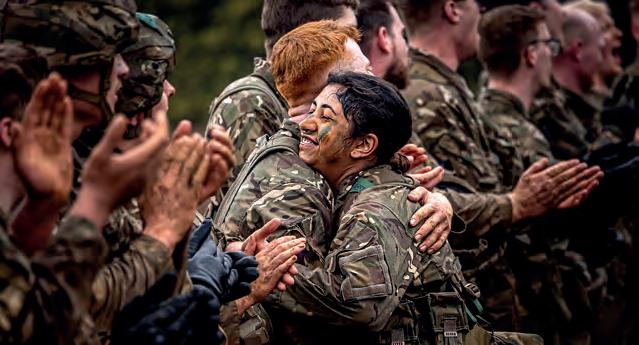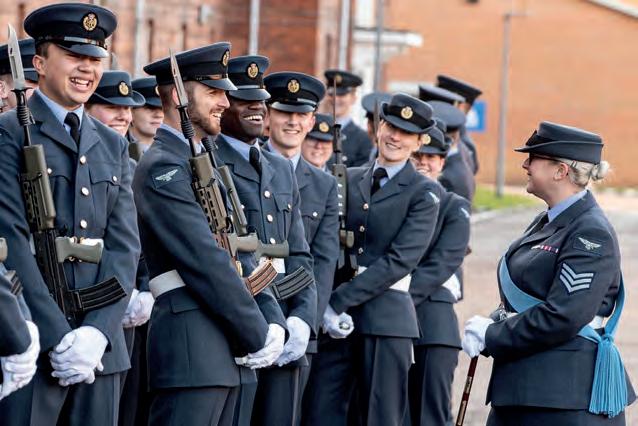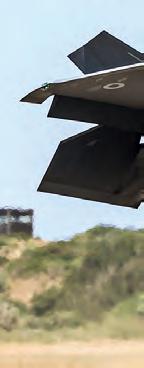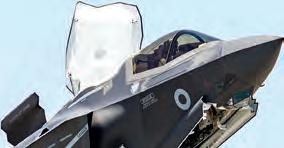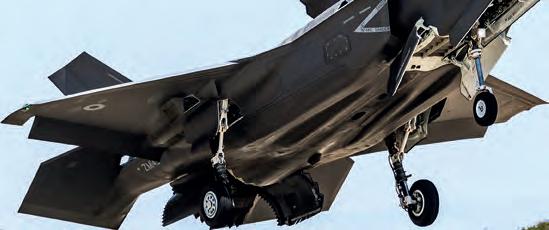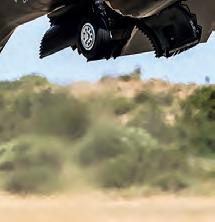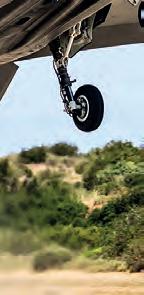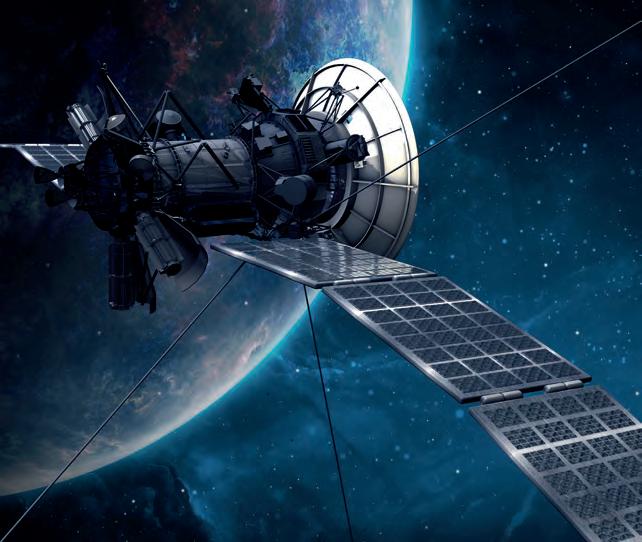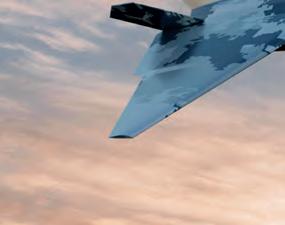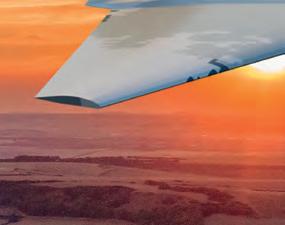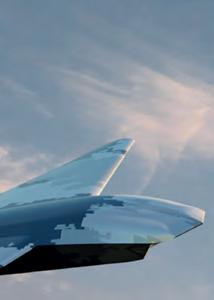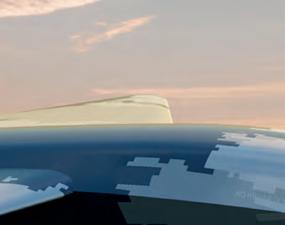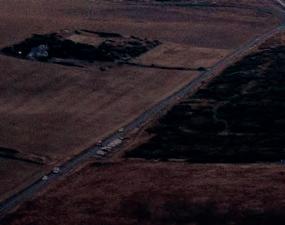Power 2025
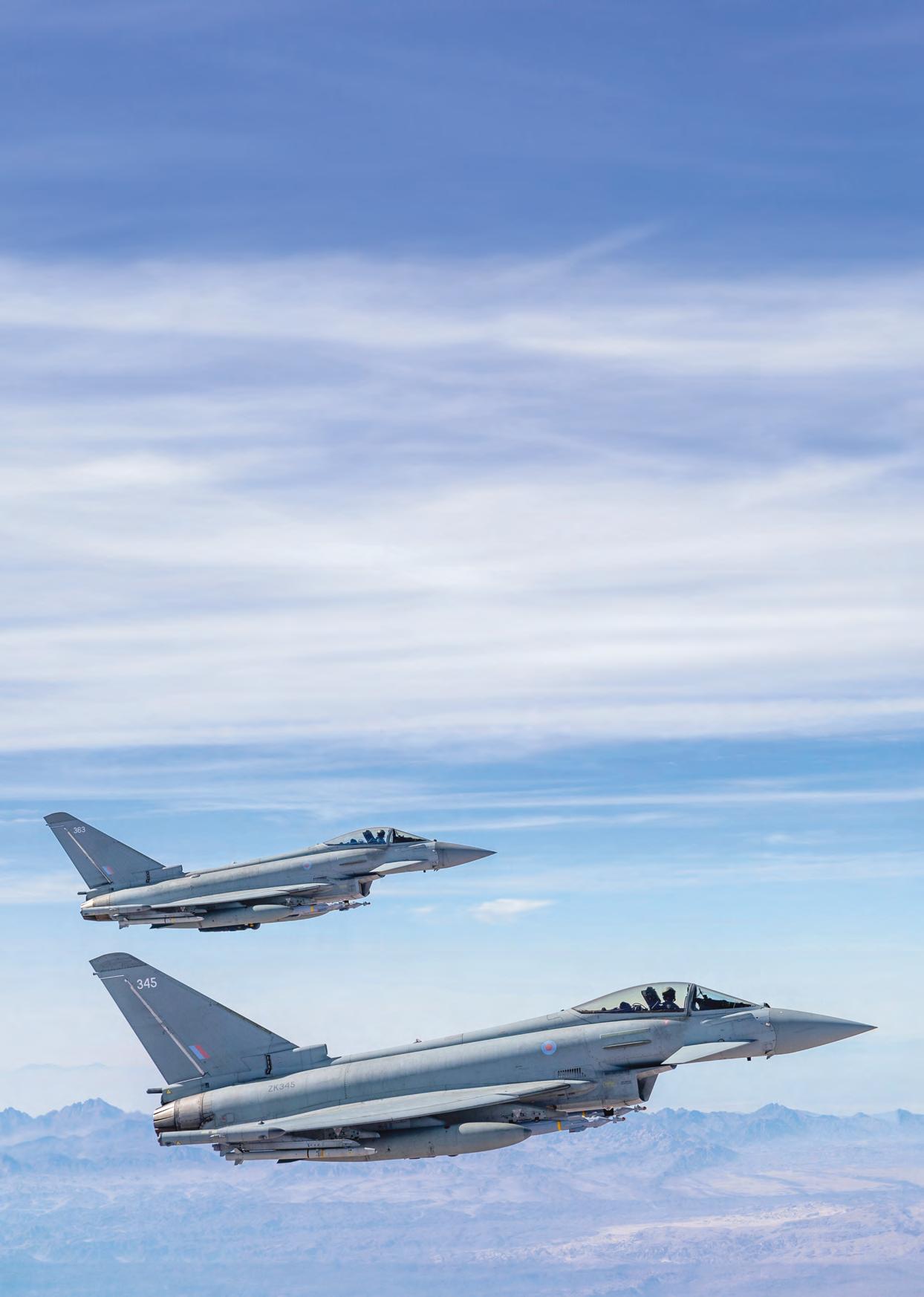
INTEGRATED AIR AND SPACE POWER IN THE EVOLVING BATTLESPACE
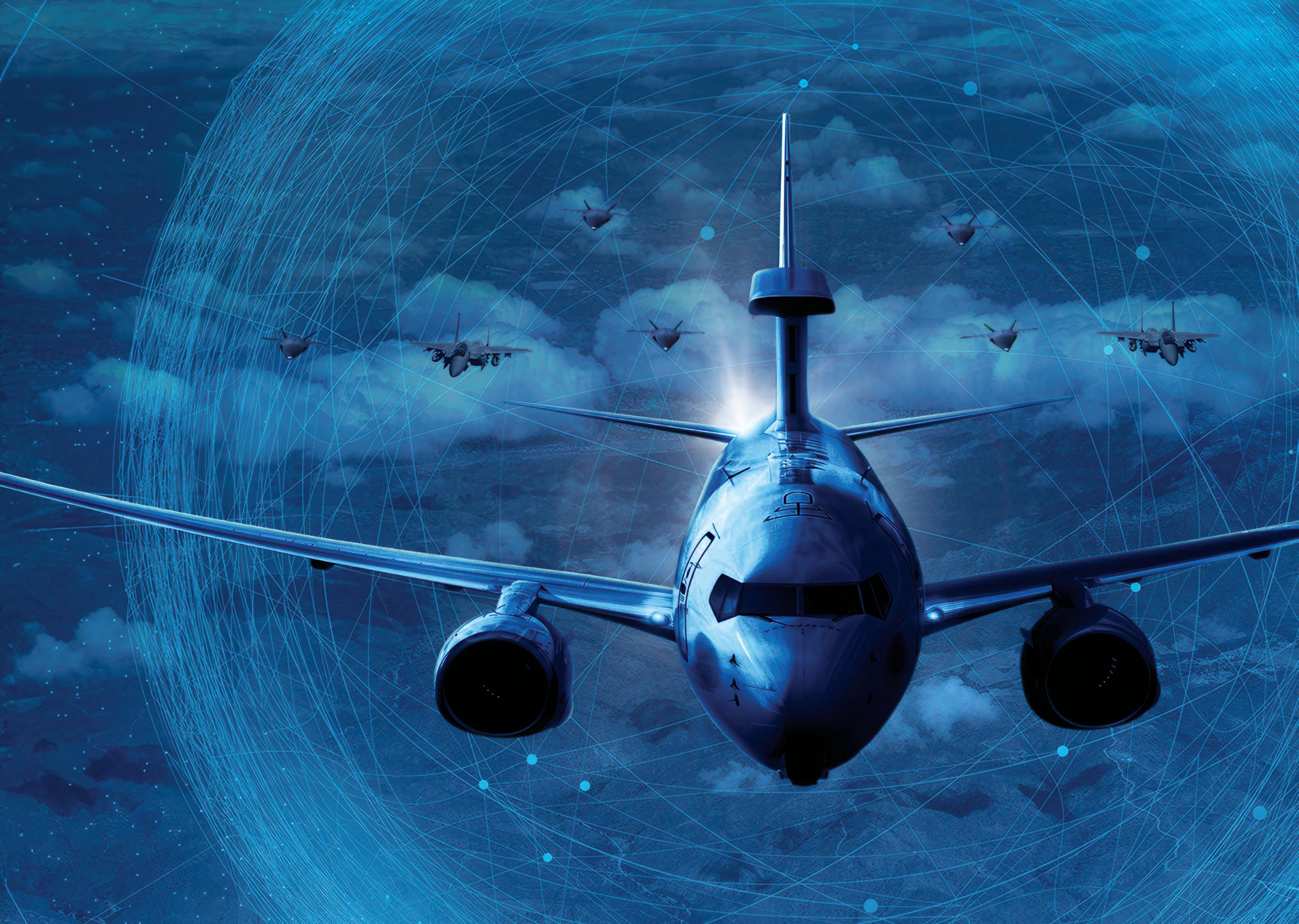

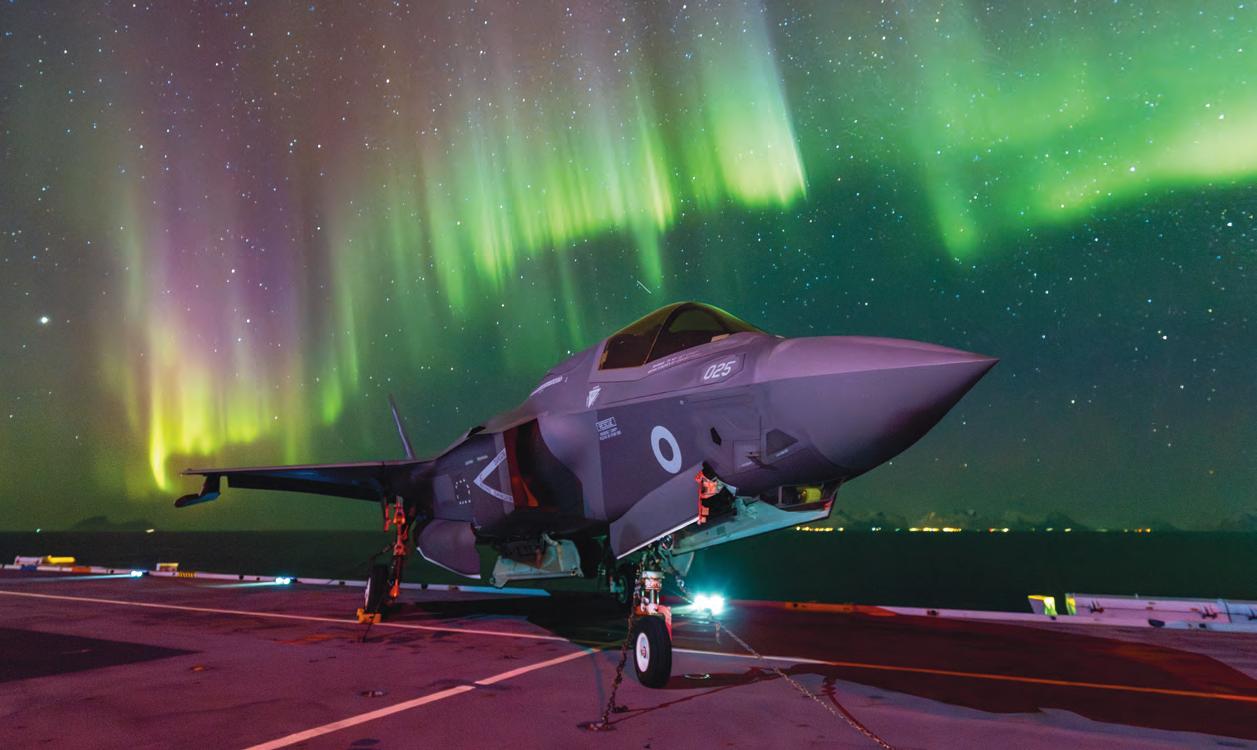
Ready to respond
Richard Hamilton, Managing Director Europe & International, BAE Systems, discusses the critical role that industry must play to respond to the ever-changing global threat and the importance of sovereign defence capability
Creating an F-35 culture
Lieutenant General André Steur, Commander of the Royal Netherlands Air and Space Force, highlights how the growing worldwide community of F-35 operators is creating an innovative culture of allies ready to ‘Fight Tonight’, ‘Fight Tomorrow’ and ‘Fight Together’
Integration – the right stu ?
Air Marshal Allan Marshall, the RAF’s Air and Space Commander, reveals how lessons from current con icts in Ukraine and the Middle East are helping the RAF to enhance its ability to defend the homeland and deliver operations overseas
Air Vice-Marshal Mark Flewin, Air O cer Commanding 1 Group (at time of writing), on the Typhoon Force’s readiness to deliver the UK’s Quick Reaction Alert tasking and ability to intervene at a moment’s notice
Air Marshal (Retd) Greg Bagwell, CB CBE FRAeS, President of the Air & Space Power Association, considers the advantages of integrating existing capabilities with tactics and innovation
Underhill:
airdrops in Gaza
Air Commodore Dan James, the RAF’s Air Mobility Force Commander, reveals the complexities of the aid operation to drop food and provisions to the people in Gaza and how it has evolved since the rst drop was made in March 2024
43
C-UAS at the Paris Olympics
Flight Lieutenant Ben Protheroe, Second in Command, 34 Squadron RAF Regiment, highlights the extraordinary Anglo-French collaborative e ort to counter drones during the 2024 Paris Olympic Games
46
Maximising cohesion and interoperability
Lieutenant General Simon Hamilton, Deputy CEO of Defence Equipment & Support (DE&S), outlines the organisation’s strategy for delivering integrated capability across air and space
48
52
Protector RG Mk 1 (MQ-9B) –introduction to service
The RAF’s ISTAR Force Commander, Air Commodore Nick Paton, o ers an update into the work being undertaken to introduce the Protector RG Mk 1 RPAS (MQ-9B) into service at RAF Waddington
UK air e ectors: now and the plan for the future
Air Commodore Alun Roberts highlights the requirement for a transformative planning and development roadmap in the crucial area of airlaunched missile systems and other air e ectors
55 The high-low weapons mix: a view from industry
Tom Wallington, head of the Air Domain for UK Sales and Business Development at MBDA, explains the opportunities that a high-low mix of weapons systems can deliver in terms of performance, time and cost
58
Spectrum warfare
Controlling, developing and using electro-magnetic technologies is one of the dark arts of modern warfare. Air Commodore Blythe Crawford, former Commandant of the Air and Space Warfare Centre, highlights the current status of the UK’s capabilities
Tomorrow – the changing character of war
62 The future operating environment
Air Vice-Marshal Mark Ridgway, Director Defence Futures, outlines the expected changes that will feature in the future operational environment and how UK Defence will need to adapt to address them
66
Creating the UK Defence space war ghter
As the UK continues to grow its space capabilities,
Air Commodore Jamie Thompson, Deputy Commander Space Command, highlights the qualities, aptitudes and expertise that the future space war ghter will need 70
Future control of the air
Air Vice-Marshal Jim Beck, the RAF’s Director of Capability and Programmes, outlines the future challenges in achieving control of the air and highlights the role that autonomous collaborative platforms and the NEXUS combat cloud might play 73
Ethics in global competition over military AI
James Black from RAND explains how advances in arti cial intelligence (AI) and related technologies are introducing complex ethical debates
76
Exploiting data to achieve control of the air
The RAF’s Director Digital, Dr Arif Mustafa, explains why the explosion in data acquisition and storage requires a step change in technological infrastructure and skill sets to ensure this huge resource can be used to gain operational and strategic advantage 78
The Strategic Defence Review –recognising industry’s key role
Kevin Craven, Chief Executive O cer of ADS, on how industry helped to formulate the Strategic Defence Review and will go on to support its implementation 82
Higher airspace operations
Brigadier General Alexis Rougier, general o cer in charge of very high altitude at the French Air and Space Force headquarters, considers a new strategic challenge for Defence – aerial vehicles capable of operating in the upper reaches of the atmosphere 86
Future infrastructure
Air Commodore Will Dole OBE, Head of RAF Infrastructure, explains the need for understanding, embracing and preparing for the changing character of war, so the RAF’s infrastructure can adapt in time
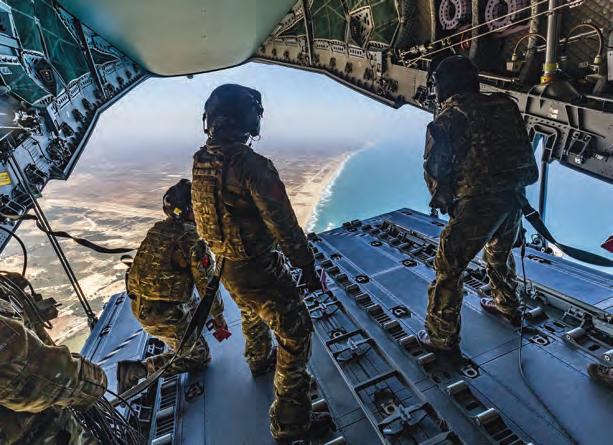
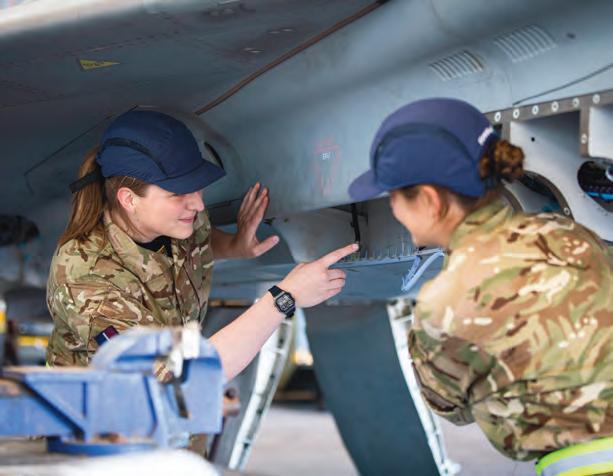
89 Ramstein Flag
Deputy Commander NATO Allied Air Command, Air Marshal Sir John Stringer, describes the purpose, ambitions and outcomes of this new training series, which rst gathered RAF Rivet Joint ISR aircraft and associated personnel in October 2024
92 Together – Pitch Black
Air Marshal Stephen Chappell, Chief of the Royal Australian Air Force (RAAF), explains why Exercise Pitch Black is the RAAF’s most signi cant ying activity for enhancing its ability to work with partners
96 Operation Highmast
Rear Admiral Anthony Rimington highlights the ambitious deployment of UK Carrier Strike Group 2025 to the Indo-Paci c alongside international partners
100 Recruitment and Retention: where next?
Air Vice-Marshal Simon Edwards, the RAF’s Director People and Air Secretary, on the impact of changes to the RAF’s Recruitment and Retention processes
104 Ukrainian ying training
Air Vice-Marshal Ian ‘Cab’ Townsend, the Air O cer Commanding 22 Group, explains Ukrainian pilots’ training with the RAF’s 22 Group and the signi cance of the RAF’s support to the Ukrainian Air Force
108 A resilient edge: RAF Reserves at the heart of the Whole Force
Air Vice-Marshal Ranald Munro, Commandant General of the Royal Auxiliary Air Force, lays out the steps required to achieve the RAF’s vision of an integrated organisation that comprises regular and reserve aviators alongside civilian and industry personnel
Air & Space Power 2025
INTEGRATED AIR AND SPACE POWER IN THE EVOLVING BATTLESPACE
Editor Simon Michell
Project Managers Gp Capt John Shields, Director Defence Studies (Air); Wg Cdr Amanda J Scarth, Deputy Director Defence Studies (Air)
Editorial Director Barry Davies
Managing Director Andrew Howard
Printed by Micropress
Front cover image: Cpl Nathan Edwards
Published by
Chantry House, Suite 10a High Street, Billericay, Essex CM12 9BQ United Kingdom Tel: +44 (0) 1277 655100
On behalf of the Royal Air Force Ministry of Defence Main Building, Whitehall, London SW1A 2HB, UK www.raf.mod.uk








Lifetime engineering
We approach everything with a broader perspective. Forging close and committed partnerships with our customers, to deliver defence engineering that creates their big picture. Resulting in assets that work. And work hard. Year after year.
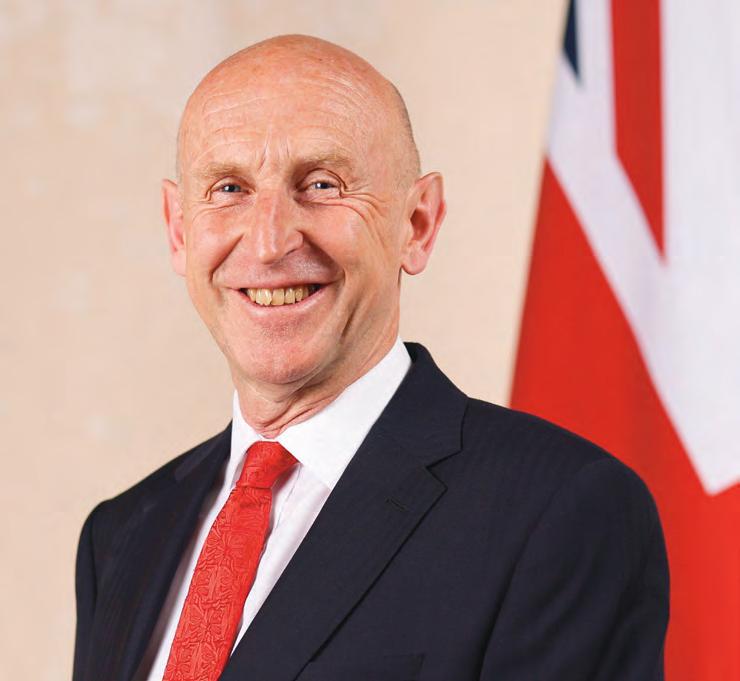
The Rt Hon
John Healey MP
Secretary of State for Defence
Making Britain safer: secure at home and strong abroad
Through the years, the RAF has defended the UK homeland, policed the skies above us and protected the Euro Atlantic with outstanding success and total professionalism.
Now our world is changing. The threat we face is more serious and less predictable than at any time since the Cold War. War in Europe, growing Russian aggression, emerging nuclear risks and daily cyber attacks at home. We are in a new era of threat, which demands a new era for UK defence.
The theme of this edition of Air and Space Power –integration in an evolving battlespace – is a timely one.
The recently published Strategic Defence Review (SDR) sets out a vision for the next decade and beyond for how UK Defence will transform to meet the challenges of a more dangerous world across every domain. In a landmark shift for
UK defence and deterrence, we are moving to war ghting readiness to deter threats and strengthen the Euro Atlantic. By committing the largest sustained increase in defence spending since the Cold War, we will end the hollowing out of our armed forces and, instead, lead in a stronger NATO.
The RAF gives us the capacity to strike anywhere, at any time. Yet – as the SDR states – over the next two decades, we and our allies will have to compete harder for air control and ght in a way not seen for over a generation, due to technological shifts.
With the return of state-on-state con ict in Europe, we must build greater war ghting readiness by exploiting the opportunities a orded by advanced technologies. The future of the RAF rests on adopting the latest innovation. That is why we will create the next-generation RAF, with F-35s, upgraded Typhoons and the Global Combat Air Programme.
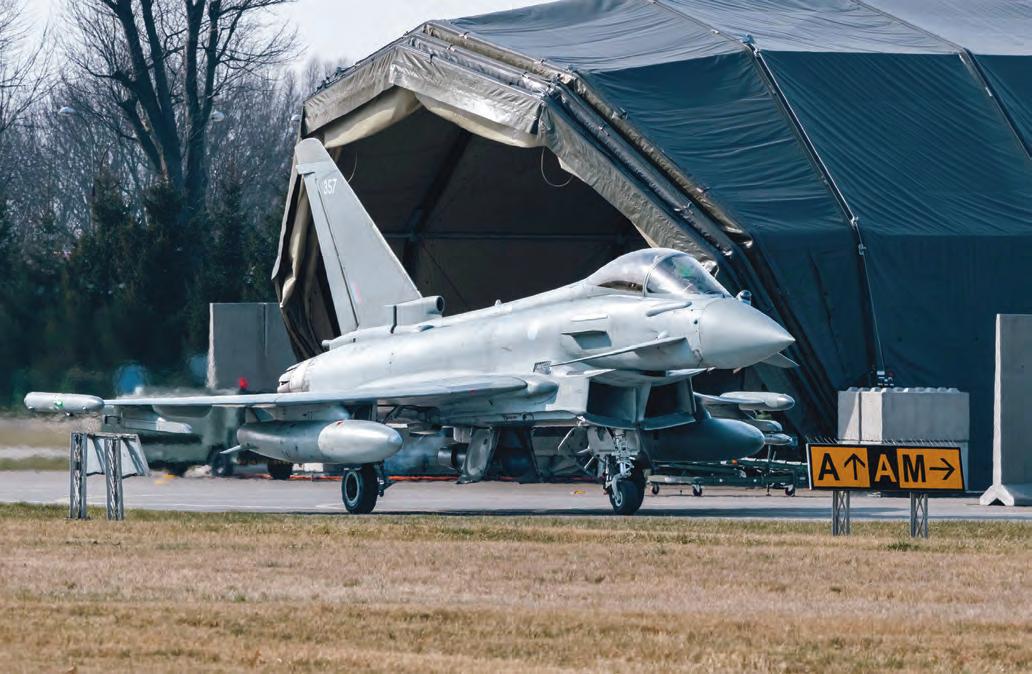
The RAF has consistently and unwaveringly responded to calls to action – be that patrolling the skies of the eastern European ank or protecting our home waters from malevolent actors (PHOTO: MOD/CROWN COPYRIGHT)
To match the changing nature of warfare, we will transition to a combination of crewed, uncrewed and autonomous platforms. The introduction of StormShroud marks the rst of a new family of Autonomous Collaborative Platforms, which will give the RAF the advantage in the most contested battlespaces. We will increase our resilience by improving existing infrastructure. And our armed forces will be more lethal than the sum of their parts by implementing an Integrated Force model.
An unshakeable commitment to NATO
The UK’s strategic strength comes from our allies. Our unshakeable commitment to NATO means we will never ght alone. That’s why our defence policy will be “NATO rst”. The war in Ukraine has taught us whoever gets new technology into the hands of their armed forces fastest will have the advantage. In response, we will place Britain at the leading edge of innovation in NATO by doubling investment into autonomous systems to £4bn this parliament, investing more than £1bn in an integrated Digital Targeting Web and nancing a £400m UK Defence Innovation Organisation. The SDR also begins a new partnership with industry, innovators and investors that will enable the UK to continually innovate at wartime pace. For members of our RAF, this will mean they receive the kit they need to protect our nation, when they need it. And for communities across the UK, the government’s increased defence investment will be an engine for growth, bringing a ‘defence dividend’ in support for British jobs, business and innovation.
The SDR rightly recognises space as a domain of growing competition and increasing importance. Nearly 20% of our national economy is reliant on satellite services, while both Russia and China are expanding their satellite eets and seeking to weaponise the domain. We will enhance the resilience and develop the capabilities of our military space systems. And space will be an important technology portfolio for the National Armaments Director.
Technology is vital, but an Air Force is nothing without its people. As Defence Secretary, every time I have called on members of the RAF to act – whether to strike against the Houthis in the Red Sea or protect our waters from Russian spy ships – they have not only met the moment, but risen above it. They do our nation proud. In return, we must do better by them.
The SDR places people at the heart of defence plans. And this government is committed to renewing the contract with those who serve. That is why we awarded personnel the largest pay rise in two decades and why we are investing more than £7bn to improve military accommodation this Parliament. And in the coming years, we will do more and more to recruit and retain talent.
Britain has always maintained air power by staying ahead. We have everything we need to succeed in this more dangerous world – innovative technology, advanced tactics and the very nest people. Now we must evolve once more to make Britain safer: secure at home and strong abroad.






delivering game-changing capability across the raf
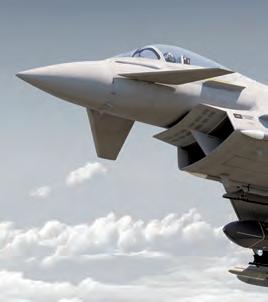
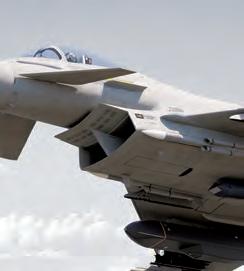





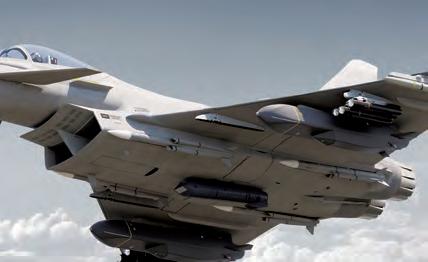



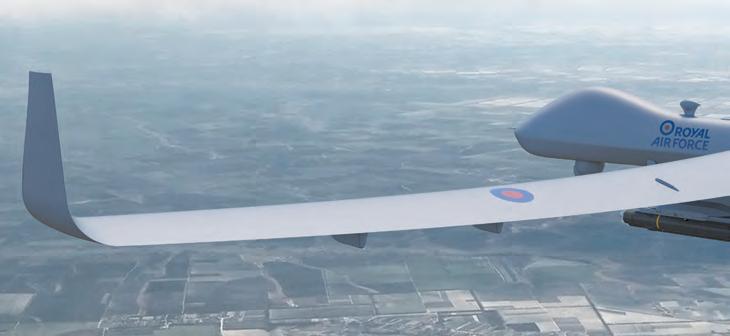
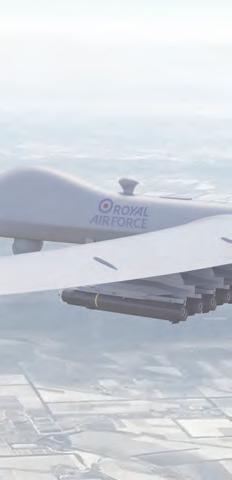
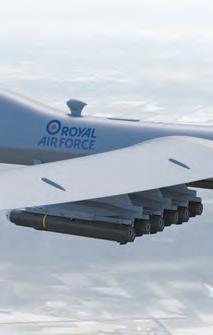
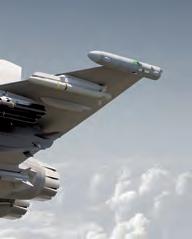





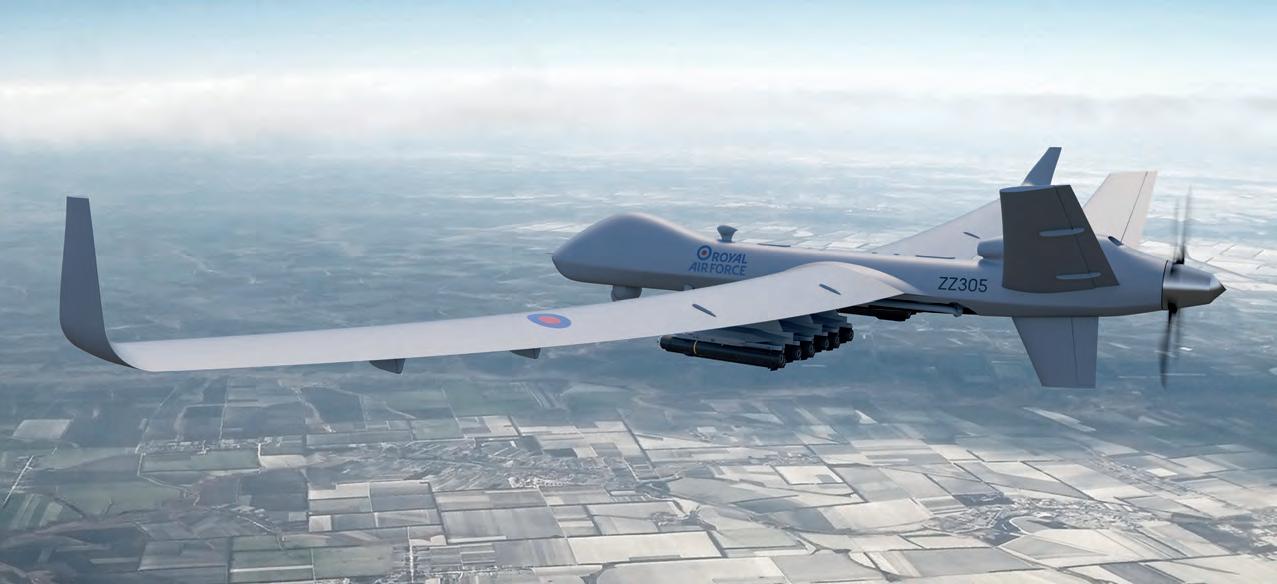



Our commitment to the Royal Air Force


The Royal Air Force faces increasingly complex engagement scenarios where there is no room for error. In this demanding environment you can count on our expert teams who are committed to bringing you cutting-edge, sovereign, combat-proven technology. ASRAAM, Brimstone, Storm Shadow, Meteor & SPEAR family are capabilities the RAF can rely on to meet the operational needs of the modern battlespace.




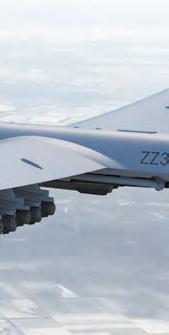


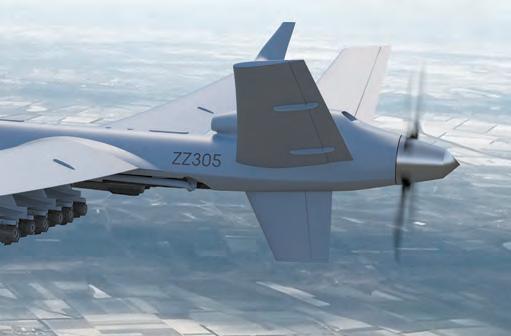


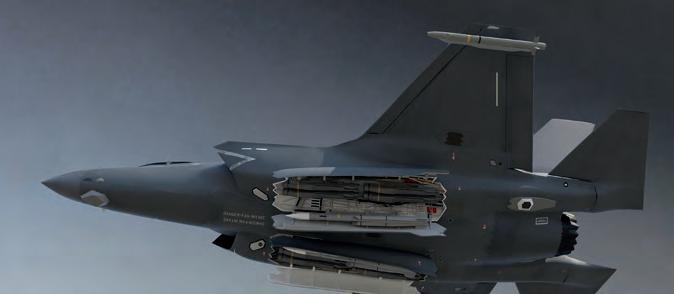











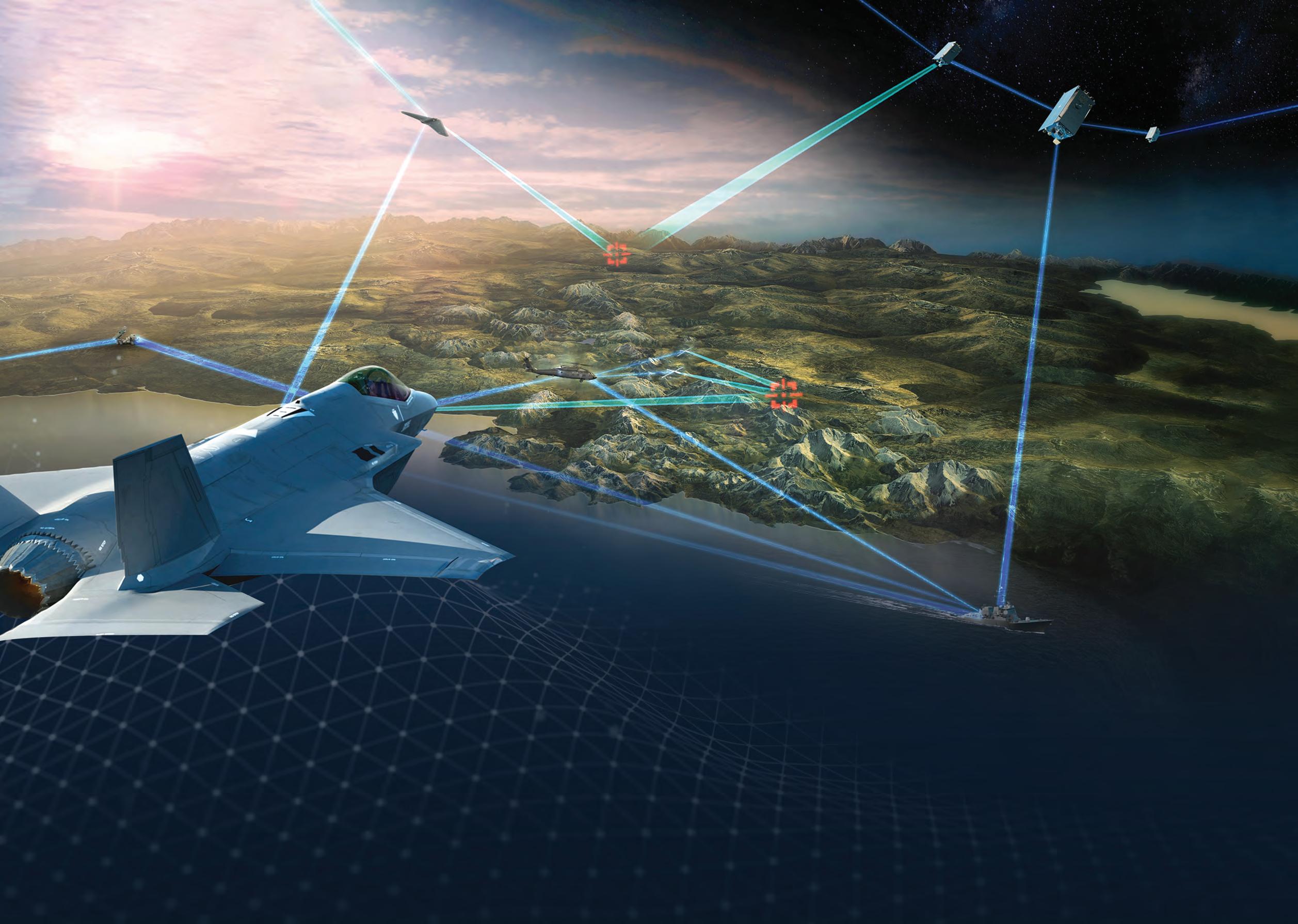
SEEING THE BIG PICTURE MEANS CONNECTING EVERY DOMAIN
The future battlespace calls for future-forward solutions.
Whether the battle takes place over land, on the sea, through the sky, in space or across cyberspace, the F-35 partner team of Lockheed Martin, BAE Systems, Northrop Grumman and RTX keeps you connected across every domain to help protect what matters the most.


Training solutions

Taking training to the next level –taking your people to their highest level

International turnkey solutions for mission-critical aircrew training


Come and see us and our UKMFTS training aircraft at the Royal International Air Tattoo

Design Develop
Deliver





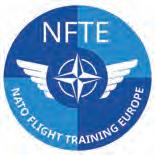
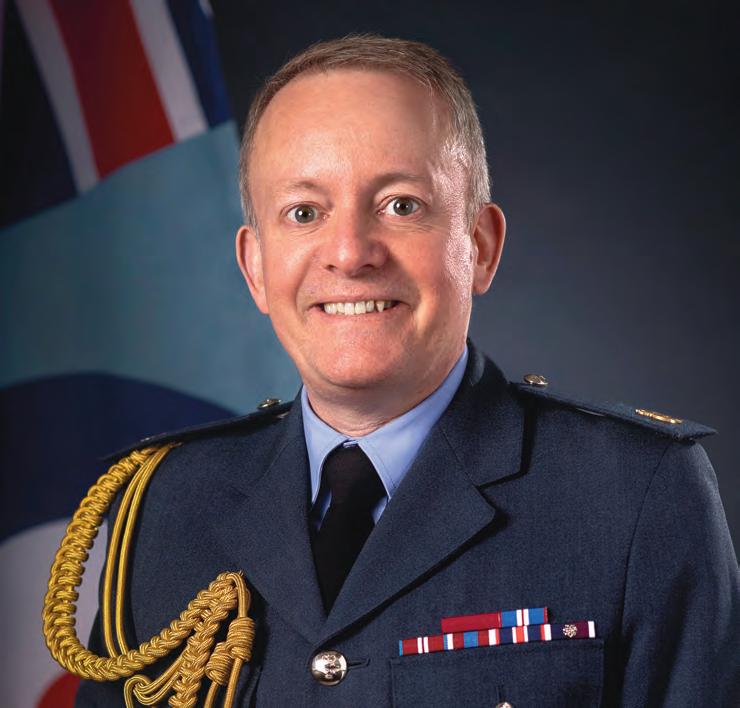
Air Chief Marshal Sir Richard Knighton
KCB ADC FREng, Chief of the Air Sta
Today, Tomorrow and Together
Welcome to this, the 2025 edition of Air and Space Power, the theme of which is integrated air and space power in the evolving battlespace. This is an opportune moment to consider the need for even greater levels of integration in the air and space domains. We only have to watch our news outlets or look at social media feeds on a daily, if not hourly, basis to realise that the world is changing rapidly around us.
The threat we face today is palpable. However, the combined strength in both the quality and quantity of allied air power provides e ective deterrence and campaign-winning options for our collective security. It is the enduring need to integrate these constantly changing capabilities that delivers competitive advantage beyond the sum of its parts and demonstrates
allied cohesion. Consequently, as the nation’s rst responders, it is vital that we invest time, money and e ort to continually integrate air and space power to harness that strength and deliver the required e ects today, tomorrow and together.
Today
In 2025, the world remains a volatile place. Over the last 30 years, we have enjoyed the peace dividend born out of a Cold War victory and a focus on counterinsurgency operations, ghting far from home, with a secure home base, no existential threat to our nations, and with limited impact on the national purse. Today, we face multiple and multiplying threats. War has returned to the European continent, instability endures in the Middle East, and the US’s pivot to the Indo-Paci c
and its hard rhetoric are now unambiguous. The world has changed, and great power competition is back on the agenda. As the UK Prime Minister, Sir Keir Starmer, said recently:
“We must recognise the new era we are in, not cling hopelessly to the comforts of the past.”
Now, more than any other time in our careers, air and space power is needed to secure our nation, our interests and our way of life.
Tomorrow
Today’s RAF is the most modern and most capable it has ever been. Over the last decade, we have seen a major recapitalisation of our front-line capabilities. World-class capabilities, such as the F-35B Lightning, A400M Atlas, P-8 Poseidon and RC-135W Rivet Joint have all joined the front line, working alongside the combat-proven multi-role capabilities of Typhoon.
While the RAF will soon add E-7 Wedgetail and Protector to that front-line portfolio, there are no major equipment programmes planned for the next 15 years. We have what we have for the near and medium term. To stay ahead of the threat, we must continue to adapt and innovate to maximise our lethality. This is a de ning moment for our generation, but our nation and its allies and partners have been here before, and we are not starting from scratch. As the Italian air power theorist, Giulio Douhet, stated:
“Victory smiles upon those who anticipate the change in the character of war, not upon those who want to adapt themselves after the change occurs.”
We must continue to develop, deliver and eld campaign-winning air and space power capabilities that our allies and partners admire and our enemies fear. We have a eeting opportunity to make the necessary changes.
Together
We cannot do it alone. Air and space power are team games; they always have been, and it remains true both for today and tomorrow. In 2024, the RAF operated alongside 44 partner
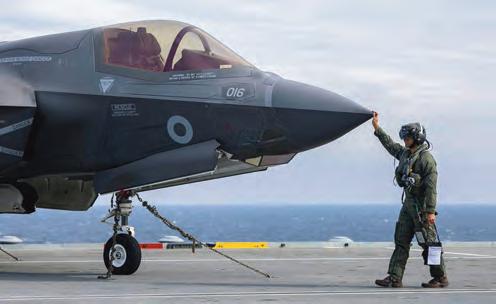
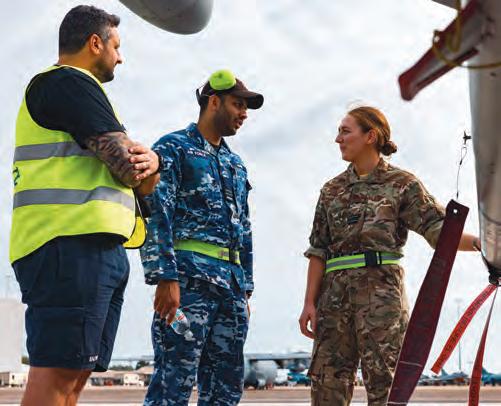
nations. We continue to work together tactically, operationally, strategically and politically. In Australia last year, we put the sage advice of Adolf Galland, the German ghter ace, into practice:
“One of the guiding principles of ghting with an air force is the assembling of weight, by numbers, of a numerical concentration at decisive spots.”
The RAF deployed 8,500 miles to Northern Australia to participate in Exercise Pitch Black – a three-week largeforce employment exercise. We worked alongside 20 allied nations with over 140 aircraft and 4,500 personnel. This is only one of many exercises that we can exploit to enhance our ability to work together. Interoperability is more than just an overseas exercise; it is about a multitude of factors that we can bring to bear to make us y and ght better together. By working together, from aircraft cross-servicing to exchange tours to multinational procurement programmes, we create greater interoperability and provide ourselves with a greater chance of success in future con icts. We must remain integrated into one team to meet the challenges of the evolving battlespace. It is a never-ending quest for excellence.
Throughout the pages of Air and Space Power 2025, the challenges and opportunities will be explored in more detail. I hope it stimulates ideas, leads to debate and tangible concepts of how we can integrate more e ectively. As Antoine de Saint-Exupéry, the French WW2 combat pilot, said:
“The time for action is now. It’s never too late to do something.”
We have the capability, the intent, the opportunity and, most importantly, the need to strengthen and focus what we have. Now is the right time to do something. I look forward to engaging with those responsible for developing, delivering and sustaining global air and space power today, tomorrow and together. Fight’s on!
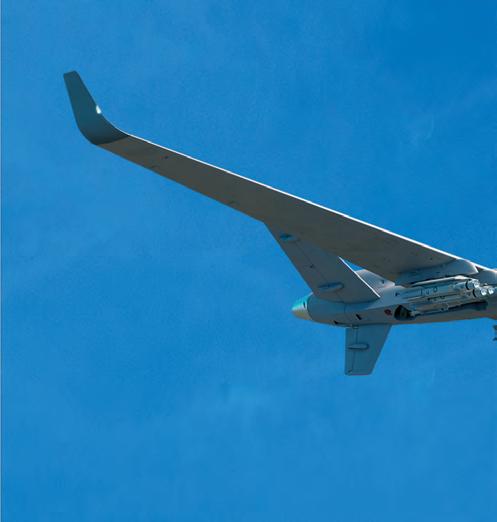

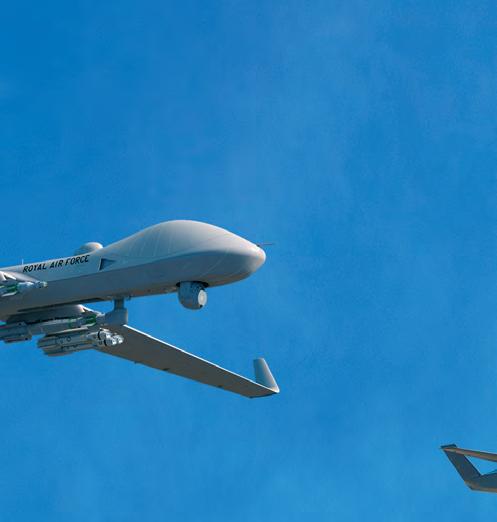
POWERING RPA INNOVATION FOR THE WORLD’S TOUGHEST MISSIONS
We deliver remotely piloted aircraft innovation powered by experience, ingenuity, and performance — backed by world-class partners.
This means unmatched pole-to-pole strategic armed ISR from the multi-mission, longendurance Protector. For maritime requirements, a short takeoff and landing kit brings Airborne Early Warning capabilities to aircraft carrier operations in the form of Sea Protector. And for the best all-domain awareness deep within the battlespace, look to our jet-powered Gambit Series Autonomous Collaborative Platforms.

These next-gen solutions deliver affordability at scale for any mission anywhere. And they’re ready today.
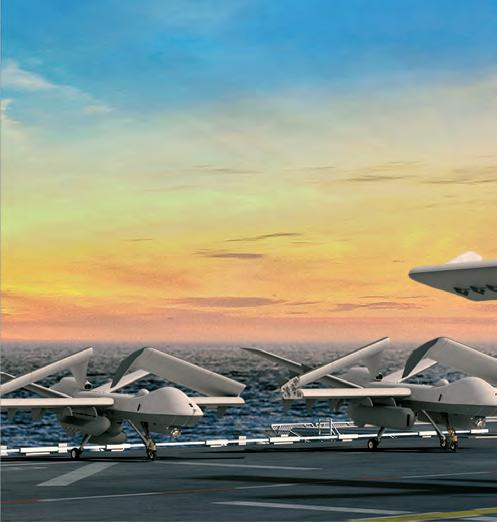

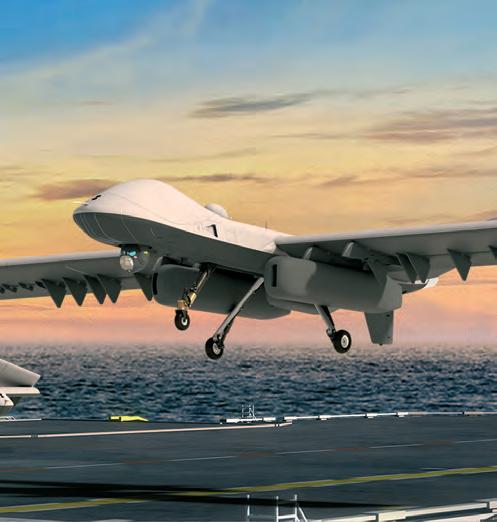

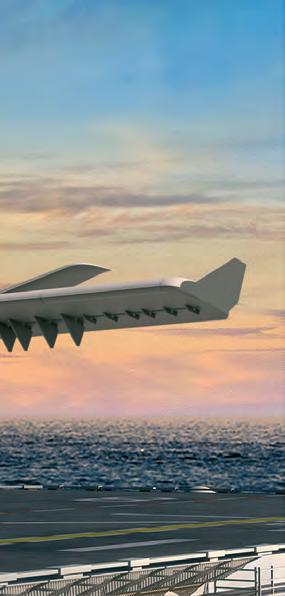
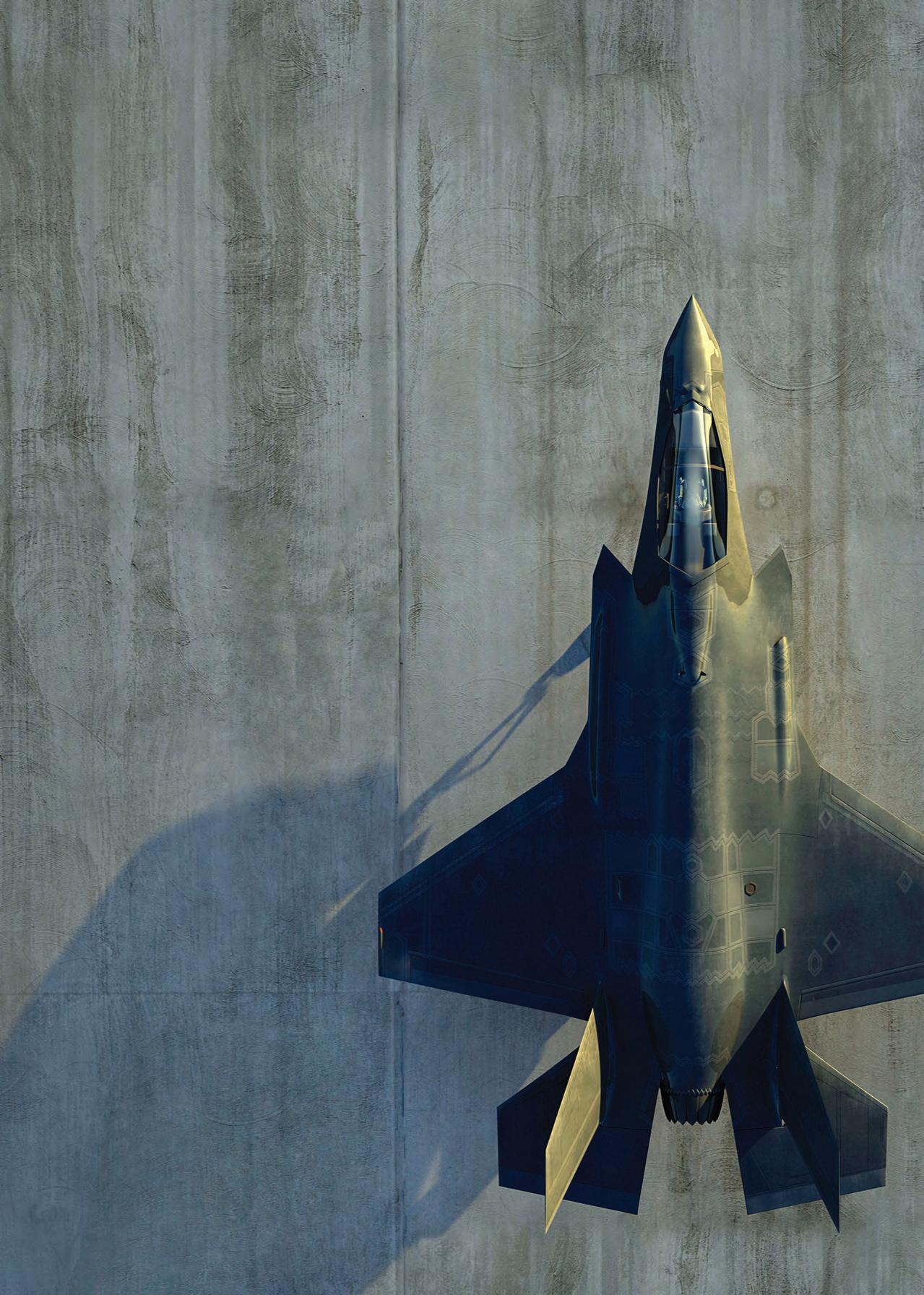
With an unparalleled range of solutions – from networked platforms to advanced sensors and thermal management – weʼre equipping pilots with a distinct advantage, before the mission even begins.
Learn more at rtx.com

Simon Michell
Editor, RAF Air & Space Power 2025: Today – Tomorrow – Together
Facing multiple and multiplying threats
The purpose of the RAF Air & Space Power publication is not only to inform the readership about the RAF’s activities, but also to stimulate new ideas by delivering trusted information that enables informed discussion. Never in my lifetime has this been more important. In his foreword to this issue, the Chief of the Air Sta , Air Chief Marshal (ACM) Sir Richard Knighton, points out that as a nation and a founder member of NATO we face, “multiple and multiplying threats”. With a brutal and extraordinarily destructive war now taking place on European territory, the days of the peace dividend are well and truly over. In the words of the new NATO Secretary General, Mark Rutte, “We are not at war, but we are not at peace either”.
Fight Tonight, Fight Tomorrow, Fight Together
As the UK’s rst responders, the RAF is now being asked to patrol European skies from the arctic to the Mediterranean –an onerous task that is expertly explained by Air Vice-Marshal (AVM) Mark Flewin in his article on ‘Typhoon – long-range rst responders’. For the RAF, the Typhoon bears the heaviest burden in this tasking, but as the F-35 eet continues to
grow across the UK, Europe, the US and the Indo-Paci c, the Lightning is becoming absolutely critical to the defence of the western world. The Commander of the Royal Netherlands Air and Space Force, Lieutenant General André Steur, o ers an intriguing glimpse into the growing F-35 community and reveals how it is creating an innovative culture of allies ready to ‘Fight Tonight’, ‘Fight Tomorrow’ and ‘Fight Together’.
As instability in the Middle East threatens to spill over into the wider region, the con ict in Gaza highlights the need to be able to deliver humanitarian aid into contested and potentially hostile areas. Air Commodore (Air Cdre) Dan James’s fascinating article on how the RAF and partner air forces managed to drop food and medical supplies onto tiny strips of the Gazan Mediterranean shoreline is both inspiring and alarming.
It is proof, if proof were needed, that today’s con icts impact the civilian population as hard, perhaps even harder, than they impact the military. Ukraine is another example of this. Russia continues to target civilians in their homes and while they go about their daily activities. In truth, in today’s wars, nowhere is safe.
The drone-centric nature of the Ukraine con ict shines a light onto an evolution in warfare that no defence ministry can
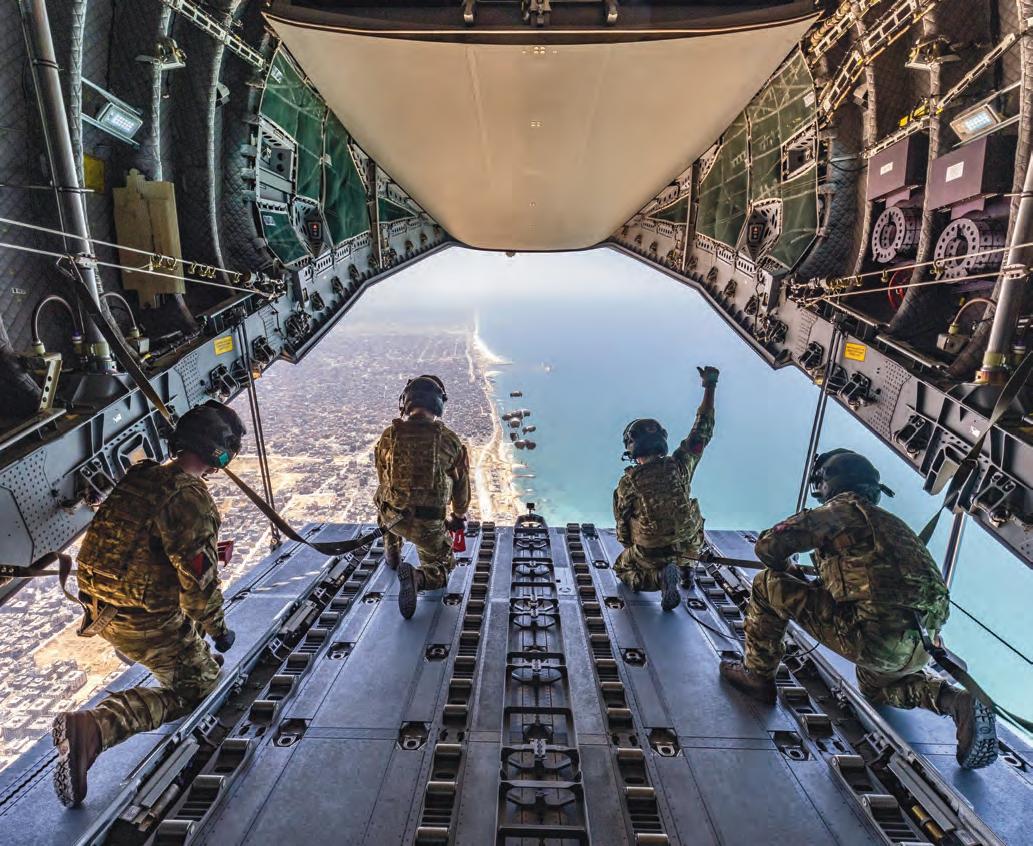
The RAF’s ability to deliver humanitarian aid in times of crisis is a justi able source of pride (PHOTO: MOD/CROWN COPYRIGHT)
a ord to ignore. The battle of the drones highlights, in undeniable terms that, at times and in certain areas, control of the airwaves is equally as important as control of the air. This is critical, as AVM Jim Beck explains in his article on ‘Future Control of the Air’.
The established expectation that the RAF and its allies would enjoy air superiority in future con icts is an outdated notion. Control of the future airspace during times of con ict is likely to be local and eeting. Likewise, control of the airwaves will be di cult to achieve and retain. Air Cdre Blythe Crawford, former Commandant of the RAF’s Air and Space Warfare Centre, writes in his piece on ‘Spectrum Warfare’, “Whoever owns the spectrum, owns the battle eld. Essentially, those who are not adept at, and continually adapting and innovating, electronic countermeasures and spectrum warfare will always be on the back foot. This is a form of combat that needs to be at the very heart of every military capability.
Sharing future vision
The Chief of the Air Sta ’s Global Air and Space Chiefs’ Conference is at the forefront of cohering partner air forces and sharing ideas, concepts and future vision. As ACM Knighton reminds us, “We must remain integrated into one team to meet the
challenges of the evolving battlespace.” The emergence of a new exercise, Ramstein Flag, is testament to the continuing e ort to ratchet interoperability between allies up a notch.
At the other end of the world, another exercise – Pitch Black, which has been going for over 40 years – highlighted Australia’s strategy of ‘Denial’. Both exercises are covered in detail in this issue. Moreover, we are indebted to the Chief of the Royal Australian Air Force (RAAF), Air Marshal Stephen Chappell, for his excellent article on Pitch Black, as it not only explains Australia’s inaugural National Defence Strategy, but also how exercises like Pitch Black support and drive that strategy.
What these exercises also highlight is that an alliance of like-minded nations should always seek to nd new friends and welcome potential partners. The training of Ukrainian F-16 pilots by a coalition of the willing is a prime example of this.
Air Vice-Marshal Ian ‘Cab’ Townsend, the Air O cer Commanding the RAF’s 22 Group, highlights the e orts that the international community is making to help Ukraine defend its territory and airspace against a callous and brutal opponent. It is also an example of how the RAF, in particular, is ready to ght today, tomorrow and together.
The latest generation engine for latest generation fighter aircraft
The demands of military aviation in the 21st century leave no room for compromise – or outdated solutions. With cutting-edge technology and unrivalled build quality, the EJ200, installed in the Eurofighter Typhoon, has proven time and again to be the best engine in its class. To find out more about our market-leading design and unique maintenance concept, visit us at www.eurojet.de
The EJ200: Why would you want anything less?
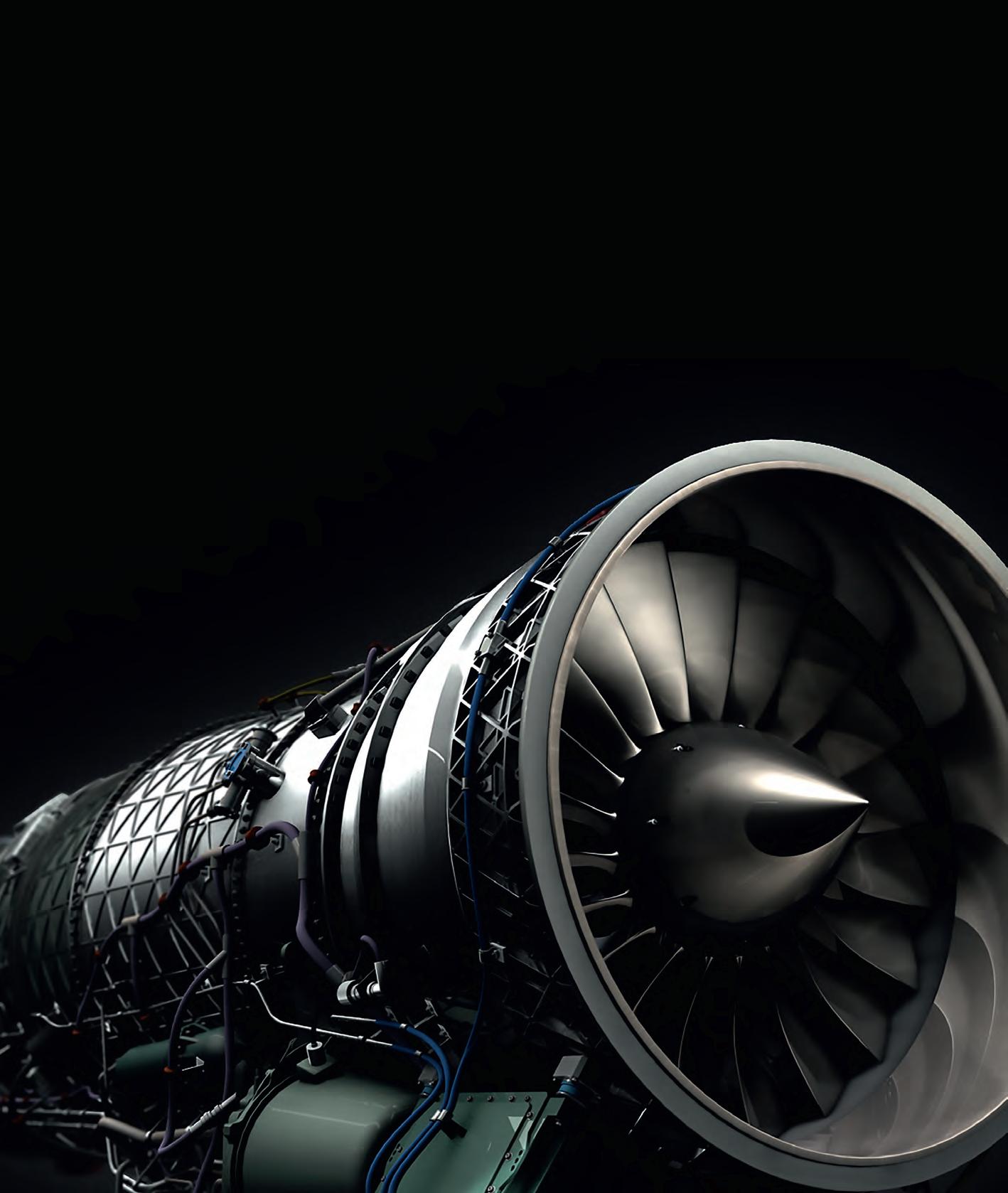











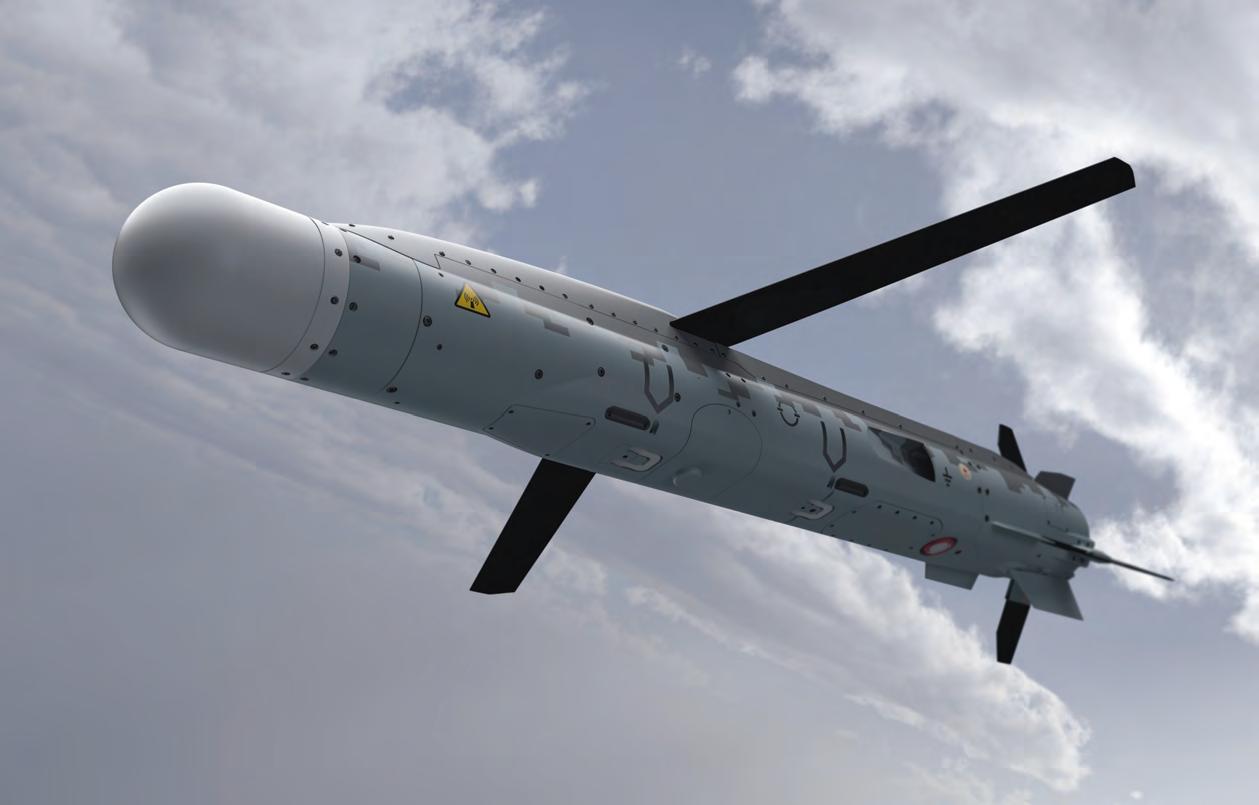
Contemporary lessons of air power
Air Marshal Allan Marshall, the RAF’s Air and Space Commander, reveals how lessons from current con icts in Ukraine and the Middle East are helping the RAF to enhance its ability to defend the homeland and deliver combat and humanitarian operations overseas
TUncrewed systems, such as the SPEAR-EW airborne jammer (pictured), are now core e ectors on the battle eld and beyond
(IMAGE: MBDA)
he modern geopolitical context and recent con icts – from Ukraine to the Middle East and beyond – o er a wealth of insights and lessons across all war ghting domains. From an air power perspective, few of these are entirely new. However, many have been reinforced; the pace of technological change has outstripped expectations in several areas, and we are reminded of fundamentals that have somewhat fallen into abeyance due to the bias towards expeditionary operations in largely uncontested airspace over previous decades.
What is clear is that contemporary con ict has reasserted the pivotal nature of air power, which continues to deliver substantial e ect across all of its doctrinal roles. Among the plethora of lessons
available, this article will focus on some insights that are likely to shape future thinking on air power. Critically, it opens with an enduring lesson and a stark reminder of how wars unfold in the absence of control of the air.
Control of the air remains foundational, but is becoming more complex to achieve Control of the air has long been a prerequisite for joint operational success. It allows unhindered operation of air, land and maritime forces, providing signi cant advantage. The con ict in Ukraine serves as a clear case study to this e ect, where the inability of either side to truly control the air has severely impacted ground manoeuvre, reduced survivability and resulted in a relatively static and
highly attritional con ict. This lesson should serve as a clear reminder that control of the air is not just foundational for air forces, but across all domains. With increasingly sophisticated air-defence networks, proliferated sensors, longer-range e ectors, rapid advancements in uncrewed systems and a testing electromagnetic environment, achieving control of the air is becoming increasingly challenging. Adversaries are adapting quickly: developing technologies, integrating uncrewed systems and harnessing a wide array of sensors and data. Ensuring our decision advantage is therefore essential, and maintaining an overall advantage will demand relentless focus. Finally – and it has been said before –it may be necessary to accept that assured control of the air may only be achievable on a temporary basis in time and space, rather than on a persistent basis.
Uncrewed systems are increasingly ubiquitous, e ective and central
The rapid proliferation and technological development of uncrewed systems has already had a signi cant impact on the air environment. No longer novel or peripheral, these systems are now core e ectors conducting ISR (intelligence, surveillance and reconnaissance), strike, electronic attack, deception, communications and more. The rapid development cycles alongside the a ordability and adaptability of uncrewed systems have made their employment appealing across the full spectrum of con ict. These factors have also somewhat ‘democratised’ the delivery of air power, a ording non-state actors access to a level of e ects previously only accessible to nation states. This proliferation provides defensive dilemmas in terms of countering such systems, as can be seen in Ukraine, where hypersonic weapons are integrated into the same attack as very low-cost systems in signi cant volume. There is also a necessity to counter uncrewed threats without expending expensive exquisite munitions. This will likely result in our use of uncrewed systems in a high-low defensive capability mix.
Concurrently, our air forces must also harness uncrewed technology to maintain operational advantage, delivering our ISR and o ensive e ects with creweduncrewed teaming, autonomous mission execution, and exploiting the potential to mass large swarms.
The importance of electronic warfare and spectrum dominance
Over recent decades, which were dominated by expeditionary warfare and a focus on counterterrorism, electronic warfare (EW) development and expertise was deprioritised in many nations. However, recent con icts with a higher level of contestation in the air have reminded
us of the criticality of this area of military business. The density of the electromagnetic environment in areas of Ukraine is beyond anything seen in previous con icts, severely challenging situational awareness and the ability to both defend and deliver o ensive e ect. From disrupting GPS signals to denying radar and C2 networks, spectrum operations directly impact mission success. The ability to jam, deceive or deny adversary systems is proving decisive; hence the ability to understand, operate within and a ect the EW environment is fundamental and a worthy priority for any air force.
Air defence alone is insu cient
The contemporary environment has seen air attack used routinely to disrupt, defeat, deter and/or coerce, including near-nightly attacks against Ukraine and episodic strikes within the Middle East. The breadth of the air-defence system that Ukraine has developed, ranging from mobile machine-gun teams through to Patriot missiles, combined with images demonstrating the impressive performance of Israel’s defensive systems, focuses the mind on the requirement for such capabilities. Many nations are prioritising enhancement in Integrated Air and Missile Defence (IAMD); however, there is risk that this investment comes at the cost of the ability to deliver o ensive action to deter adversaries from launching or persisting with such attacks. So, while robust air defences are evidently necessary, on their own they are not enough to ensure strategic stability or operational success.
Israel’s Iron Dome air-defence system is an example to be emulated (PHOTO: DPA PICTURE ALLIANCE/ALAMY)
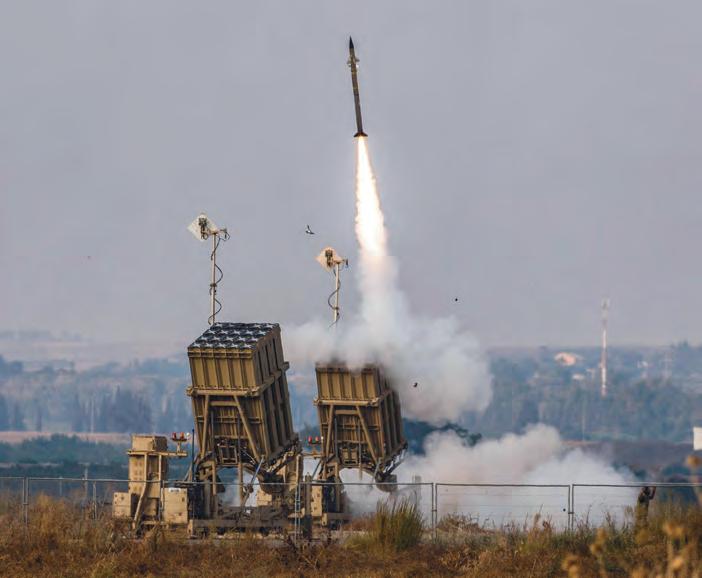
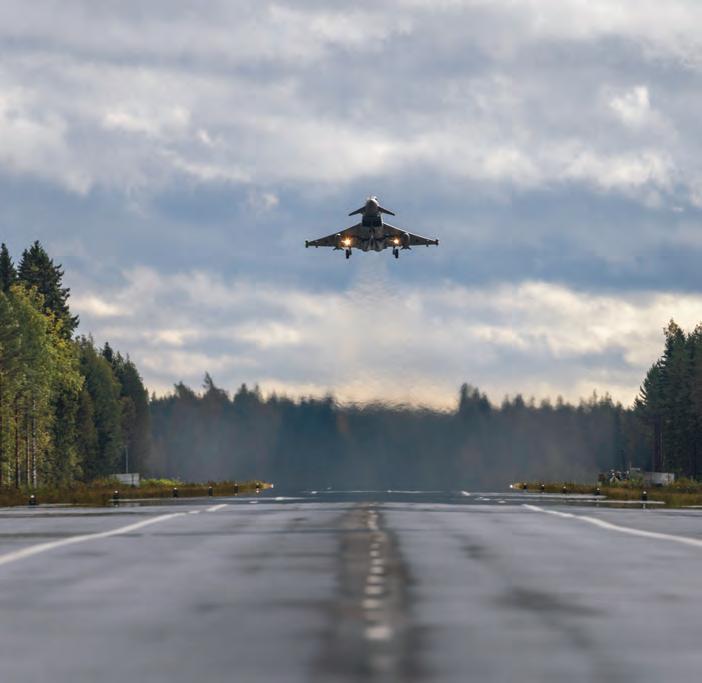
Agile Combat Employment skills are required in every modern air force (PHOTO: MOD/ CROWN COPYRIGHT)
Massed drone and missile attacks can overcome or rapidly exhaust even advanced defensive systems, either through the scale of a single attack or the erosion of defensive stockpiles over time. Credible deterrence relies on the ability to impose cost, disrupt momentum and shift initiative – ie to ‘shoot the archer’ and not just to defend. The roles of strike, o ensive counter-air and suppression of enemy air defences therefore remain essential and must attract a healthy balance of investment.
The prevalence of adversary air attacks of recent years also reminds us to look to the past for best practice in terms of resilience and agility in war ghting. Camou age, concealment and dispersal are rightly back in vogue, and while airbases remain relatively resilient and can be repaired, modern air platforms appear to be becoming increasingly fragile and cannot as easily be repaired or replaced following damage or loss. The focus on Agile Combat Employment, across Europe and beyond, is therefore a necessity.
Endurance, stockpiles and scale matter
Recent experience has revealed that many modern forces lack the depth and resilience to sustain hightempo operations over time. Munitions shortages, limited spare parts and wider fragility have emerged as critical limitations, and the ability and timescales
for reactive replenishment from industry have often neither met assumptions nor demand. The rate and overall scale of munition usage in the Ukraine con ict, now over three years in, provides a salient reminder of the depth of magazine required, and highlights the unwelcome reality that wars often last longer than convenient assumptions might suggest.
Lessons about sustainment and resilience are far from new, but there remains a tendency for planners to focus on the opening stages of con ict, rather than the enduring campaign. Investment in an ability to endure is expensive and does not routinely have the appeal to generate political and public interest. However, it is non-discretionary and a determinant of strategic credibility and successful deterrence –therefore, sustainment deserves re-energised focus.
Integration – joint, international and industrial
Air power’s e ectiveness increasingly depends on its ability to operate seamlessly across all domains and with a broad spectrum of partners. Integration is required not only between air, land, maritime, space and cyber capabilities, but also across international and industrial boundaries. Synchronised operations enhance tempo and generate combined e ects greater than the sum of their parts.
Internationally, partnerships and alliances enable burden-sharing, aggregation of forces, collective deterrence and much more. Equally necessary is integration of defence industry, into planning cycles and capability development to ensure timely delivery and sustainment of cuttingedge technology. Adversaries are actively exploiting seams – whether between domains or nations, or within supply chains – making it essential that air forces are fully integrated from the outset. This is a strategic imperative that must be embedded in mindset, planning, procurement and practice.
Air and space power’s critical role
The contemporary operating environment has rea rmed air power’s critical role, while highlighting the need to adapt to evolving threats and technologies. Control of the air remains essential, but will require signi cant and persistent e ort to maintain advantage within an increasingly contested environment. The rise of uncrewed systems, the resurgence of electronic warfare and increased availability and exploitation of data must all be embraced, exploited and defended against. Crucially, resilience, agility, the ability to sustain operations and further integration in its many forms must also be prioritised to assure both deterrence credibility and war ghting success. These are not theoretical lessons – they are unfolding in real time.
Strengthening defence

Simon Barnes Managing Director, BAE Systems Air
Has the changing geopolitical environment changed the way in which you operate?
Yes, today’s uncertain world has underlined the importance of the partnerships we have with all our customer air forces. We take seriously our responsibility to meet the changing threat environment and evolve the range of products and services we o er to match our customer needs, and it is through our partnerships that we can do this e ciently and e ectively.
As an example, our response to NATO requirements in Eastern Europe saw us working alongside the RAF to bring forward immediate upgrades to its Typhoon eet, ensuring it has what it needs to remain the backbone of NATO’s response to Russian aggression.
As the war in Ukraine has demonstrated, uncrewed technologies are providing operational advantages, prompting the armed forces to prioritise this capability and its integration into existing air, land and maritime operations. We’re responding to these demands by increasing the pace and agility of the services we provide.
Through partnerships with SMEs and academia we can not only deliver capability, but also fuel innovation and elevate the UK’s position on the world stage. We provide the stability to manage complex projects with the agility of working with smaller companies, supporting defence resilience and bringing capability rapidly to the front line.
What role can industry play in ensuring the UK’s sovereign defence?
As one of the very few nations with the ability to design, manufacture and bring into service complex combat aircraft and capabilities, the UK recognises sovereign combat air as a strategic asset and a crucial advantage in an uncertain world. This military necessity is only as strong as the industry, innovators and investors that stand behind it.
Sovereign defence plays a vital role in defending our way of life, and we protect and sustain our sovereignty through a vibrant ecosystem with SMEs, academia and the wider industrial base, working with more than 1,400 UK suppliers. We are the critical partner in delivering and sustaining critical sovereign technologies and infrastructure that meet the objectives of the UK and its allies.
The signi cance of strong European defence has grown. Do you have a part to play there?
Absolutely, we’re truly embedded in European defence and securing its sovereignty through partnerships such as Euro ghter and MBDA, which sit at the heart of European defence collaboration. Euro ghter Typhoon provides the backbone of European air defence and defends NATO borders every
day. Euro ghter helps strengthen the political, military and industrial ties that are vital in Europe’s response to the changing environment and underpin over 20,000 jobs in the UK alone.
Through the Global Combat Air Programme we are partnering with Italy, alongside Japan, representing another opportunity to grow these strong mutually bene cial ties with European allies and further a eld. Interoperability with key allies remains a crucial part of European e orts to tackle increasing threats, strengthen NATO and boost security.
What other bene ts does strong sovereign defence capability bring to the UK?
Defence has been identi ed as a driver of economic growth by the UK Government and, as one of the UK’s largest employers, we’re committed to playing our part investing in boosting productivity, e ciency and prosperity. Through long-term investment in programmes such as Typhoon and Tempest we have also been able to drive e ciency. For example, our work on innovative support to the RAF’s Typhoon eet has increased availability, while also driving huge savings that have enabled investment elsewhere.
All of this contributes to the national growth agenda through a highproductivity sector with our productivity standing more than 15% over the UK average, boosting the nation’s global competitiveness. More than the physical equipment and services we deliver, sovereign capability creates a lasting ripple e ect, helping to contribute to economic growth, supporting international relationships and driving export bene ts.
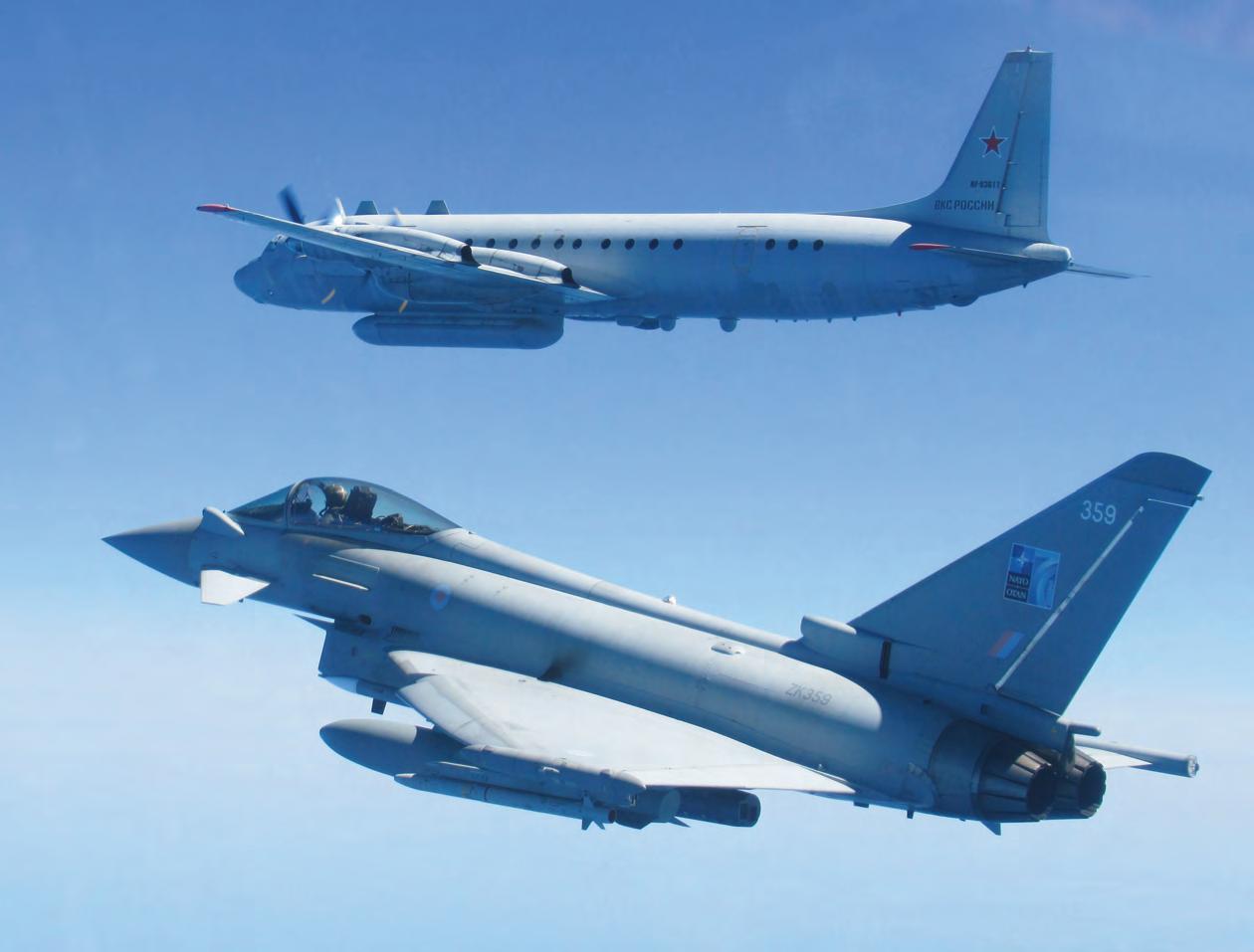
Typhoon: long-range first responders
Air Vice-Marshal Mark Flewin, Air O cer Commanding 1 Group (at time of writing), highlights the Typhoon Force’s constant readiness to deliver the UK’s Quick Reaction Alert tasking, while also being able to intervene at a moment’s notice across the globe
Some 18 years since its rst assumption of Quick Reaction Alert duties, Typhoon continues reliably to excel in the RAF’s foundational and essential role of securing and defending the nation’s skies. Still second only to F-22 among western ghters in raw performance, the aircraft remains world-class in its air defence mission as it reaches midlife in RAF service. Whether intercepting Russian long-range aviation or non-
communicating airliners in crowded airspace, Typhoon has earned a deserved reputation for excellence as the UK’s rst responder to airborne threats.
Defending the homeland
Keeping aircraft and pilots poised for action at a moment’s notice at RAF Coningsby, RAF Lossiemouth and in the Falkland Islands is a considerable task, xing more resource than might be assumed. Yet
Typhoon has been heavily tasked overseas for much of its service, putting an early interim air-to-surface capability to highly e ective use during NATO’s Operation Uni ed Protector mission over Libya. Later, the hastily mounted Operation Luminous deployment to Akrotiri helped to deter Syrian aggression against the Sovereign Base Areas at the height of tension over abortive strikes on chemical weapons facilities. Mounting combat air patrols at the end of the transit from RAF Coningsby, and quickly conducting air defence integration exercises with French, US and Royal Navy ships operating in the area, Typhoon’s sudden and highly visible presence had the desired strategic e ect during its rst short operational visit to Cyprus.
Counter-Daesh operations in the Middle East
As the tenth anniversary of the Operation Shader detachment draws near, it is worth recalling that Typhoon’s long second stay on the island began as another rapid response. Six aircraft left RAF Lossiemouth at rst light after the dramatic latenight parliamentary vote to extend counter-Daesh operations into Syria, the strategic message reinforced by the Defence Secretary’s announcement of the Typhoons’ departure. Coalition combat air patrols deterred Russian and Syrian interference in counterDaesh activity, assuring freedom to operate for the o ensive support and reconnaissance missions that gave Iraqi and Syrian Kurdish ground forces their decisive edge in recapturing territory.
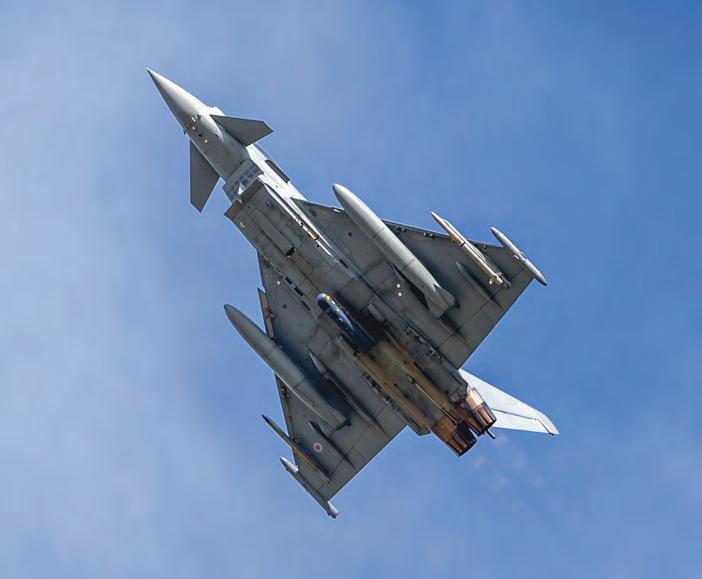
and attack drones. Responding to reports of air activity near the Al-Tanf Coalition base in Syria during a routine patrol on 14 December 2021, a pair of Typhoons identi ed a small drone and shot it down with an ASRAAM (advanced shortrange air-to-air missile as soon as it became clear that it posed a threat to Coalition ground forces. Typhoon’s rst operational air-to-air missile
“Recent years on Operation Shader have seen renewed emphasis on the air-defence mission in response to the proliferation of small reconnaissance and attack drones”
Typhoon’s mature multi-role capability enabled it to augment Tornado GR4 and Reaper in their o ensive tasks, conducting hundreds of Paveway IV guided bomb attacks while retaining the ability to swing to a defensive counter-air posture whenever required. Following Tornado’s retirement, opportunities to employ the newly integrated Storm Shadow and Brimstone missiles were taken just before Daesh lost its nal territorial foothold and reverted to insurgency. Typhoon weapons expenditure declined steeply thereafter in what could be considered a mark of the Coalition air campaign’s success.
Recent years on Operation Shader have seen renewed emphasis on the air-defence mission in response to the proliferation of small reconnaissance
engagement was executed with skill and professionalism against a target that was made extremely challenging to detect and identify by its diminutive size and slow speed, highlighting the importance of the pending Typhoon AESA (active electronically scanned array) radar upgrade.
Escorting Rivet Joint over the Black Sea
Serving as rst responder once again in February 2022, Typhoons mounted long-duration sorties from RAF Coningsby (to patrol over Poland) and from RAF Akrotiri (to patrol over Romania) within 24 hours of Russian forces entering Ukraine. Conducted under NATO command, these Enhanced Vigilance Activity missions continued for months, signalling
The presence of Typhoons in any region can have a noticeable deterrent e ect
(PHOTO: MOD/ CROWN COPYRIGHT)
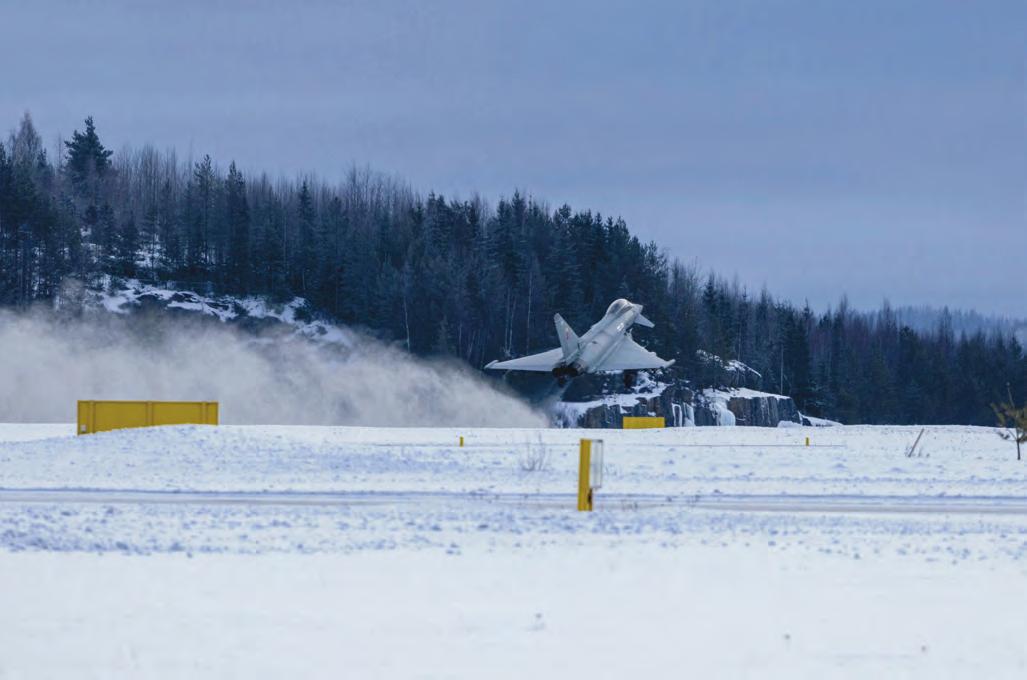
Typhoon has come to symbolise UK power projection, in uence and strategic agility (PHOTO: MOD/ CROWN COPYRIGHT)
the UK’s steadfast commitment to the Alliance and serving as a clear demonstration of NATO’s resolve in the face of Russian aggression.
Operation Aluminium notably added another facet to the RAF’s strategic jewel in the Eastern Mediterranean, using RAF Akrotiri for the rst time to project conventional power north into Europe. Escort of UK-based Rivet Joint aircraft conducting reconnaissance missions over the Black Sea was added to the RAF Akrotiri detachment’s rapidly lengthening task list. Deployment of additional Typhoons enabled Operation Shader missions to continue in parallel. 12 Squadron’s participation in the air defence of Qatar during the 2022 Fifa World Cup closed out a year of incredible success and diversity of output.
Increased NATO Air Policing detachment
Typhoon’s annual NATO Air Policing detachment has also increased in size and scope since the invasion of Ukraine. Expanded from four to six aircraft to provide opportunities for interoperability development with Alliance partners, the detachment conducts frequent small-scale redeployments to exercise the Agile Combat Employment (ACE) concept.
Technical interoperability between Alliance partners is another important contributor to agility and responsiveness, and good progress has been
made with support from the European Air Group. Typhoon has also resumed participation in the Tactical Leadership Programme’s ying course after a long absence, with a view to improving awareness and understanding of NATO procedures and partner capabilities among both pilots and technicians.
Neutralising the Iranian attack on Israel
Agility and responsiveness were both on show once again during April 2024 when the six Typhoons assigned to NATO Air Policing were relocated from Romania to Cyprus after Iran declared intent to mount its rst-ever direct attack on Israel. Typhoons were on patrol in Iraq and Syria and shot down several Iranian one-way drones, contributing to neutralisation of the attack and maintenance of regional stability. The six aircraft were redeployed back to Romania before any gaps in NATO task coverage could materialise.
Enabled by dependable Voyager air-refuelling support, Typhoon has come to symbolise UK power projection, in uence and strategic agility, while sustaining an assured defensive posture at home. With platform availability high and improving, pilot numbers growing and mature multi-role capabilities due to be improved by the Active Electronically Scanned Array (AESA) radar upgrade, Typhoon’s standing as the RAF’s longrange rst responder looks set to endure.
Quality is an obligation
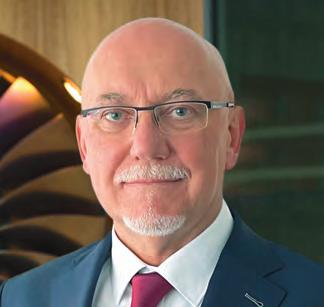
Ralf Breiling Chief Executive O cer, EUROJET Turbo GmbH
Having joined EUROJET in July 2024, what are your key priorities for the next phase of product evolution and customer support?
My rst six months as CEO of EUROJET coincided with a marked resurgence of interest in the Euro ghter Typhoon fast-jet aircraft, which naturally resulted in the need for more of our EJ200 engines. Therefore, one of my priorities is to maintain our exacting standards in terms of performance, reliability and e ciency. EUROJET has always been dedicated to playing our part in ensuring the highest levels of the Euro ghter Typhoon’s weapon system and its fullest operational capability. We are fortunate that we have consistently enjoyed excellent feedback from our customers, with whom we are in constant contact. We work closely with the NATO Euro ghter & Tornado Management Agency (NETMA) and Euro ghter to keep a constant watch on the in-service behaviour of the engine, so that we can maintain the highest levels of performance and identify opportunities for improvement.
How does the EJ200 compare to other fast-jet power plants on the market? What are its key advantages?
One of the secrets of the EJ200’s excellent performance retention is its extremely high thrust-to-weight ratio, which makes it a signi cant benchmark compared to other fast-jet engines, especially when operating in harsh conditions. Another key aspect of the EJ200 is the digital control system, which takes away much of the burden of operating the engine from the pilot and ensures that the engine is not driven beyond any of its operating limits. This allows the pilot to fully concentrate on the mission at hand.
“We have consistently enjoyed excellent feedback from our customers”
Beyond these crucial factors, we also have state-of-the-art diagnostic and testing tools that enable us to reduce the maintenance burden. There is an Executive Lifing system that continuously monitors the usage of life-limited components. This allows the operators to make best use of the engine before components may need to be exchanged. We combine this with an exceptionally low-maintenance concept that relies on the actual condition of the engine and its components, rather than imposed regular interval inspections.
With a resurgence in interest in the Euro ghter aircraft, what plans are EUROJET making to ensure these new aircraft have the best possible power plant?
The remarkable spike in interest in the Euro ghter – with new orders from Italy and Spain and a potential order from Germany in the pipeline – is an opportunity for EUROJET to increase its production capacity and, in doing so, grow the supply chain and strengthen its resilience.
As you would expect, we are establishing plans to meet this new demand, alongside our industrial partner companies, to ensure that we can ful l every order. So, there is a full commitment to simultaneously supporting the needs of the core customer nations, as well as our export customers.
Can you o er an update on the long-term evolution of the EJ200 and how it will bene t operators, including the RAF?
As I mentioned, EUROJET is in constant contact with our customers and the feedback we are getting about the EJ200’s excellent performance has con rmed the high levels of current customer satisfaction, especially with the RAF. With the EJ200 still consistently delivering exceptional performance and exceeding customer requirements, the core nations have decided not to pursue the Long-Term Evolution package we proposed, expressing their con dence in the engine’s current capabilities.
The RAF ies in complex operating environments, which allows us to continuously assess and meet emerging needs. We are naturally fully committed to and aligned with their evolving requirements.
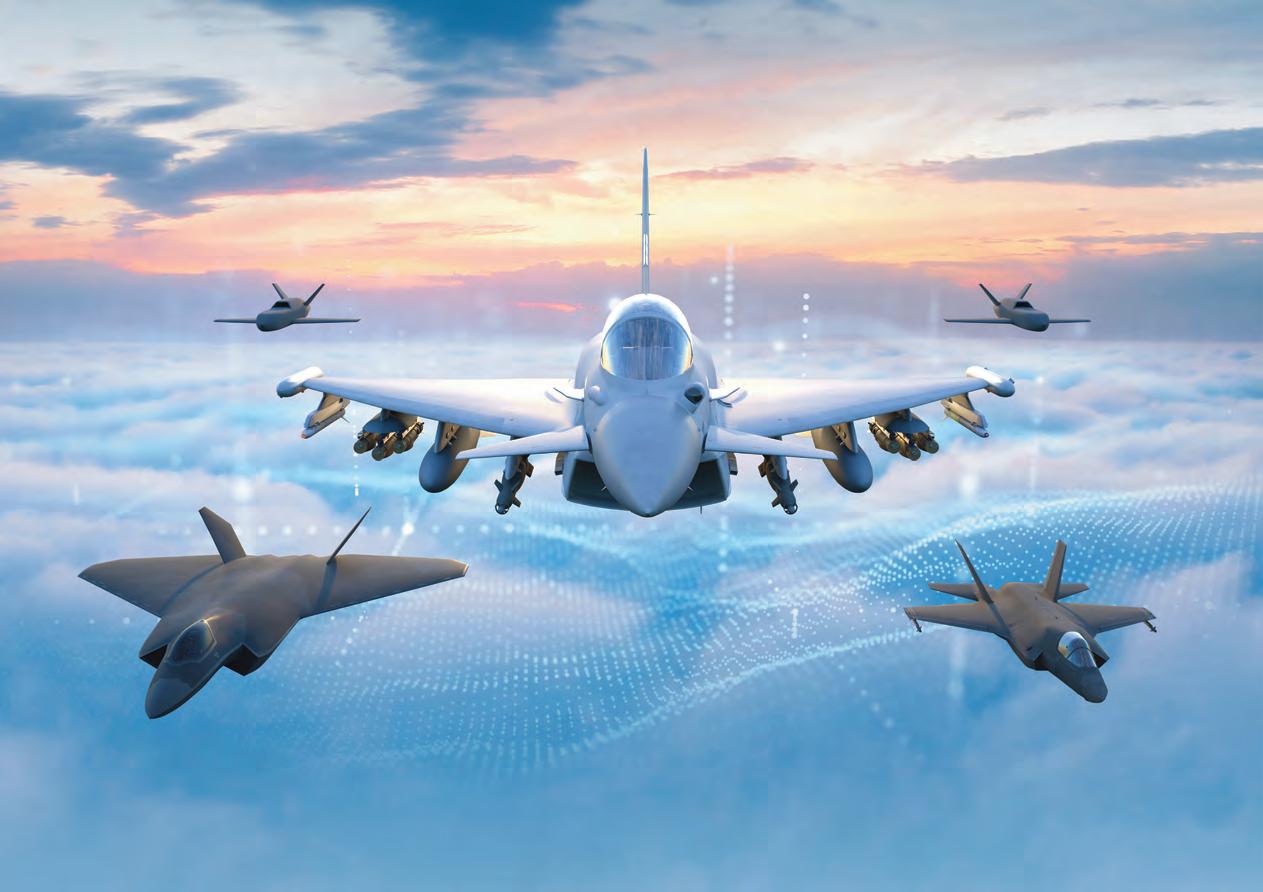
Ready to respond
Richard Hamilton, Managing Director Europe & International, BAE Systems, discusses the critical role that industry must play to respond to the ever-changing global threat and the importance of sovereign defence capability
On the day that Russia mounted its illegal invasion of Ukraine in February 2022, the need to secure Europe’s eastern border became a priority for the NATO Alliance.
Investment in combat air programmes supports growth and technology development
(IMAGE: BAE SYSTEMS)
The response of the Royal Air Force was immediate, and UK industry stepped up to support. Within hours of the invasion, teams from BAE Systems were working alongside their RAF counterparts to establish the upgrades needed and what could be accelerated to ensure its Typhoon eet was ready to respond.
Over the following days and weeks, multiple software and hardware upgrades were delivered to the front-line eet, and new weapons were tested in our integration rigs.
Since then, the need for speed to meet operational requirements at pace has not slowed within our teams supporting the UK’s critical role at the heart of NATO, whether through front-line support, engineering critical capabilities or delivering training to ensure readiness. We must not underestimate the powerful message that sovereign industry working closely with the military sends to potential adversaries about the strength of our capabilities.
Defence Acceleration Production Plan
The creation of the NATO-led Defence Acceleration Production Plan in 2023 underlined the vital role that industry plays in accelerating the production of equipment, boosting capacity and securing critical

supply chains, and this was further strengthened by NATO’s Industrial Capacity Expansion Pledge in 2024. All of this ensures we provide what our armed forces need to deter, defend and defeat and our people feel a huge sense of pride in the role they play.
BAE Systems today is the only sovereign advanced combat air provider in the UK and, as such, can act on behalf of the UK in times of need and crisis. It has been the custodian of generations of some of the most signi cant innovations in aviation history – indeed, history full stop. It was only the forward thinking of the likes of R J Mitchell and Sir Sydney Camm that gave us the Supermarine Spit re and the Hawker Hurricane. Today, a new generation of British engineers and designers are developing the aircraft that will make up the future of military aviation for both the UK and global partners.
Providing current and future options
Through investments in research and development (R&D), we are giving our international customers the options they need both now and in the future. We are evolving capability on Typhoon, investing in unmanned systems that will be integral in the future battlespace and developing the RAF’s nextgeneration combat aircraft, Tempest. The ability of industry to deliver capability across generations maximises the deterrent to our enemies.
But our R&D goes beyond platforms investing in areas, including data science and digital analysis exploitation, that will be vital to success in an increasingly contested future battlespace. This work brings capability and strengthens alliances. Collaborations, such as Euro ghter, partner the UK with NATO allies Germany, Italy and Spain, and beyond to the Middle East, and with Italy and Japan on the Global Combat Air Programme. At a political, military
and industrial level, we share a common aim and approach. The need to protect our national ecosystem, which provides this capability, has arguably never been so crucial and it delivers growth to our economy.
Supporting growth and technology
In the UK, investment in combat air has supported growth and advancement of UK technology and development of high-value skills and meaningful careers. Today our industry supports more than 48,000 high-skilled jobs across every part of the UK, in specialist areas such as design, ight testing, radar, engine and advanced weapons capability development, and complex systems integration.
The sector has an annual turnover of more than £6bn. It is responsible for more than 85% of defence exports; supporting the UK’s international relationships; ful lling agreements that underpin international security and defence with allies across NATO and beyond.
In 2018, the UK Government launched its Combat Air Strategy, outlining a vision, framework and timeline to assess options for the UK’s future combat air requirements, giving industry con dence to invest in research and development and transform business practices.
The years that have followed have seen us take huge strides, but we cannot a ord to let the pace of progress falter. Investment in sovereign combat air programmes, such as Typhoon and Tempest, stimulates the ecosystems that underpin our industrial base, ensuring the UK can continue to tailor its defence capabilities to meet evolving threats and operational requirements e ectively.
At BAE Systems, we are committed to responding to the needs of today and investing to meet the threats of tomorrow.
Collaborations on combat aircraft programmes such as Euro ghter Typhoon forge robust relationships with allies and partners (PHOTO: MOD/ CROWN COPYRIGHT)
Celebrating 100 years of supplying advanced military engines

Jill Albertelli President, Pratt & Whitney Military Engines
This is a big year for Pratt & Whitney – what’s the signi cance of 2025?
This year marks Pratt & Whitney’s centennial anniversary. Our business began in 1925 with the invention of the R-1340 Wasp engine for the U.S. Navy. Today, Pratt & Whitney has more than 7,500 military engines elded, ranging in size from 150 to 50,000 pounds of thrust, with over 30 global operators.
Can you highlight some of the updates you are making to keep your engines war-ready?
Pratt & Whitney is committed to investing in the sustainment and modernisation of our engines. As more capabilities are tted to airframes, the engine plays a crucial role supporting those added requirements.
There are several examples of how we’re adding increased capability to our engines. The F100, which has been ying for over 50 years, is the only fourthgeneration engine o ering operationally proven fth-generation technologies. Our F119 engine underwent a software update, enabling increased thrust for the customer. And our F135 Engine Core Upgrade delivers the durability and performance needed to enable Block 4 capabilities and beyond.
What’s next for the F-35?
The F135 Engine Core Upgrade will help ensure the United States and our allies can maintain air superiority for decades to come. It is a drop-in upgrade that is retro ttable into all F-35 variants and is available to all F-35 operators. It o ers operators additional power and thermal management capacity needed to enable next-gen weapons systems and sensors.
With respect to the Engine Core Upgrade progress, our team completed a preliminary design review last July. We received a contract valued at up to $1.3bn in October to continue work, we have around 800 engineers and programme managers working fulltime, and we are progressing in line with the government schedule.
Looking to the future, where is propulsion technology headed?
We are working on incredible technologies. We are the propulsion provider for the sixth-generation B-21 bomber, which is undergoing ight testing and scaling into production. We are well positioned with propulsion
solutions for CCAs – whether that’s leveraging commercial-o -the-shelf solutions or scaling existing engines. And we are making phenomenal progress with our Next Generation Adaptive Propulsion (NGAP) o ering for the U.S. Air Force. With the successful completion of detailed design review in February, the next contract phase is under way to procure and assemble our XA103 prototype ground demonstrator, with testing expected in the late 2020s.
We’ve also seen in the past ve years how modern warfare has changed. How is Pratt & Whitney adapting to that evolving battle eld?
Contested logistics are now a reality, and we’re facing unprecedented threats to our defence ecosystems. And, as we develop engines, we need to factor these challenges in supplying and sustaining military operations when an adversary actively targets or disrupts those e orts.
Pratt & Whitney is facilitating resilience through the implementation of digital processes and additive manufacturing. Our digital transformation is resulting in improved e ciency and e ectiveness. We have established a collaborative digital environment, allowing for reviews that are more comprehensive as they provide direct access to digital artefacts and engineering tools that model our progress. And additive manufacturing is transforming the way we design and manufacture products, allowing for fewer parts, scalability, a ordability and manufacturing exibility.
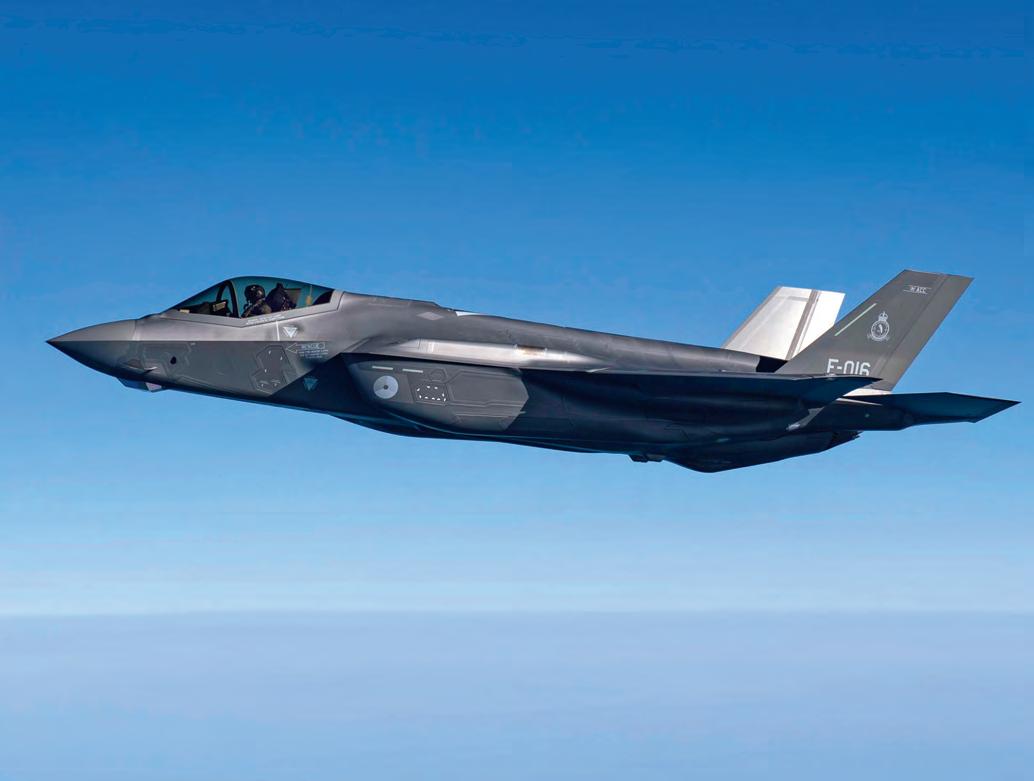
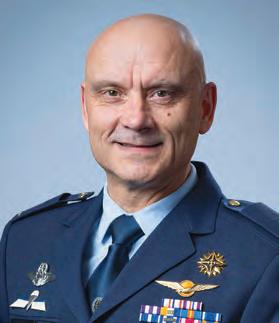
Creating an F-35 culture
Lieutenant General André Steur, Commander of the Royal Netherlands Air and Space Force (RNLASF), highlights how the worldwide community of F-35 operators is creating an innovative culture of allies ready to ‘Fight Tonight’, ‘Fight Tomorrow’ and ‘Fight Together’
In a world where safety and e ectiveness go hand in hand, the F-35 is not just an aircraft, but a symbol of innovation and cooperation.
The culture that emerges around this is built on a number of key pillars: well-trained professionals working in a networked high-tech environment; a warrior mindset of not holding back and stepping
forward when needed; direct communication; team spirit; trust in each other on the ground and in the air; and, from the start of planning, rank is irrelevant.
But what exactly is this culture? Culture is not a xed entity, but a dynamic living phenomenon shaped by the interaction between people, traditions and circumstances.
An F-35A of the RNLASF ies during Exercise Ramstein Flag 25 (PHOTO:
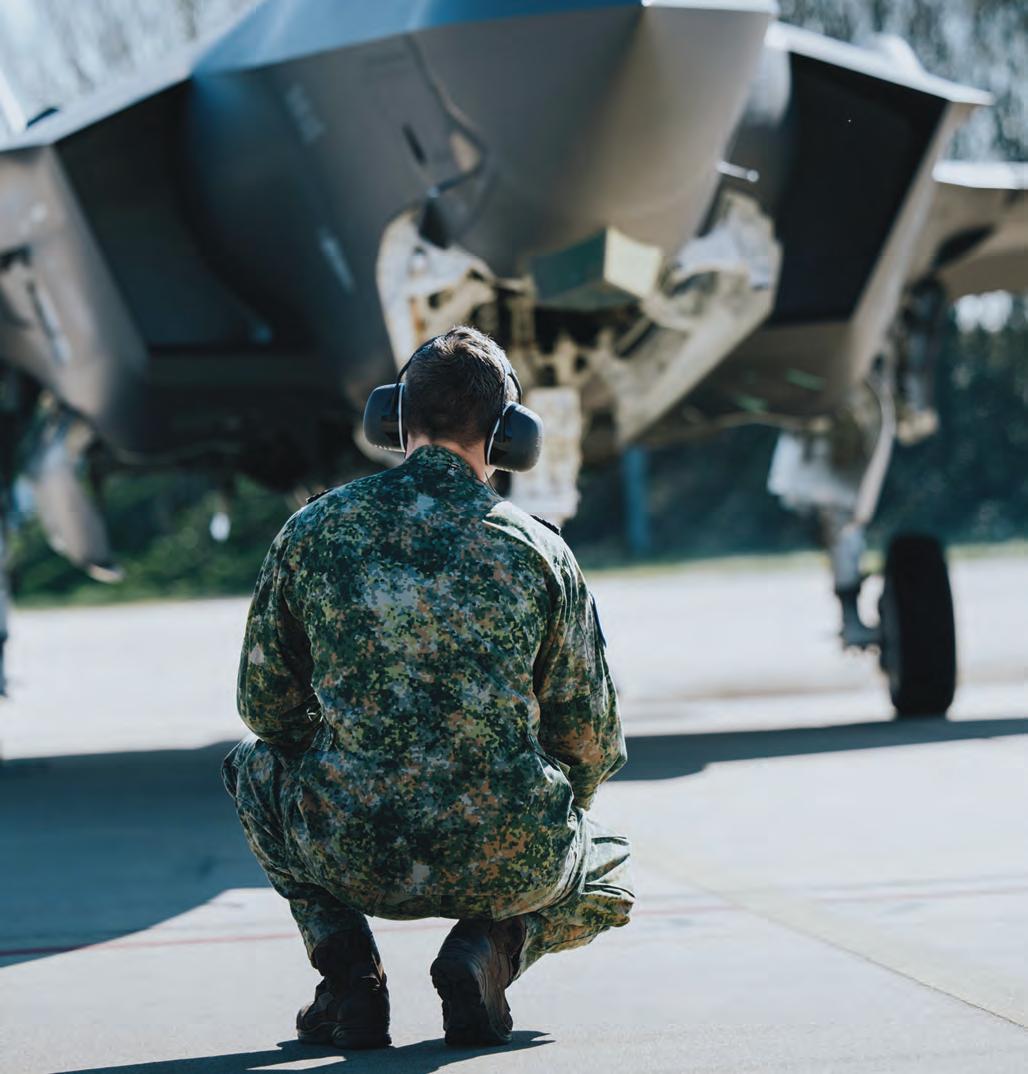
Within the F-35 community – but, in a sense, this applies to the entire air force family – we build on a rich history of traditions, values and behaviours. In other words, we stand on the shoulders of our predecessors. That collective background is the foundation on which we build today. But we are aware that culture lives, moves and develops. In a rapidly changing world, organisational culture sometimes requires adaptation. We take the strong elements of the past, such as discipline, camaraderie and a sense of duty, and evolve them to meet the demands and circumstances of today. External in uences – such
as technological developments, societal changes or international missions – force us to re ect on: what do we keep, and what do we let go? The formation of culture within an organisation is, therefore, a conscious and important process.
Collaboration and innovation
In the F-35 community, this means that, on the one hand, we cherish traditions, and at the same time we create space for growth, collaboration and innovation. It’s not just about rules and ranks; it’s about shared values, role models, challenging each other and constantly improving.
“The lessons learnt from current and recent con icts show that gaining air superiority is essential for the freedom of action of our brothers and sisters at sea, on land and in the air”
Our focus is on ‘Fight Tonight’ and ‘Fight Tomorrow’. We are always ready to take immediate action when needed and to sustain it for as long as necessary. We believe in credible deterrence: credibility, capability and communication. Our capabilities, and the willingness to use them, provide a deterrent to our adversaries. In order to make the right decisions, we are constantly working to increase our situational understanding; we must always be aware of the latest developments and be able to react quickly to changes in the environment. We do not wait, but act – today, if we have to, with everything we have. We’re not doing this alone. ‘Fight Together’ is our motto. We collaborate nationally and internationally in multi-domain operations, combining our
capabilities to achieve maximum impact. We are increasing our e ectiveness by reaching out from the multiple domains of air, space, land, sea and cyber to achieve e ects in the cognitive, virtual and physical dimensions. The lessons learnt from current and recent con icts show that gaining air superiority is essential for the freedom of action of our brothers and sisters at sea, on land and in the air – even if it is sometimes temporary and local.
A transatlantic culture
But we are aware that Europe cannot face these challenges alone. We need the support and cooperation of our transatlantic allies to achieve our goals. At the same time, we are striving for a
The RNLASF joined the community of F-35 operators in 2019 with its rst F-35A (PHOTO: NETHERLANDS MOD)
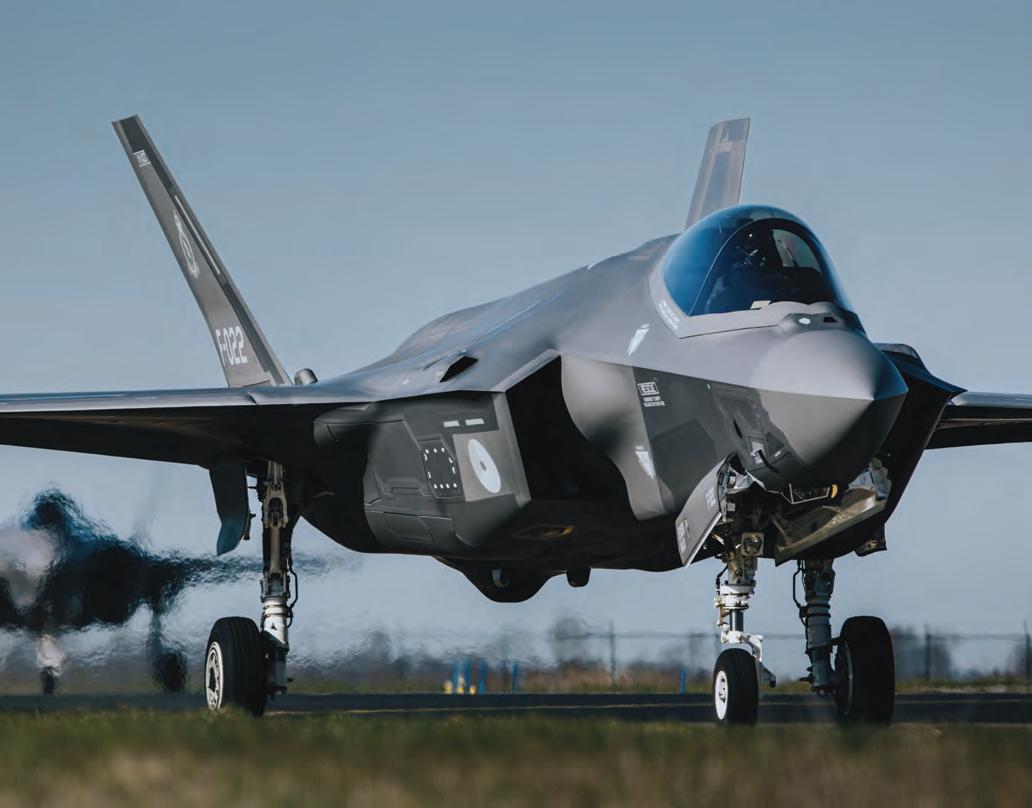
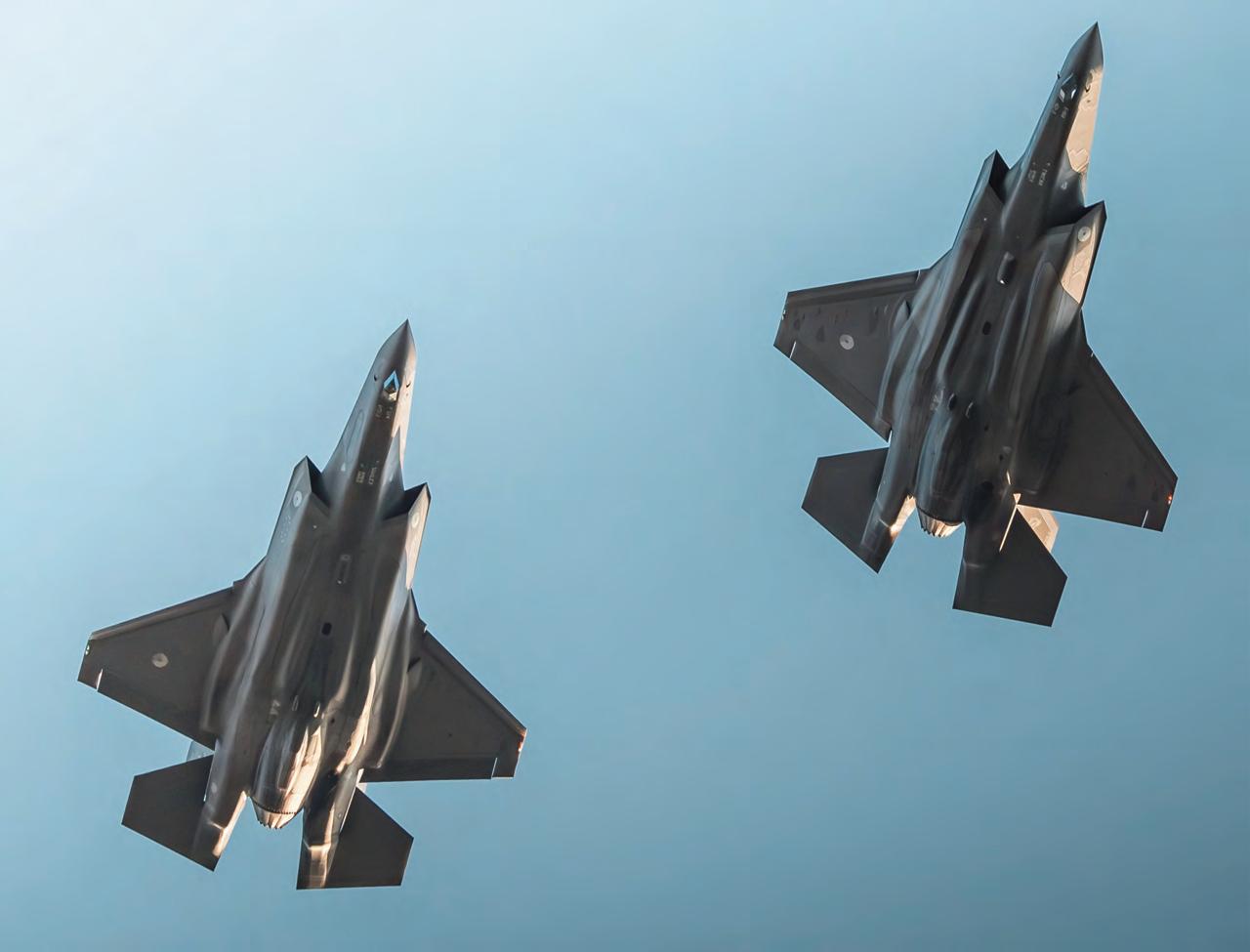
more autonomous European Defence, in which we develop and deploy our own capabilities to protect our security and interests.
This is not a contradiction, but a necessary step towards a stronger and more resilient Europe. We need to join hands as European countries, but we also need to nurture the ties with our transatlantic allies to face the challenges of the 21st century together.
Working together
The F-35 culture promotes working as a team to achieve goals (PHOTO: NETHERLANDS MOD)
The F-35 culture is about creating a community in which everyone contributes his or her part to the greater whole. We strive for a culture where tradition and innovation meet, where we take our strength from the past and, at the same time, create space for new ideas and developments.
In this culture, there is room for everyone –not just for the veterans who share their knowledge and experience, but also for reservists and civilians, as well as those young, talented individuals who bring innovation and boundless energy. We’re a team, a family, a community working together to achieve our goals. One team, one task – small in number, large in deeds.
The F-35 culture is unique and dynamic. It is closely related to the Whole Air Force culture and builds on a rich history of traditions and values. We are proud of our culture and strive to preserve and develop it. By focusing on ‘Fight Tonight’, ‘Fight Tomorrow’ and ‘Fight Together’, we are always ready to respond to the challenges of the 21st century and to protect our security and interests.








F-35 – the world’s most advanced ghter aircraft





Paul Livingston Chief Executive UK & NATO, Lockheed Martin

How does the Lockheed Martin F-35B enable the RAF’s current air capabilities and how will it evolve for future operations?
As the world’s most advanced ghter aircraft, the F-35B is a critical component of the Royal Air Force’s air capabilities and serves as the backbone of its Carrier Strike capability. Flown from the UK’s Queen Elizabeth -class carriers and RAF Marham in Norfolk, the F-35B’s advanced avionics and sensor systems enable the RAF to gather and share critical information in real time, enhancing situational awareness.
The F-35 is the glue that connects the nation’s defence assets and is the only platform capable of collecting and disseminating data from satellites to the air, naval and ground forces of any ally, while at the same time protecting them from the air. In fact, last December, in partnership with the UK RAF Rapid Capabilities O ce, our Skunk Works® team
demonstrated the F-35’s ability to share live classi ed data via an open systems gateway with an RAF command and control system. As we look ahead, the F-35 was designed with upgrades in mind, allowing for additional capabilities to be added to meet evolving threats and ensure UK deterrence and security for decades to come.
What is the status of the RAF F-35B delivery programme and how else will Lockheed Martin contribute to the UK’s longterm prosperity and security?
We have delivered 38 of the rst tranche of the UK’s 48 jets, with the remainder expected by early 2026. Currently, the UK’s F-35s are contributing to the Carrier Strike Group 2025 (CSG25) global deployment, further demonstrating its unrivalled capabilities in complex operations.
“The F-35’s growing presence is a powerful example of alliance-based deterrence”
The F-35 is one part of Lockheed Martin’s impact in the UK. In addition to the more than 2,000 Lockheed Martin employees in the UK today, we also support over 25,000 UK jobs across aerospace and defence in every home nation of the UK and contribute an average of £1.9 billion to the UK economy every year.

Why is the Lockheed Martin F-35 important for enabling international partners to interoperate across the globe?
Today, in the UK and across Europe, the F-35’s growing presence is a powerful example of alliance-based deterrence. By gathering, analysing and seamlessly sharing critical data, the F-35 gives commanders unprecedented situational awareness and the con dence to act quickly. Multinational F-35 training and exercises, such as CSG25, have demonstrated the transformative e ect of a multi-country fth-generation aircraft eet. One F-35 is a force multiplier. More than a thousand F-35s is a global force of advanced, interoperable ghters that ensures allied nations will continue to own the skies.
How is Lockheed Martin embracing new technologies to ensure its defence systems can cope with evolving threats?
Across Lockheed Martin, we are embracing and leveraging new technologies to deliver the speed, agility and insights our customers need to stay ahead of rapidly evolving threats. One example is how we are using arti cial intelligence (AI) and machine learning to process, fuse and analyse tremendous amounts of data to give our customers actionable intelligence and a strategic advantage. In fact, our Skunk Works® team is bringing more than 80 years of innovative solutions to the UK Armed Forces through the TIQUILA intelligence, surveillance, tracking and reconnaissance (ISTAR) programme which is driven by AI technology.
Integration – the right stu ?
Air Marshal (Retd) Greg Bagwell CB CBE FRAeS, President of the Air & Space Power Association, considers the advantages of integrating existing capabilities with tactics and innovation
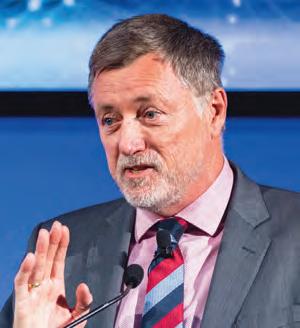
As many countries begin to reverse decades of lower investment in Defence, there is an understandable tension in what to spend that additional investment on. For many, it will be as simple as thickening what we already have, by building up stockpiles and increasing our resilience to sustained or surprise attack. Some will have gaps that need to be lled, now that the risk of their absence can no longer be tolerated. And most will be looking to the horizon and beyond to ensure that we have considered and embraced those technologies that confer a future advantage, and keep us ahead of our potential adversaries. And whatever strategy we pursue, we will all be looking at the lessons observed from recent con icts, and seeking to apply those that are relevant to the next one. They say that quantity has a quality all of its own, and the attritional and swarming attacks that we observe in both Ukraine and the Middle East could suggest that we need more mass to counter or deter such a war; there is some truth in this thesis, as weapon stockpiles and rearmament
manufacturing is placed under signi cant strain. Using a ludicrously simple mathematical formula, such a conclusion could result in an equation that looks something like this:
Stu + more stu + responsive supply chain = sustainable mass
In terms of a strategy, this means ghting re with re and seeking to make the cost to a foe like Russia too great to bear. That might deter an attack, yet we have seen Russia’s appetite for loss and hardship far outstrip that which western European countries might tolerate. So, pursuing such a strategy implies that we are prepared both physically and mentally to go toe to toe with a less morally-observant adversary. Thus, might we be in danger of extracting the wrong lessons from
Russia’s illegal invasion of Ukraine
– a con ict that has turned into the horri c, static stalemate of trench warfare and war on a population?
A strategy that purely pursues mass as a means to win is not only an expensive one, but one that relies on sheer will and sustained public support to succeed. Thankfully, there is another way, and that is maximising the use of the capability you already have by multiplying its e ect:
Stu x tactics x integration = overwhelming e ect
Here, it’s the multiplying e ect of our ingenuity through optimised tactics and integration that can make up for a lack of pure mass, but it also seeks to avoid the type of attritional war that Russia believes exploits the weaknesses of modern democracies. However, in a time of
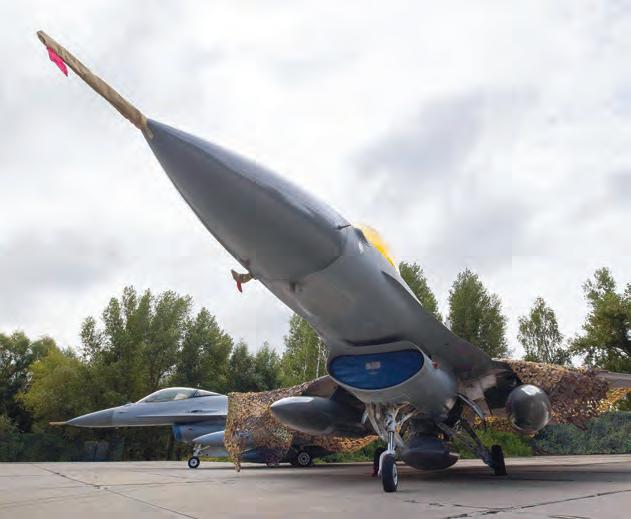
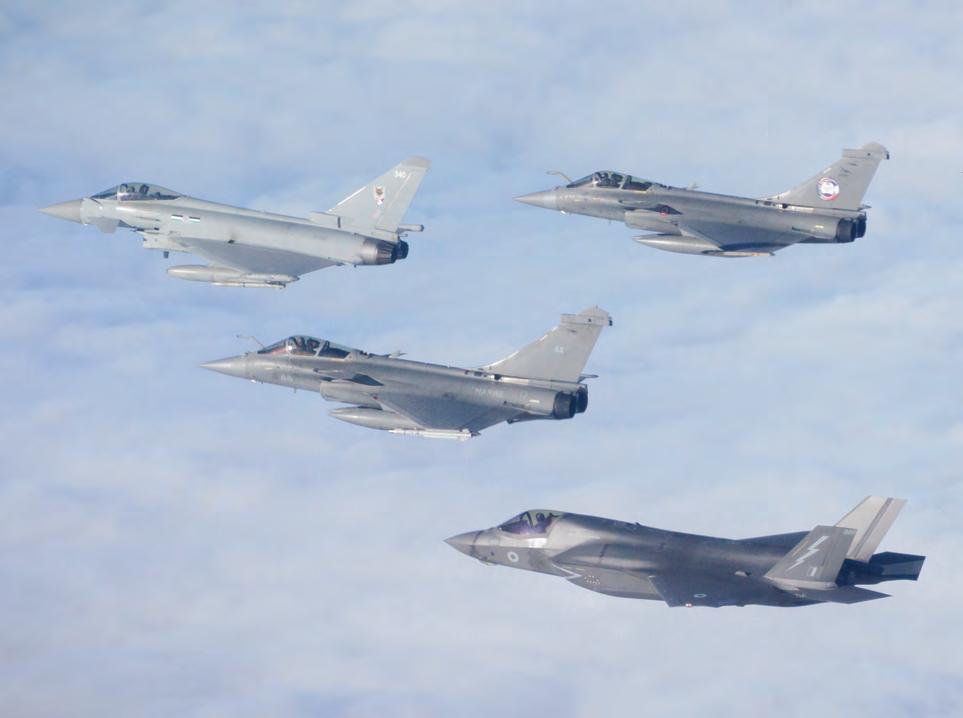
Exercising together to improve operational integration and interoperability is vital (PHOTO: MOD/CROWN COPYRIGHT)
uncertainty and doubt, we should also see better integration as a unifying power, as well as just a more e cient and e ective way of ghting.
I know that these equations oversimplify and inaccurately represent the true complexity of force design; and, anyway, the mathematical truth is that, while the second equation is compelling, your amount of ‘stu ’ still has a signi cant impact on the result. But the point my low-grade maths is trying to make is that it is the multiplying e ects of tactics and integration that is so important here, and buying more stu and strengthening supply chains takes time and money that we currently have so little of.
Air and space power inherently act as integrators, both in their own domains and even more vitally with the other domains. It is the force multiplier that is worth so much
“Air and space power inherently act as integrators, both in their own domains and even more vitally with the other domains”
more than the sum of its parts. It is hardly surprising, therefore, that recently the most noise from a belligerent Russia has come when the threat of more air or space power to Ukraine is on the table. Whether it be the provision of combat aircraft, satellite feeds or longer-range strike weapons, Russia is frightened by the prospect of western air and space power around or over its borders. It is frightened not just by the technological edge we still (just) enjoy, but by the way we ght, and the way we ght together. Integrated NATO airpower brings a dynamic to the
ght that Russia now knows it will nd hard to handle. That Ukraine has achieved so much with so little, should be all the warning signs that Russia needs.
So, as we seek to strengthen our defences by buying more stu , we should not forget that the continued development of our tactics and the design, exercising and maintenance of our integration is every bit as important as we seek to deter and, if necessary, defeat any future threats. Yes, we need more ‘stu ’, but integration is the ‘right stu ’ that makes it so much more e ective.
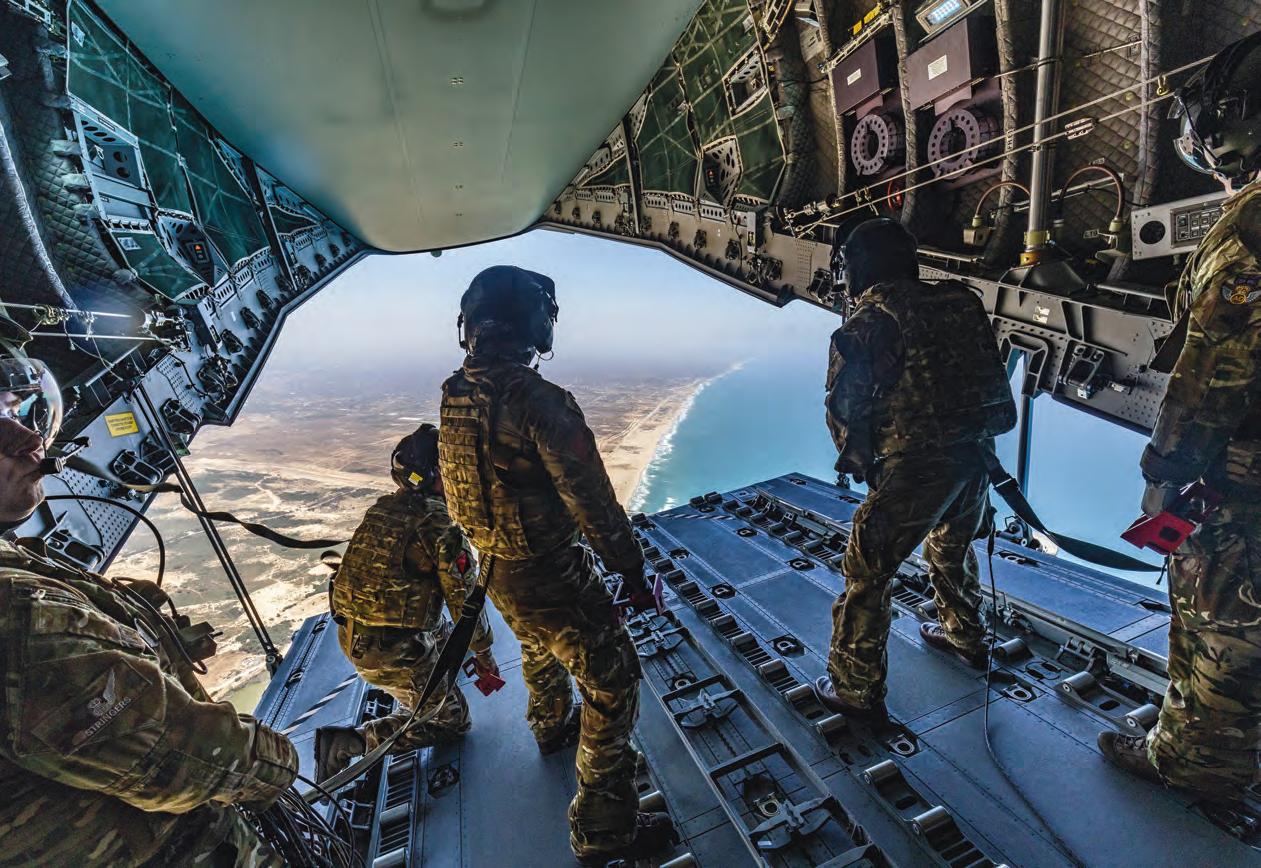
OPERATION UNDERHILL
Humanitarian airdrops in Gaza
On 24 March 2024, an RAF Air Mobility Force A400M Atlas cargo transporter dropped food and provisions to the people in Gaza. The RAF’s Air Mobility Force Commander, Air Commodore Dan James, reveals the complexities of this multifaceted aid operation and how it has evolved since that rst drop
The Air Mobility Force was tasked to deliver humanitarian aid into war-torn Gaza, resulting in the A400M’s rst-ever operational ‘air drop’ in RAF service on 24 March 2024. Highlighting the contemporary importance of Air Mobility capability, over six weeks RAF crews successfully delivered over 110 tonnes of life-saving aid with pinpoint accuracy onto extremely small, unmarked and uncontrolled Drop Zones. This support to Operation Underhill is a salient reminder of
Air Power’s enduring ability to deliver e ect at range. The forebears of 30 Squadron (now one of the two dedicated A400M squadrons) rst used air drop to resupply the besieged fort of Al Amara in Iraq with aid in April 1916, two years before the RAF was formed. However, since the rst air drop in Iraq over a century ago, modern Air Mobility operations have evolved considerably. During Operation Underhill, the key considerations were broadly typical of modern air operations: decon iction and planning
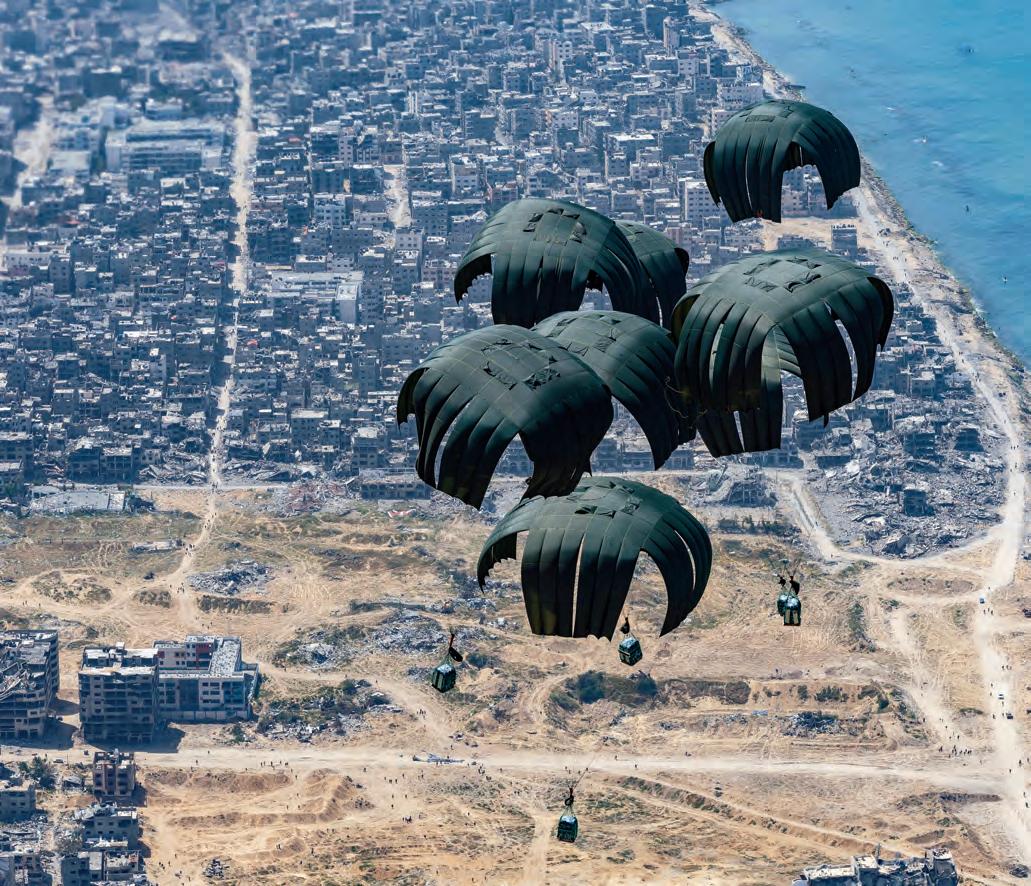
in a coalition; a change from scenarios normally used for training (in this case, the use of unusual Drop Zones); command and control; and the ability to rapidly replace critical stocks from industry.
Coordinating with allies
During Operation Underhill, the Air Mobility Force was tasked to prepare, plan, coordinate and conduct air drops alongside regional and global allies. Operating in a rapidly assembled bespoke coalition and underwriting safe decon iction from all other platforms can be challenging. At the height of the operation, crews from Belgium, Egypt, France, Germany, Jordan, Philippines, UAE, UK and USA were all involved.
On the two air drops over Eid on 9 and 10 April, a total of 17 aircraft ew in the formation. Alongside these Air Mobility aircraft, low-level rotary-wing tra c and small Unmanned Air System surveillance assets were operating in the same segregated area.
This airspace congestion required thorough planning to ensure each element of the air package was coordinated and decon icted to their designated – and di erent – Drop Zones. Speci c routing requirements, with strict time spacing, di erent formation operating procedures and di erent native languages, made this coordination a challenge for all the crews. From an RAF perspective, this re-enforced the value of honing skills on regular and frequent international exercises to learn to collaborate exibly with di erent partners.
Mitigating injury risks
Unlike the scenarios that the A400M crews normally used for training, the available Drop Zones were small, with restrictions due to the urban surroundings of damaged buildings and the dynamic nature of the con ict. In many cases, the beaches were the best option. However, given no ground forces were able to clear Drop Zones before use, the areas
Safety was paramount during each air drop
(PHOTO: MOD/ CROWN COPYRIGHT)
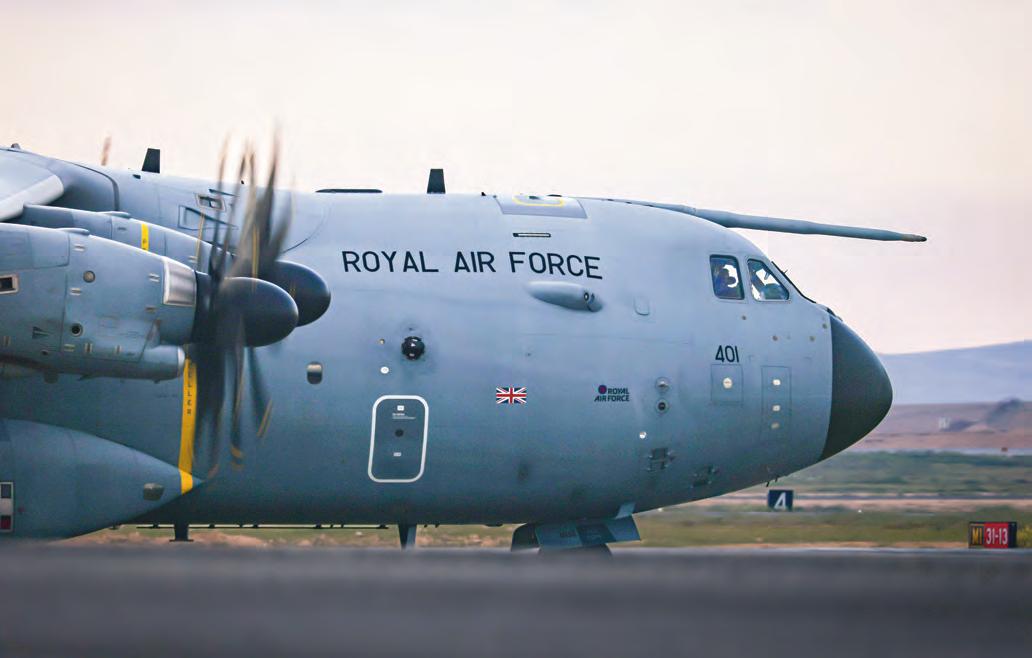
The highly versatile Airbus A400M (seen here on the tarmac in Amman, Jordan) is one of the RAF Air Mobility Force’s key assets (PHOTO: MOD/ CROWN COPYRIGHT)
were often busy with local people desperate for aid, which raised the risk of the humanitarian stores causing severe injury. That said, these risks were mitigated using surveillance feeds, Air command and control, and mission command.
Real-time communication
Before each drop, live overhead surveillance footage was monitored from the 603rd Combined Air Operations Centre in Al Udeid by the Deputy Air Component Commander to assess the risk of injury to civilians. Live satellite communication to the A400Ms permitted real-time communication, enabling a ‘Go/No Go’ decision by the Deputy Air Component Commander at 10 minutes before each drop.
If the decision was ‘Go’, the crew were cleared to continue preparing to drop, unless they felt the Drop Zone was compromised, or the safety of the aircraft or crew was at risk. However, in accordance with the principles of mission command, each A400M captain had the nal decision, with the safety of the vulnerable population to consider carefully in a short space of time, while operating their aircraft at low level.
Normally during training, the parachutes used on air drop missions would be recovered, checked, repacked and re-used; however, the circumstances of Operation Underhill clearly precluded this protocol, and parachute numbers were depleting.
Of course, additional parachutes were ordered to support the ongoing operational requirement; these included a di erent type of parachute not previously used or trialled by the RAF.
In this operational context, the Duty Holder chain, Release to Service Authority and Delivery Team worked quickly to respond with agility and exibility to provide new clearances, without trial activity, by making appropriate risk-aware decisions with the available evidence. This exibility to rapidly acquire and clear into service new parachutes was essential to sustain the operation.
An important capability
Operation Underhill underscores the critical role of air drop capabilities in modern military and humanitarian operations. The ability to deliver aid with precision and e ciency in hostile environments not only saves lives, but also demonstrates the Air Mobility Force’s adaptability and expertise in complex, multinational missions.
The operation highlighted the importance of rigorous training, meticulous planning and the exibility to adapt to rapidly changing circumstances. As the RAF continues to evolve, the lessons learned from such missions will be invaluable in enhancing future air drop operations, ensuring that the UK remains at the forefront of tactical air transport and humanitarian assistance.
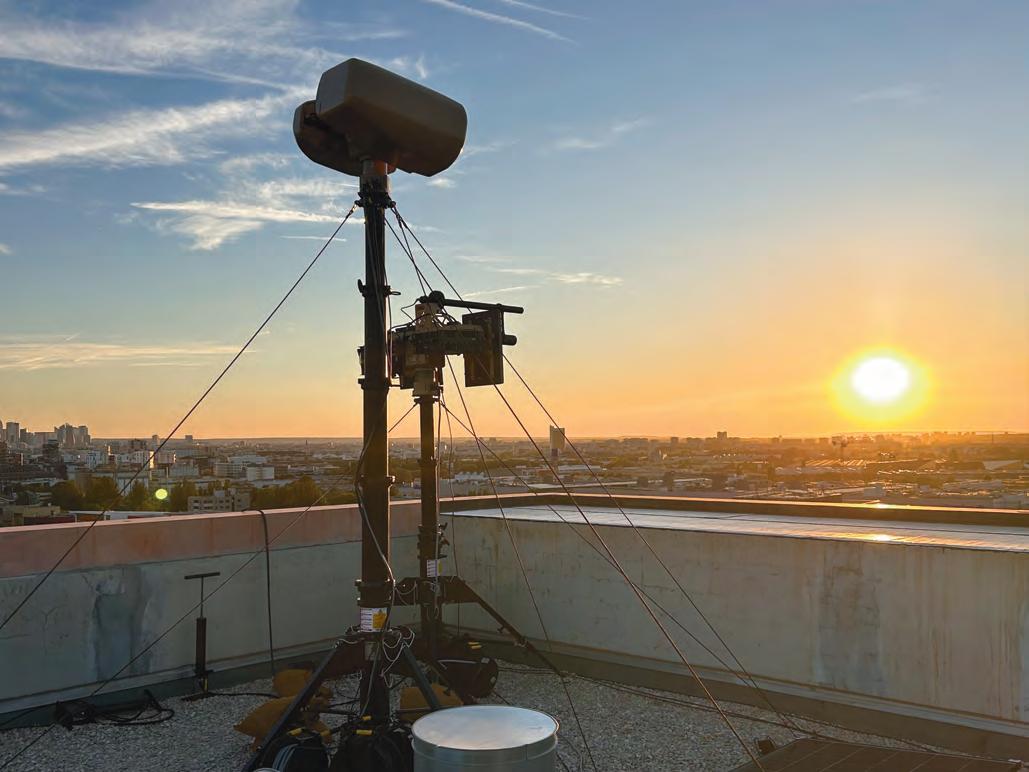
C-UAS at the Paris Olympics
Flight Lieutenant Ben Protheroe, Second in Command, 34 Squadron RAF Regiment, highlights the extraordinary Anglo-French collaborative e ort to counter drones during the 2024 Paris Olympic and Paralympic Games
Between July and September 2024, members of the RAF Regiment serving on No 2 Counter Uncrewed Aerial Systems (CUAS) Wing deployed to Paris and worked alongside French authorities in the wider defence of the Olympic and Paralympic Games.
Formed from an existing Force Protection Wing, in April 2022 No 2 Counter Uncrewed Air Systems (CUAS) Wing came into being.
The Wing commands 34 Squadron RAF Regiment, 63 Squadron RAF Regiment (King’s Colour Squadron) and 609 Squadron Royal Auxiliary Air Force. As Defence’s lead for xed-site CUAS, it has become common for 2 CUAS Wing to be called upon to conduct Military Aid to Civil Authorities (MACA). Previous MACAs have included the funeral of Her Majesty Queen Elizabeth II, the coronation of His Majesty King Charles III, and

even the Eurovision Song Contest in Liverpool in 2023. The Paris Olympics and Paralympics presented a unique opportunity to support a partner nation in an event viewed worldwide.
An increasing threat
The proliferation of UAS, or drones, has increased exponentially in recent years, both in terms of accessibility and the evolution of technology.
The ability to detect, track, identify and, if necessary, defeat UAS operated in an illegal or hostile manner is now a key aspect of any
threat assessment, with the Paris Olympics and Paralympics being no exception.
RAF Regiment Gunners from across 2 CUAS Wing were fully integrated into the Armée de l’Air et de l’Espace (French Air and Space Force). With the French military and police forces providing security from air threat to venues spread across the greater Paris area (and metropolitan France), the 2 CUAS Wing team were tasked to defend the Olympic and Paralympic Village in Saint Denis, Paris.
With the installation of the equipment completed in early July ahead of the start of the
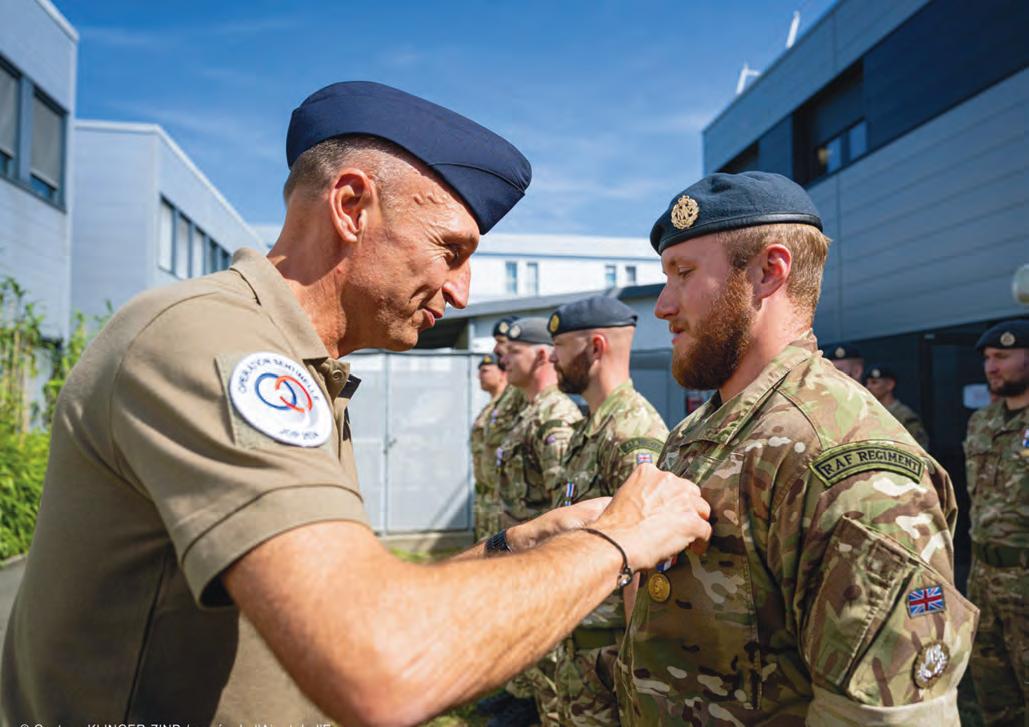
Olympic Games, the team went into a period of testing all UK and French systems. A bilateral exercise period ensued, which saw the rehearsing and re ning of combined tactics, techniques and procedures with ‘hostile’ UAS being own by the French military. While all of this was going on, the Village was a hive of activity, as the nal touches were being carried out and a ‘ring of steel’ built around the venues.
Round-the-clock detection
By mid-July, the UK systems were declared fully operational. UK and French systems operated 24 hours a day, seven days a week until the end of the Paralympic Games in September.
Throughout the deployment a number of unauthorised UAS were detected, with the French Silver Command requesting that several of them be countered. The trend analysis of all detects helps operators and commanders alike to build a threat picture, and then respond and allocate assets accordingly.
The RAF’s CUAS equipment enables key details to be rapidly passed to law enforcement authorities, who can then move to apprehend the operators and exploit any forensics. Operating a suite of non-kinetic systems collectively known as
ORCUS, this equipment has proven itself to be world-leading across multiple theatres. ORCUS provides the operator with a suite of sensors that can detect, identify and then, where required, defeat the UAS to protect key locations or personnel. In addition to ORCUS, 2 CUAS Wg also deployed with NINJA, a library-based protocol manipulation e ector that is particularly suited to combatting commercial drones in a densely populated urban environment.
Historic award
The detachment was particularly fortunate to be individually presented the Médaille de la protection militaire du territoire by General Stéphane Groen (Général de Division Aérienne), a historic occasion as this marks the rst British military personnel to have received this accolade.
The operation was an excellent example of CUAS interoperability in action, with RAF personnel experiencing a once-in-a-lifetime opportunity, while providing critical support to a partner nation. In a CUAS environment where interoperability is key, the Paris Olympics and Paralympics served to enhance tactics and build on a strong Anglo-French partnership.
Maximising cohesion and interoperability
Lieutenant General Simon Hamilton, Deputy CEO of Defence Equipment & Support (DE&S), outlines the organisation’s strategy for delivering integrated capability across air and space

Today, Tomorrow, Together. Three words that represent a golden thread of intent running through the Royal Air Force and DE&S.
As the procurement arm of the UK Ministry of Defence, our mission is to protect our nation and help it prosper by equipping and supporting our armed forces for operations around the globe.
Over the past two years, we have been living and breathing the DE&S Strategy, which, like the Chief of the Air Sta ’s foreword, is built on the three pillars: Today, Tomorrow, Together. A crucial element of our strategy has been transforming our ways of working. We now have a new operating model making us quicker, more e cient and more e ective in how we deliver for our front-line commands.
While I have the huge honour of being Deputy CEO of DE&S, I am also Director General System Integration (SI) – a new area of the organisation tasked with maximising cohesion and interoperability across our programmes and platforms, ensuring capabilities are integrated by default.
SI sets up our delivery teams for success by drawing on expert insight and working collaboratively with colleagues in DE&S and our mission partners across Defence.
Our Battlespace Integration Centre, which actively breaks down traditional barriers across the Defence enterprise and identi es integration opportunities, is a prime example of this in action. The centre is currently supporting the RAF Capability Sponsor to model the key integration challenges associated with Homeland Integrated Air and Missile Defence.
Protecting our ghter jets
Perhaps the most exciting example of integrated air capability we have seen this year has been the StormShroud drones. Procured by the DE&S Autonomous Collaborative Platforms team, they are equipped with electronic warfare jammers that disrupt enemy radar, protecting our ghter jets and enhancing their lethality.
Alongside them, the E-7 Wedgetail early warning and control aircraft, and the Protector uncrewed air system will provide the nal pieces of the
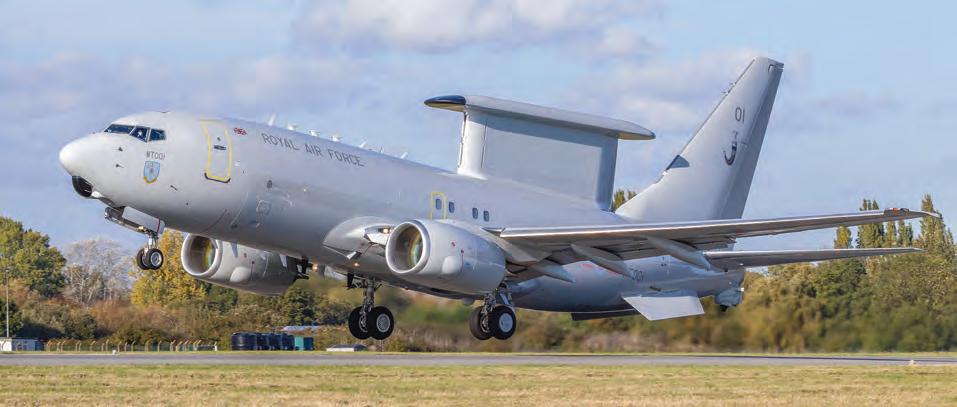
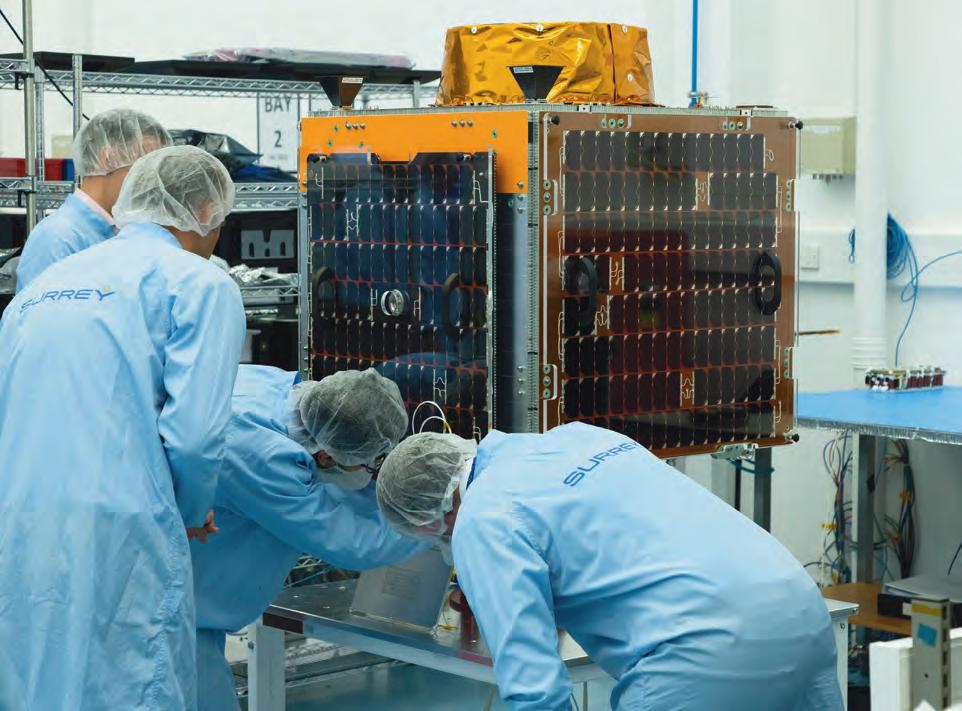
integrated air puzzle when they enter service in the coming years.
The DE&S Arti cial Intelligence (AI) & Automation Centre has also supported the RAF by using multiple AI tools to import and analyse historical engineering data to ease the burden of scheduled maintenance, saving potentially thousands of hours across the eet.
Space is crucial
Alongside the traditional domains of land, sea and air, space is now just as crucial. Exploiting and integrating space a ords us operational advantage against potential adversaries and helps to protect our way of life. From space we can deliver global command and control, communications, precise navigation and intelligence, surveillance and reconnaissance (ISR).
DE&S’ Space delivery team is working closely with UK Space
“Exploiting and integrating space a ords us operational advantage against potential adversaries and helps to protect our way of life”
Command, Strategic Command and other Ministry of Defence stakeholders to research safe and secure alternatives to global positioning systems, all the way up to procuring sovereign ISR satellites such as Tyche, which launched last year and has already captured imagery as it orbits Earth.
The Borealis command, control and data-processing system will help to better monitor and protect our satellites, and we are excited to see the future launch of Juno and Oberon, which will also strengthen the UK’s ISR potential with their advanced imagery and Synthetic Aperture Radar (SAR) sensors.
At DE&S, we recognise how exciting the opportunities within the air and space domains are, given the volume of cutting-edge technologies and capabilities being developed to meet the ambitions of the Chief of the Air Sta and the Defence Space Strategy.
This will be underpinned by the pressing need for even greater levels of integration across domains. We are in lock-step with our defence partners – whether in the lab, on the front line or in industry – and we remain committed to delivering for Defence, Today, Tomorrow, Together.
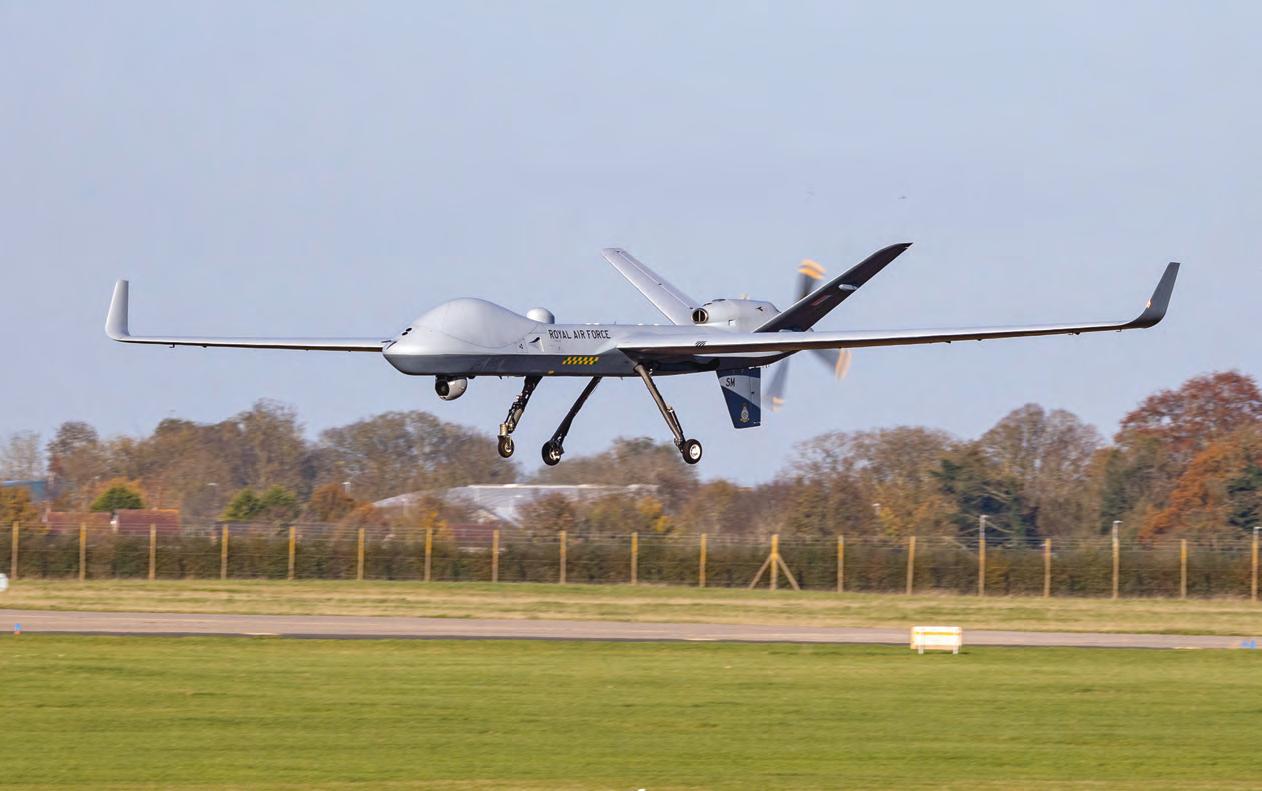
Protector RG Mk 1 (MQ-9B)
INTRODUCTION TO SERVICE
The RAF’s ISTAR Force Commander, Air Commodore Nick Paton, o ers an update into the work being undertaken to introduce the Protector RG Mk 1 RPAS (MQ-9B) into service at RAF Waddington
The Protector MQ-9B enters service with the RAF this year, representing a leap forward in the UK’s Remotely Piloted Air System (RPAS) capability. It will replace the Reaper MQ-9A, which entered service under an Urgent Operational Requirement to support troops in Afghanistan and, subsequently, spent 18 years on continuous operations both there and in the wider Middle-East region.
provide persistence, reach, ubiquity and exibility through global freedom of action. With its enhanced range and endurance, Protector will be able to deliver multi-domain Information, Surveillance, Target Acquisition and Reconnaissance (ISTAR) missions across the Euro-Atlantic region from its home base in the UK, and deploy rapidly to forward operating bases with a minimal footprint.
The rst ight of Protector Mk 1 (MQ-9B) RPAS at RAF Waddington took place on 17 November 2023
(PHOTO: MOD/ CROWN COPYRIGHT)
The advent of RPAS operations had a signi cant impact on the evolution of air power, which has been captured by a wide range of operators and academics. A world in which uncrewed systems are absent from the battlespace is now almost impossible to imagine.
Protector will take RPAS operations to the next level. It is far more than just a replacement for Reaper; it o ers a sovereign capability that will
In addition to a comprehensive suite of upgraded sensors, Protector will be equipped with the Paveway IV 500lb-class bomb, which is capable of GPS, laser and inertial guidance. It will also be the lead integration platform for the UK’s Brimstone 3 laser-guided missile. This low-collateral, direct- re weapon is vital to the UK’s ability to engage small, moving targets with lethality and precision, even
in urban environments, without undue risk to surrounding personnel or infrastructure. Protector has a number of features worthy of note that will make it di erent to test, train on and operate.
Automatic take-o and landing capability
Both Reaper and Protector are controlled via an uplink and downlink over satellite communications (SATCOM). For Reaper, the short delay over SATCOM meant that a Launch and Recovery Element (LRE) was required to provide a low-latency, line-of-sight link to the air vehicle to safely complete the take-o and landing phases. This required a signi cant forward deployed footprint of infrastructure and personnel, which reduced its agility to deploy. However, unlike Reaper, Protector will have an Automatic Take-o and Landing Capability (ATLC), which negates the need for an LRE. In short, the air system will simply take o and land itself according to a prede ned pattern before the operator takes command of it.
As well as reducing the planning and logistical burden, ATLC will o er Protector increased agility and responsiveness to deploy and operate around the globe. The air system can be regenerated with a very minimal footprint of engineers and suitcase-sized supporting equipment. This ATLC capability requires a signi cant level of assurance, but has already been proven.
However, ATLC also changes the training requirement signi cantly. Traditional training programmes invested signi cant time and resource to instruct pilots for routine take-o , landing and circuit ying, given they are the most safetycritical stages of ight. Although Protector pilots will still be trained in emergency procedures and manual forced landings, they will require far less
because the air system will do this automatically. This will allow a leaner training programme for Protector pilots, with more focus on other skills such as airspace awareness, communication, systems management and tactical manoeuvring.
Reaper was not certi ed to operate in UK airspace. By contrast, Protector will be certi ed to operate in Class A to C airspace, which means it will be integrated into the air-tra c environment like any crewed aircraft. Protector will be the rst air system in the world to be certi ed, so it is breaking new ground with the UK aviation authorities.
The certi cation will meet rigorous design, test and evaluation standards in order to assure regulators that it can integrate seamlessly with other military and civil aircraft, thereby allowing it to transit and be operated far more permissively around the world. The generation of evidence to support certi cation has created an enormous amount of work, but the potential operational bene ts to underpin its global freedom of action are clear.
Enhanced abilities
From a training perspective, operators will require an enhanced level of airmanship and airspace awareness in order to integrate Protector into the global airspace infrastructure. Partly in recognition of this evolution, the RAF no longer recruits RPAS pilots separately from pilots for crewed systems; trainees will be streamed RPAS just like fast-jet, rotary or multi-engine based on their particular balance of handling aptitude, airmanship and capacity.
This will imbue Protector operators with the same basic skills as those required of any crewed platform. They will undergo a comprehensive Instrument Rating Course to qualify them to
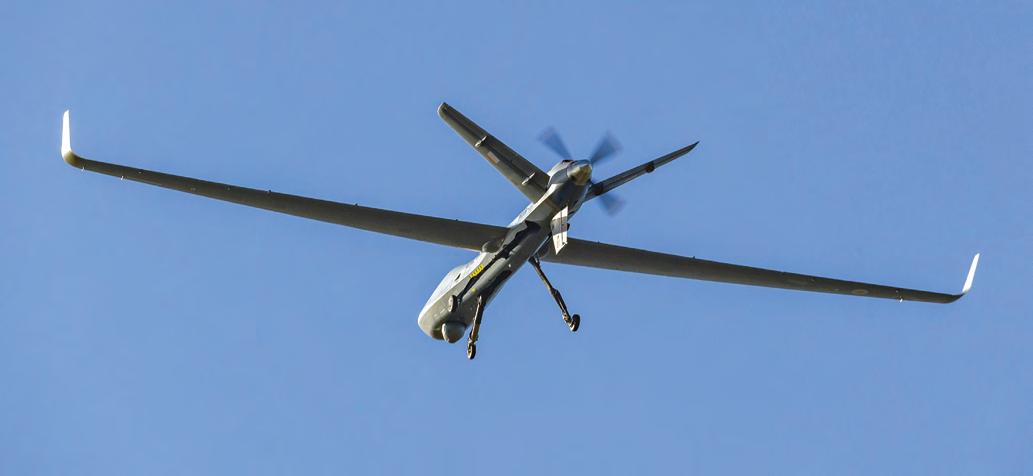
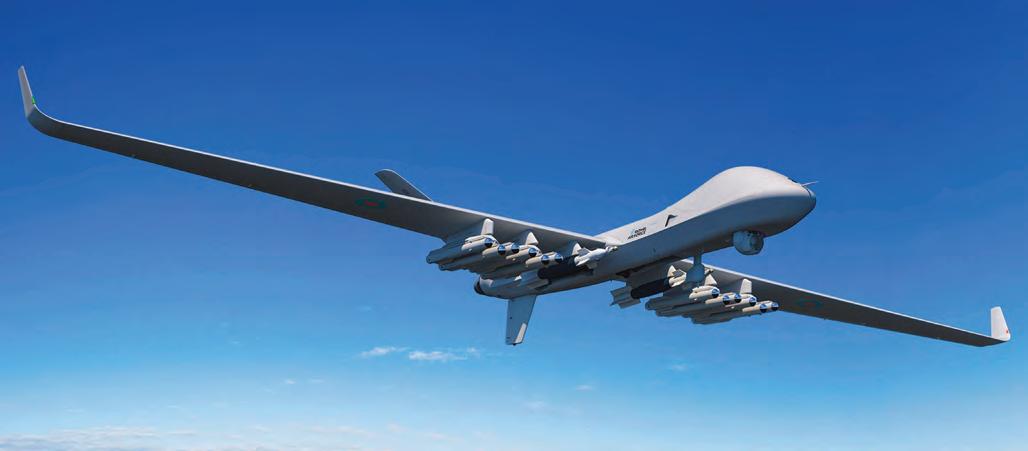
operate in all classes of airspace with the same appreciation of air tra c services, co-ordination measures and radiotelephony. From a training point of view, one might better conceive the skill sets required to operate Protector as more akin to ‘operating a Shadow Mk 1’ (based on a twin-seat Beechcraft King Air) rather than a Reaper MQ-9A.
Preparation for employment
As Protector enters service it will o er new choices to senior leaders for operational employment. With its range, persistence and suite of capabilities, it will be able to support operations across Europe from the UK with the ability to switch seamlessly between tasks. For example, it could provide maritime surveillance and reconnaissance deep into the Euro-Atlantic, or project eastwards into the Baltic Sea, where Russian surface vessels have been damaging underwater infrastructure. Hence, preparations for employment require a new mindset with respect to persistence and agility.
With an air system that can operate constantly for over 24 hours per sortie, it will require a carefully planned roster of pilots, sensor operators and Mission Intelligence Co-ordinators (MICs). For example, for a single mission, one might envisage four separate crews – 12 operators – each operating the air vehicle for at least six hours plus handover time.
Remotely piloted aircraft may be uncrewed, but they are nothing if not labour intensive. With two task lines, Protector will require around 24 available, combatready personnel per day to operate it, in addition to supervisors, instructors and authorisers. By the time Protector grows to full strength, it will constitute over 50% of the whole ISTAR Force’s pilot cadre.
Of course, preparation for employment extends beyond just personnel and equipment. Of note,
Protector will epitomise the way in which warfare is evolving to become data-centric. Critical to unlocking its potential is the availability and resilience of its datalinks. Protector is equipped with High Data Rate (HDR) and Low Data Rate (LDR) links to operate the air vehicle and transmit back to the Ground Control Station the enormous amount of information that it can collect including Full Motion Video (FMV) and images from its Synthetic Aperture Radar (SAR).
Reliance on networks
However, data-centricity also requires a supporting digital architecture so that information can be Processed, Exploited and Disseminated (PED) to an end-user at the speed of requirement at the right classi cation. High-bandwidth, low-latency networks will get the Protector ‘feeds’ to the analytical experts in No 1 Intelligence Surveillance and Reconnaissance 1 ISR Wing, who will analyse, fuse and use Protector’s data.
1 ISR Wing is the UK ISTAR Force’s organic unit with the ability to ingest and ‘PED’ multi-source intelligence to get the right data to the right user at the right time, including our allies and partners. To use a mantra from the well-known American author Stephen Covey, to “begin with the end in mind” will ensure there is su cient focus on data, networks and the end user to exploit the value of Protector’s capabilities across the integrated force.
As global events continue to stress the international community and invite further analysis of our own security and resilience, Protector thus has huge potential to o er our politicians and senior leaders exibility, agility and, if necessary, lethality to bring understanding and in uence to areas where we seek to protect our national interest.
Leading a new generation of UAS
Jonny King
Vice President, General Atomics
Aeronautical Systems UK
When will Protector achieve its RAF IOC and start taking on Reaper taskings?
The RAF is building its crews for Protector through a rigorous training process using a mix of synthetic training systems and live ying. The goal is to build up su cient crews and familiarisation with the new Protector system to allow No 31 Squadron to deploy Protector later this year. Also important to this is the ongoing installation of the ground control stations and full support services at RAF Waddington, integration and test rings of the new UK weapons, namely Paveway IV and Brimstone, and full certi cation of the end-to-end system by the Military Aviation Authority.
How has GA-ASI been adapting its capabilities to cover increased maritime applications?
For many years, GA-ASI has provided maritime mission kits for our aircraft to enable maritime ISR. Our MQ-9B SeaGuardian is the Protector equivalent for maritime operations. Depending on customer requirements, the mission t includes a dedicated 360-degree maritime radar, ELINT, ESM and SIGINT sensors, AIS, sonobuoy command and control with onboard acoustic processing, and sonobuoy dispensing pods that allow up to 40 A-size or 80 G-size buoys to be carried and deployed. Additionally, we are developing new Short Takeo and Landing (STOL) folding wings and tails that can recon gure MQ-9B/Protector to operate from short
runways, including aircraft carriers, speci cally those that do not have catapults and arresting gear. This enables aircraft carriers to operate MQ-9B STOL as an organic capability, leveraging the vast array of Protector and SeaGuardian mission sets. In November 2023, we proved the concept on HMS Prince of Wales with our slightly smaller Mojave demonstrator aircraft, which took o and landed on the ship. Mojave later ew from an even smaller ight deck aboard the South Korean amphibious warship Dokdo
As the MQ-9B community continues to grow, where do you assess further opportunities?
In addition to North America and Europe, a big growth area has been in the Indo-Paci c. We have been operating our systems as a service for long-distance, long-endurance maritime surveillance in both Japan and India,
and these have turned into substantial sales orders. We continue to expand the mission equipment that can be selected by customers, with Airborne Early Warning (AEW) radars being a capability currently under development and attracting a lot of interest. We also have proliferated Low Earth Orbit (LEO) satellite capability that allows our customers to operate in the Arctic.
How can GA-ASI’s USAF CCA programme inform other air forces as they seek to develop their own Autonomous Collaborative Platforms?
The US Air Force’s selection of our Collaborative Combat Aircraft puts us at the forefront of this new generation of Unmanned Aircraft Systems (UAS). We cannot talk much about how other forces might adopt these systems, but we can con rm there’s a signi cant degree of international interest.
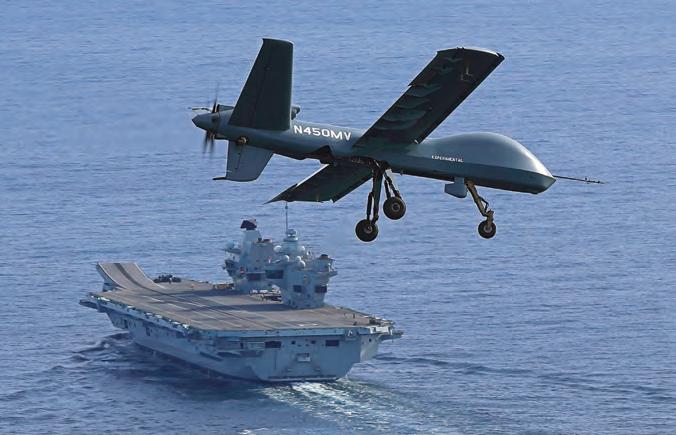
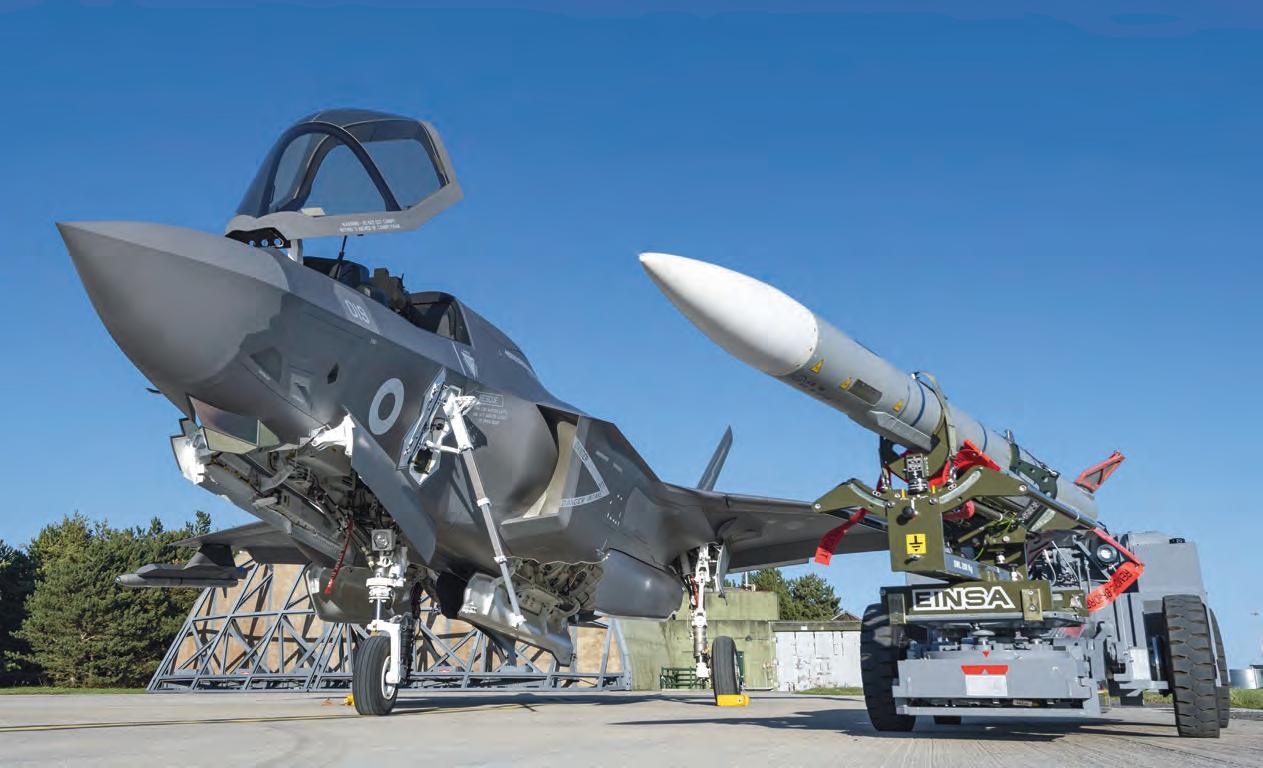
UK air e ectors
NOW AND THE PLAN FOR THE FUTURE
Air Commodore Alun Roberts, Head Air to Air Missiles in the Future Military Capabilities Strategic Programmes department at the Ministry of Defence, highlights the need for a transformative planning and development roadmap in the crucial area of air-launched missile systems and other air e ectors
The UK’s air-launched munitions inventory, shaped by years of counter-insurgency operations, is undergoing a critical shift to meet the demands of peer and nearpeer con ict. Legacy systems – such as Paveway IV and Brimstone, designed for precision in permissive environments – are less viable in contested airspace due to their limited stando range and survivability.
Long-range air-to-air combat capability is provided by the Meteor missile (PHOTO: MBDA)
In the air-to-air domain, the RAF maintains a capable mix: Meteor for long-range engagements, AMRAAM C5 and D for medium-range threats, and ASRAAM Block 4 and 6 for close combat. While this provides a strong baseline, concerns persist around stockpile volume, resilience and adaptability for sustained, high-tempo con ict.
Recent con icts, especially the con ict in Ukraine, have prompted a strategic reassessment
of both the quality and quantity of air e ectors. Mass, once seen as secondary to precision, is now recognised as a critical enabler of enduring combat e ectiveness. In response, the RAF is embracing force multiplication through autonomous collaborative platforms – a shift that promises not just e ciency, but survivability and operational tempo. The recent elding of StormShroud, an autonomous system designed to operate in swarms or alongside crewed platforms, introduces a new dimension of war ghting for the RAF.
The SPEAR Programme
In the air-to-ground domain, the Selective Precision E ects at Range (SPEAR) re ects a strategic pivot to systems with greater range, agility and survivability in contested environments:
– SPEAR Capability 3 o ers a tactical missile optimised for the suppression of enemy air defences.
– SPEAR Capability 4 is a refurbishment of StormShadow to retain the UK’s strategic air-launched deep-strike options.
– SPEAR Capability 5, still in development, is a next-generation cruise missile. Its two concepts – the low-observable TP15 and supersonic RJ10 – are intended for exible deployment across air and maritime platforms.
Future Air Superiority E ectors (FASE)
The FASE programme is being developed to address a full spectrum of aerial threats – from drone swarms to stealthy, high-end ghters operating in advanced electronic warfare environments. FASE will focus on modularity, networked e ects and compatibility with both manned and autonomous platforms, reinforcing the RAF’s competitive edge in future air combat.
The Strategic Defence Review (SDR) and the Defence Industrial Strategy (DIS)
Setting the framework for our future posture, the SDR and DIS signal a welcome shift toward sustained rearmament, industrial resilience and greater strategic autonomy. The SDR outlines key
initiatives: six “always-on” munitions factories backed by a £1.5bn pipeline, a stockpile target of 7,000 long-range missiles, and a planned rise in defence spending. The DIS is expected to complement these aims by prioritising sovereign production of complex weapons and critical systems while also seeking to strengthen supply chains and accelerate the transition from development to deployment.
However, while the SDR and DIS provide a valuable foundation, we must be honest with ourselves about whether the scale and pace of the challenge – from accelerating threats to global supply chain pressures – may exceed what current plans can deliver. Stockpile depth, industrial surge capacity and long-term resilience require levels of output and coordination that are di cult for the UK to achieve alone.
This raises a broader strategic question: can the UK independently meet the full spectrum of industrial demands posed by modern high-intensity con ict? If not, then a meaningful recon guration of the European defence industrial base may be necessary. As deeper UK–EU cooperation becomes more politically feasible, collaborative development, shared production and integrated logistics should be seriously considered. The UK has the strategic credibility and industrial depth to help lead such a transformation.
RAF F-35s can carry a mix of weapons, including Meteor and ASRAAM, to cover both long- and shortrange combat (PHOTO: MBDA)
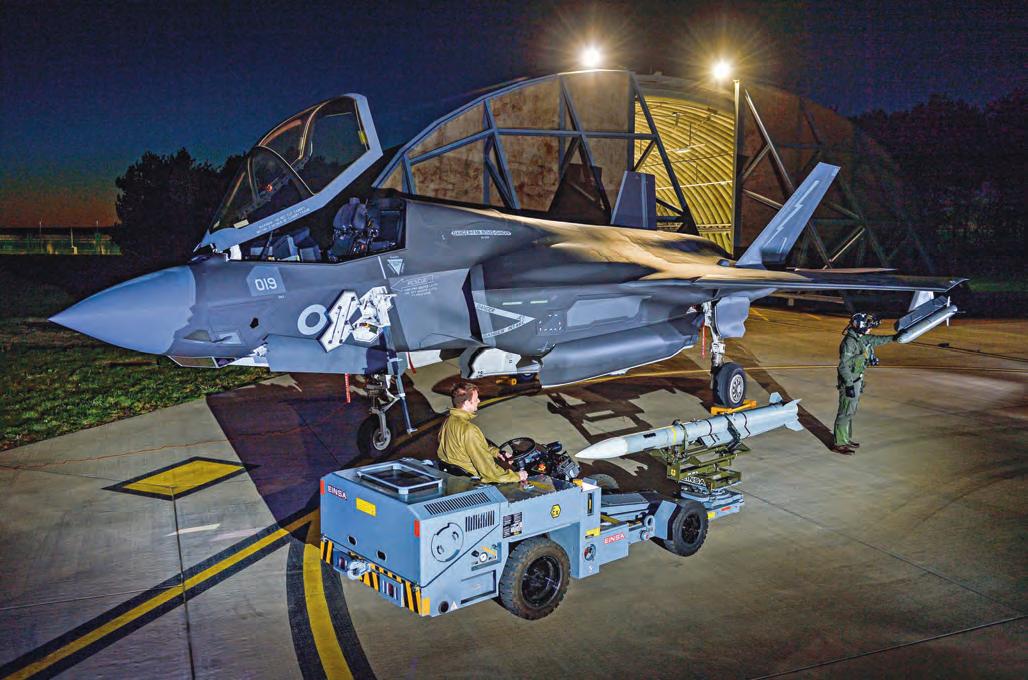
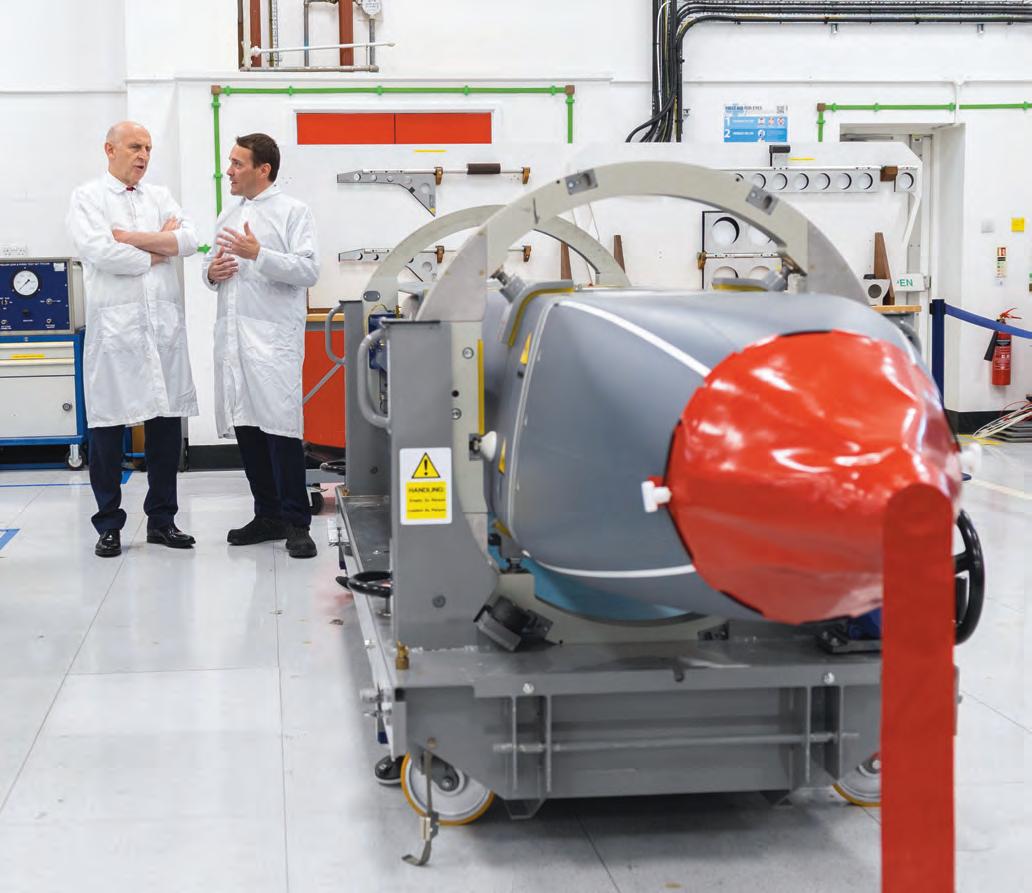
Secretary of State for Defence the Rt Hon John Healey MP (left) visits MBDA’s Storm Shadow cruise missile production facility in Stevenage (PHOTO: MOD/ CROWN COPYRIGHT)
In sum, while the SDR and DIS set an important direction, they should be viewed as frameworks to be built upon. They re ect intent – but e ectiveness will depend on our willingness to go further, adapt faster and think more ambitiously about European collaboration in an increasingly contested world.
The European context
Prime Minister Sir Keir Starmer’s renewed engagement with Brussels indicates a pragmatic interest in deeper UK-EU defence cooperation. Although politically complex, such partnerships are increasingly essential. Europe’s security is indivisible, and the UK remains a critical player due to its industrial base, strategic outlook and operational credibility.
The current geopolitical landscape – marked by concerns over US commitment to NATO under a second Trump administration – makes this alignment even more important. The UK’s
vision for interoperable, but sovereign defence capabilities positions it as a natural leader in building a resilient European defence ecosystem.
The RAF’s evolving air e ector roadmap represents more than just technological upgrades. It re ects a deliberate shift toward sustained, high-tempo, multi-domain operations supported by domestic industrial capability and underpinned by autonomous force multipliers like StormShroud. SPEAR and FASE are not only future-proo ng UK air power – they’re recalibrating it for a new strategic era.
By integrating capability development with political intent and industrial strategy, the UK is laying the groundwork for a more self-reliant, strategically credible, and operationally agile air force.
The transformation is under way – but the pace must accelerate. The changing nature of warfare is unforgiving. For the UK, adaptation is no longer optional – it is imperative.
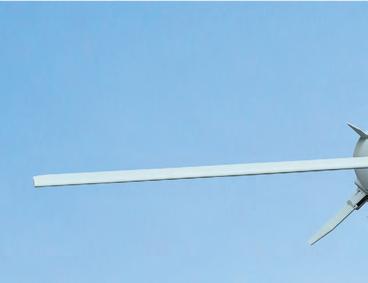

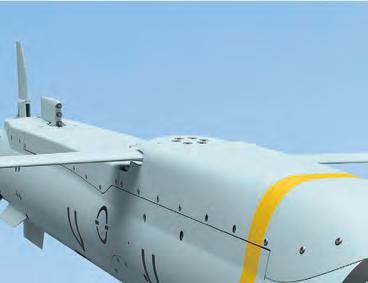
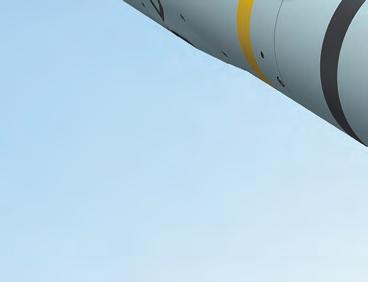
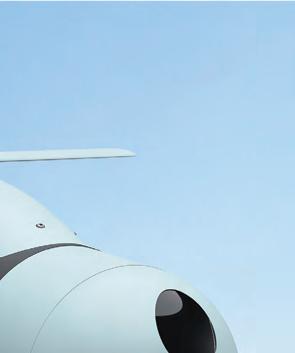

The high-low weapons mix
A VIEW FROM INDUSTRY
Tom Wallington, head of the Air Domain for UK Sales and Business Development at MBDA, explains the opportunities that a high-low mix of weapons systems can deliver in terms of performance, time and cost
The term ‘high-low mix’ is at the forefront of defence in 2025. However, it dates back to the 1960s and the work of military strategist John Boyd. Originally, it was focused on the need for a blend of combat aircraft. The term is now used more broadly across military capability.
For MBDA, the need for a high-low mix rmly extends to munitions and their supporting enablers. It should not only be about considering individual weapons performance and unit price though. It also needs to consider development and integration costs, along with both manufacturing and scaling times, to allow for potential changes in demand.
Performance
The advanced capabilities delivered by ‘high-end’ e ectors will be required for as long as the challenges of Anti-Access/Area Denial (A2/AD) and very long-range
threat systems remain in place. This can be seen in current con icts through the strategic impacts o ered by deep-strike weapons such as Storm Shadow, despite the prevalence and success of cheap drones and rapidly developed one-way e ectors. Indeed, the most potent future air-defence systems and targets are driving the enduring requirement for ‘high’ capabilities such as the Future Cruise/AntiShip Weapon (FC/ASW), the low observable variant of which is due to ful l the RAF’s Selective Precision E ects at Range (SPEAR) Capability 5 requirement.
Of course, the use of less advanced weapons in isolation from high-end capabilities remains an important part of the mix. The most obvious bene t they bring is the increase in mass that can be achieved, along with their cheaper ‘cost-per-kill’ against lower-end threats such as attack drones. Indeed, the dawn of autonomous
SPEAR Glide is an example of the reductions in cost and time using a ‘weapons family’ approach can deliver (IMAGE: MBDA)
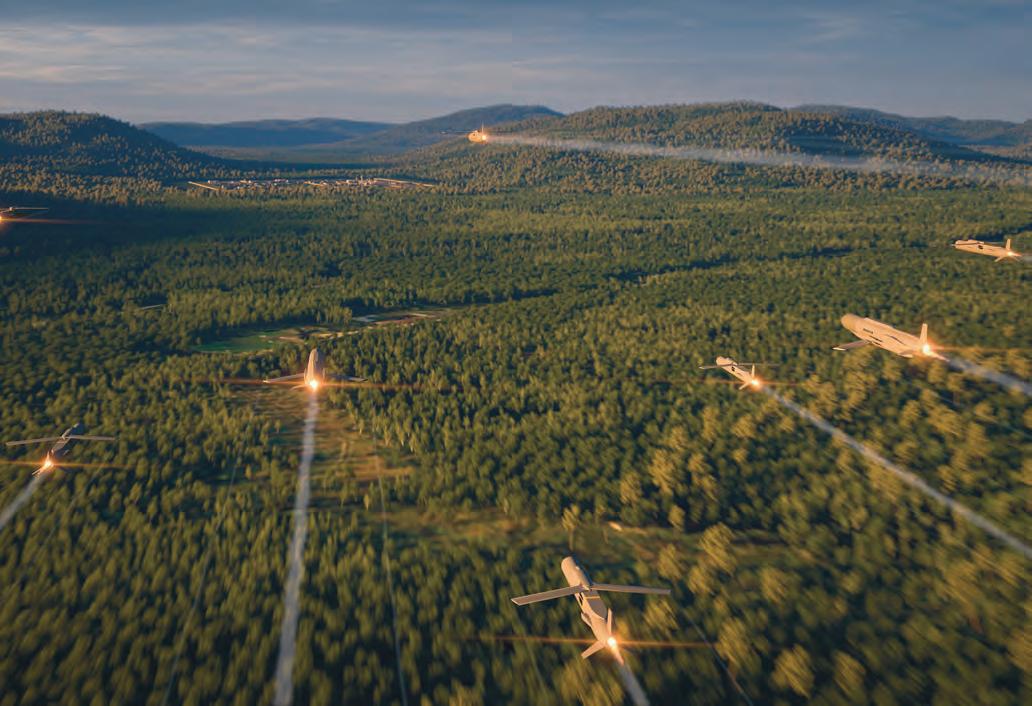
collaborative platforms (ACPs) has demonstrated the Western air forces’ recognition of the need for mutually supportive low-end capabilities in the form of disposable ‘tier 1’ platforms. However, when integrated e ectively, using these lowcost systems alongside high-end weapons can bring the greatest military bene ts, contributing more than just the sum of their parts.
It is not just about operational choice though. Low-end systems can not only supplement but, in many cases, actually increase the level of the high-end stockpile performance, delivering a greater overall lethal e ect at the optimum time.
The cooperative bene ts of systems such as MBDA’s Orchestrike leverage this by introducing advanced tactics into even the most basic of e ects to optimise the success of multilayered engagements.
Cost
While there is a general expectation that the lower the performance requirement, the lower the cost of the weapon needed, it is worth considering how this saving really manifests itself. Broadly, the cost of munitions can be split into two categories: non-recurring cost (NRC) and unit production cost (UPC). As with many industries, complex weapons bene t from economies of scale
and, therefore, generally the purchase of a larger quantity will yield a reduction in UPC and overall price of acquisition. However, the relationship between NRC and UPC should also be considered when discussing a high-low mix.
For example, in order to achieve extremely low UPCs, there may be a need for a greater initial investment in certain areas of NRC, such as novel manufacturing techniques, mass production facilities and development of arti cial intelligence to maximise e ciency. In the case of spirally developed weapon families, huge UPC savings can be made, compared to the ‘donor’ weapon, if the right blend of NRC is invested upfront in order to achieve a design that meets the required sweet spot in the performance/cost/time relationship.
The trades being made compared with starting a whole new weapon design also need to be considered, but frequently this approach can yield the cheapest overall capability. MBDA used this approach to develop SPEAR Glide into a weapon that, despite appearances, is radically di erent to its parent weapon (SPEAR 3), unlocking a far lower UPC and total cost of acquisition than many people assumed possible.
Of course, many other factors make up the total cost of acquisition for a weapon system. Two that should be in the forefront of our minds
when considering the high-low mix are platform integration and through-life support costs. Frequently, these are considered secondary to the primary drivers of NRC and UPC; however, if approached correctly, these lead to signi cant cost savings.
For example, capitalising on read-across from ‘near-neighbour’ weapons can yield major savings in integration, not only from reduced clearance activities, but also through utilising existing aircraft interfaces and software that would be costly to adapt. Equally, the reduction in through-life costs from using a ‘family’ approach to weapons and commonality of supporting infrastructure – such as weapon loading, storage and test equipment – can be powerful. SPEAR Glide exploits both of these elements for maximum e ciency, with potential bene ts on multiple platforms for customers, adopting a ‘good enough’ approach while ensuring SPEAR 3 can still meet the ‘high-end’ requirements alongside SPEAR EW as an enabler for either.
Finally, the cost related to the total quantity of weapons required for a given operational scenario should be considered in the frame of a high-low weapons mix. Generally, higher-end weapons will feature greater survivability measures than those at the lower end. As such, a greater number of cheaper weapons may need to be employed in order to ensure a su cient number reach the target and achieve the desired e ect. When compared with a lower quantity of more expensive but highly survivable weapons, the economic bene ts of the low end may be signi cantly eroded.
Time
Traditionally, the development of military capability has followed a linear ‘CADMID’ (concept, assessment, demonstration, manufacture, in-service, disposal) cycle. Although the notion of ‘spiral development’ has been in existence for some time, iterations of design have often occurred reactively during a weapon’s lifetime. Nonetheless, the bene ts of this approach have been proven in recent years, on programmes like Brimstone. However, the fast pace of emerging technologies requires new approaches.
MBDA and the UK Ministry of Defence (MOD) are now taking the principle of spiral development further, balancing the need to get initial capability into service as quickly as possible, with the pursuit of increased requirements as time progresses. A good example of this is FC/ASW, which has been designed from the outset with di erent ‘blocks’ based on growing capability needs, technology maturity and breadth of air and maritime launch platforms. Once a weapon has been developed, the time required for its physical manufacture needs
to be considered. An essential factor in the context of high-low mix is not just the duration of the manufacturing process itself, but also the time taken to scale the manufacture – in order to rapidly replenish stockpiles or to signi cantly bolster output in a move from peacetime production to a wartime footing. It is in these scenarios where ‘low’ capabilities generally have an advantage, in that they may employ a greater number of commercial-o -the-shelf (COTS) components and/or be manufactured in alternative industrial facilities.
There are opportunities to facilitate further dynamic scaling through innovative contracting models and establishing an ‘always-on’ production approach for key capabilities. Demand for this can then be tailored in an agile manner based on emerging needs driven by operational requirements, furthering the bene ts of a portfolio approach to complex weapons and a sovereign industrial base.
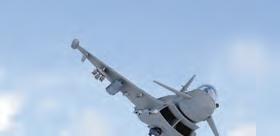
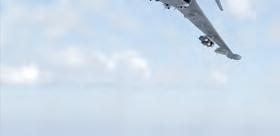

Striking the balance

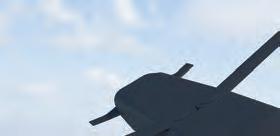

The factors involved in analysing the optimum high-low mix are broad and complex, and reach beyond those mentioned here. However, a conventional and siloed approach to requirements and weapon development is unlikely to yield the blend needed for operational success in the modern battlespace. Industry as a whole has a key role to play in unlocking a new approach, o ering trades beyond the traditional metrics of performance, cost and time that span across a whole portfolio of capabilities, and not just binary choices between individual weapons, to ensure a true high-low mix for the RAF and others.
At MBDA, we are leading the way on this through our strategic partnership with the MOD –delivering capability at pace, t for the future.


FC/ASW balances the need to get capability into service quickly with future performance (IMAGE: MBDA)
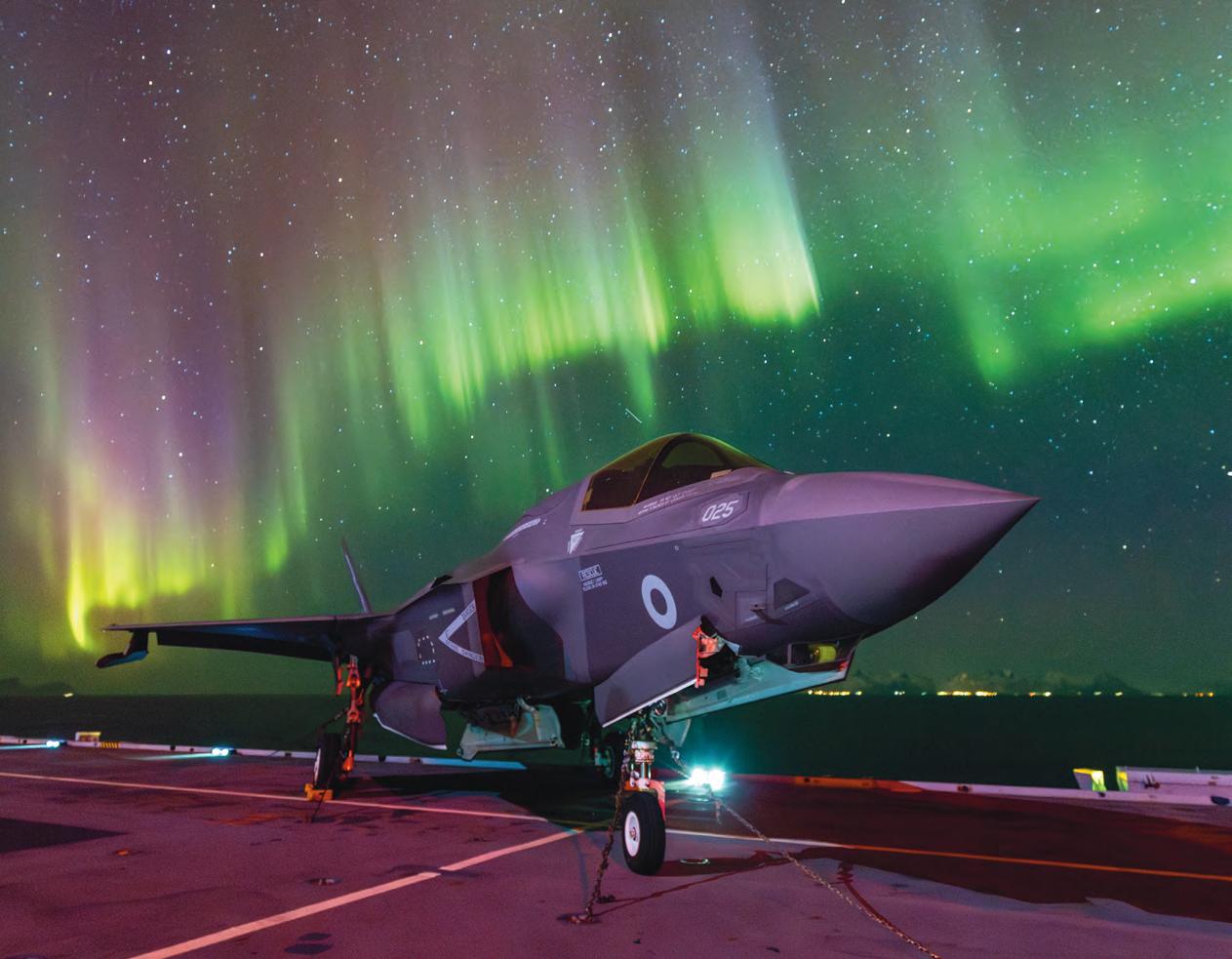
Spectrum warfare
Controlling, developing and using electromagnetic technologies is one of the dark arts of modern warfare. Air Commodore Blythe Crawford, former Commandant of the Air and Space Warfare Centre, highlights the current status of the UK’s capabilities and explains the imperative for UK Defence to become better at this fast-changing speciality
‘WThe electromagnetic spectrum transcends every physical domain (PHOTO: MOD/ CROWN COPYRIGHT)
hoever owns the spectrum, owns the battle eld’. This was the headline from a recent US WEPTAC (weapons and tactics conference), where the full e ects of spectrum warfare were exposed to war ghters, red-teaming how we might ght in future peer-on-peer con icts. There’s nothing more depressing than being alone in your jet, 500 miles out to sea where, with a call of ‘ ght’s on’, your radar lls with noise and your radios suddenly become full
of static; your navigation system jumps 1,000 miles east, and then, to cap it all, you’re called ‘dead – kill remove’, and you start the long, slow transit home having not red a shot or even sni ed the adversary. It will not be any surprise to those who are closely following the war in Ukraine, but there needs to be wider acknowledgement that, strategically, we have taken a spectrum ‘holiday’ for the past 30 years, when we pivoted to wars of choice, focused on counterterrorism, rather than keeping up with our peers.
But speak to any helicopter pilot operating in Iraq and Afghanistan, and they will tell you how well their GPS worked and how they had to revert to basic map and compass when their systems failed from low-cost, tactical capabilities employed by terrorist militia.
‘The Battle of the Beams’
We have been competing in the spectrum since the Boer War, a fascinating observation being the British attempt to use spotlights to ‘bounce’ Morse code o the clouds to their colleagues over the horizon at Ladysmith. The Boers soon got wind of this and ‘jammed’ the signals with their own spotlights.
Perhaps the greatest articulation of ‘spectrum warfare’ was that developed by R V Jones during the Second World War, beautifully articulated through Tom Whipple’s book, The Battle of the Beams, in which he combines special operations, spies and mystique with the geeky science of spectrum analysis and manipulation to inspire any teenager (or grown-up): the cat-and-mouse game of measure, countermeasure, counter-countermeasure, and the reluctance to deploy prototype capabilities, in case the enemy exploited them; the piecing together of snippets of information, building a portfolio of evidence to substantiate claims and the constant pursuit of what could be achieved, rather than relying on what one already knows from the past. We constantly revel in the ubiquity of air power; its prevalence across the other domains allows every conceivable target to be within reach. But the electromagnetic spectrum goes further, transcending every physical domain – and let’s not forget how quick we were to embrace cyber, a domain that is wholly reliant on the electromagnetic spectrum for its existence. Yet, pitifully, the letters ‘EMA’, for electromagnetic activities, were desperately bolted onto the back of ‘C’ to leverage some breadcrumbs of the funding that was made available during the cyber revolution of the 2010s.
Spectrum is a zero-sum game
In the civilian sector, embracing the spectrum has been an invisible phenomenon. My 13-yearold’s hierarchy of needs immediately prioritises wi – it is inconceivable not to be connected – but understanding of the spectrum, and our modernday total reliance on it, has passed most people by. Let us not forget then, that the spectrum is a zero-sum game: whatever you own, you deny to others. Society’s complete reliance on it means we must equally balance its provision for day-to-day life against the needs of the war ghter. Indeed, the west’s liberal embracement of globalisation driven by technology means that great swathes of the spectrum are unavailable to the military –
a situation exploited by our enemies as they hide in and exploit areas of the spectrum, such as 4G and 5G. There they can act with impunity through sub-threshold operations, knowing that we cannot counter them, purely due to our own adherence to policy and norms rather than physical limitations. What we do know, though, is that any future peer-on-peer con ict is going to be another ‘battle of the beams’ and that Ukraine is currently home to the most intense electronic warfare environment on the planet, where GPS-guided munitions (which we have all relied on) miss their targets by kilometres rather than inches.
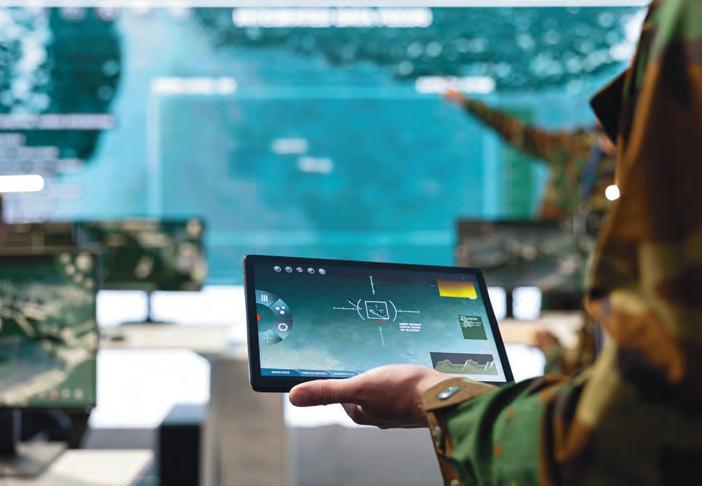
We are already seeing the overspill into every other hotspot around the world. Try going for a run on the coast of Cyprus, where your Strava app will say you’ve run 15 miles in ve minutes, albeit out into the Mediterranean and back, or in the Arabian Gulf where you must revert to maritime navigation by map and compass. Imagine the carnage should that envelope Europe or the UK – all banking would cease, operating theatres could not function, supply chains would fail, electrical power grids would no longer function as they should – the threat to our daily lives is unfathomable.
Understanding reliance on the spectrum
So, what must we do to both provide resilience and, subsequently, exploit the spectrum during wartime? Firstly, some education is needed. Our political leaders, and wider society in general, do not appreciate our reliance on the spectrum and our vulnerabilities within it. The foundational importance of spectrum education cannot be overstated in preparing future generations to harness the potential of cyber
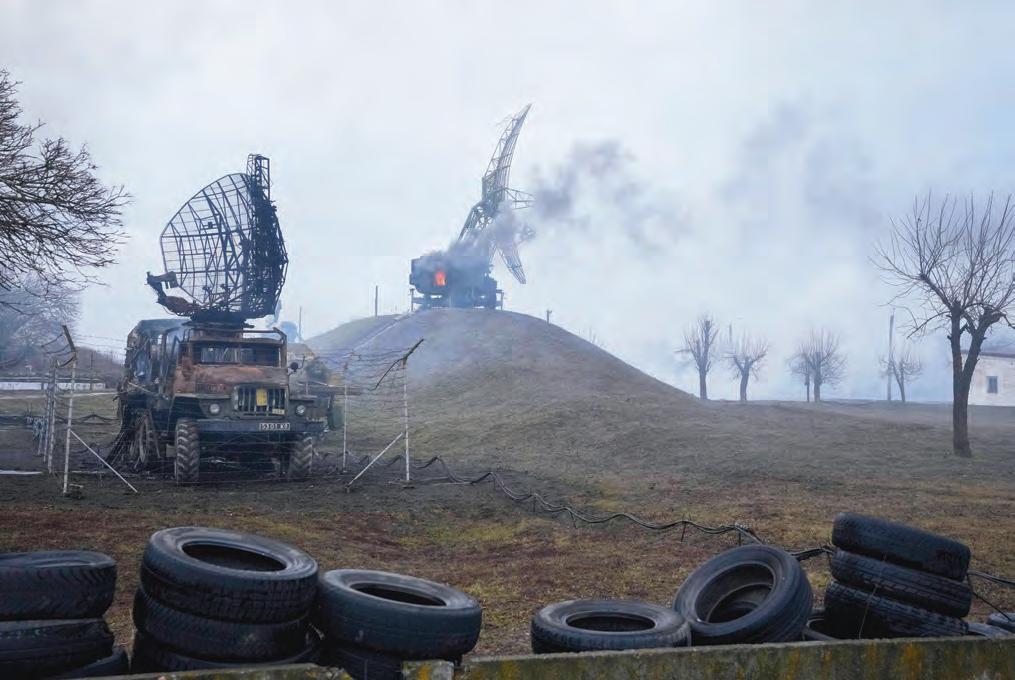
(PHOTO:
operations and arti cial intelligence (AI) technologies. By introducing electromagnetic spectrum literacy in high-school and university curricula, we can cultivate a pipeline of talent ready to lead in this critical domain, and across the NATO Alliance.
Such early engagement primes students to view electromagnetic warfare (EW) not just as a technical discipline, but as a cornerstone of broader technological advancements. Building this knowledge base is essential for fostering innovation, resilience and operational superiority across domains. Then, with respect to war ghting, education and training are crucial in equipping individuals to tackle the challenges of modern con ict, where dominance in the spectrum will dictate operational success.
Train as we ght
A principle of ‘train as we ght’ must be upheld, ensuring that personnel are prepared to operate e ectively under real-world electromagnetic conditions. The imperceptible nature of electromagnetic activity – being unseen and unheard – should not lead to it being undervalued as merely negative training. Instead, this domain demands a rethinking of conventional learning paradigms to focus on proactive understanding and strategic mastery. Synthetic environments provide unparalleled opportunities to simulate complex electromagnetic scenarios, enabling a high- delity, risk-free environment for skills development and experimentation.
One of our greatest challenges, though, is how to command and control it. Such a reliance by civil society on the spectrum creates signi cant vulnerabilities, and also hampers our room for
manoeuvre. There will have to be compromises on both sides, and signi cant investment in spectrum resilience, already seen in Ukraine today.
While other domains lend themselves to centralised command, the ubiquity of the spectrum would render this approach impossible. However, it is clear that prioritisation and decon iction is necessary. Israel has recently established a cell to do just that, where priority missions and actions are allocated bands of the spectrum to ensure operational success, but then di used for broader use post-mission.
The NATO JEMSO (Joint Electromagnetic Spectrum Operations) model follows this approach. Here, there are opportunities for modern technology to assist: AI can allocate unused bands of the spectrum and prioritise in an agile way to ensure maximum exploitation while providing resilience. Large data analytics can also assist with spectrum analysis and exploitation, enabling the rapid and optimised use of the data. Here, Defence needs to respect the signi cant leaps forward made in the civilian sector and not be too proud to exploit dual-use technologies that already surpass military capability, such as in the banking and IT sectors.
China is watching
And, nally, innovation. The past three years in Ukraine have taught us that the bad guy is not 10 feet tall, we are not 30 years behind, and the electromagnetic spectrum provides us with the opportunity to develop phenomenal military e ect, for little cost and at a scale that dwarfs conventional weapon development. Measure to countermeasure can be measured in weeks; capabilities developed for single- gure dollars, and their prevalence on the battle eld, have created a no-mans-land of tens of kilometres where nothing can survive.
And it’s not going to get any better. We are not the only people learning from Ukraine – while Russia has completed over 20 iterative cycles of EW development over the past three years, China has been watching. A con ict in the South China Sea would pale Ukraine into electromagnetic insigni cance.
I conclude by referring back to the legend of R V Jones, at his lonely desk near London’s Victoria station, driving the ‘battle of the beams’ as a oneman band. He was a visionary, a believer in the art of the possible, with an innate ability to join the dots and make sense of the inconceivable.
A previous Minister for the Armed Forces referred to “the war ghter ninjas of the Air and Space Warfare Centre, huddled in a basement with wet towels on their heads, concocting the latest electromagnetic countermeasure”. Please, don’t let them do it alone, history has a habit of repeating itself.
Committed to innovation and technical excellence

Ed Bowden-Peters Technology Watch Lead, MBDA
How does MBDA ensure it can address current and future threats?
At MBDA, we are committed to pushing the boundaries of what is possible in defence. Our commitment to innovation and technical excellence is evident in every aspect of our work as we continually examine technologies and solutions that can deliver operational value to our customers.
To improve the performance of our complex weapon systems, we investigate technology, integration, the concept of use and the economic model. We also explore all the ways we can incorporate innovation into our systems, including incremental improvement, pioneering solutions and niches that could complement our product portfolio.
Our approach blends operational requirements, industrial strategies,
creative ideas, cutting-edge technologies and legacy products. This synthesis of elements leads to the creation of groundbreaking solutions that o er tangible operational value.
Crucially, our strong partnership with our customers plays a pivotal role in fostering, guiding, supporting and facilitating our innovative approaches. Our customers are integral members of our innovation ecosystem. Their input and feedback help shape our path, ensuring that the innovations we deliver align perfectly with their evolving needs and requirements.
How does MBDA innovate to ensure its systems are best in class?
We have a creative and entrepreneurial attitude embedded in our culture at MBDA. We understand that innovation thrives when our workforce is encouraged to think creatively and think outside the box. We have dedicated programmes and funding to nurture their ideas and provide them with the time and resources they need to transform these ideas into the next generation of MBDA products.
We are driven not only by bringing our innovations to market – a driver of our success is cooperation. We recognise that innovation knows no bounds and, as such, we work to tap into the diverse expertise available. We aim to incorporate knowledge, methods and technologies that exist outside MBDA, enabling us to continually develop, adapt and adopt new technologies as they emerge.
What are the typical areas for external collaboration?
Collaboration enables us to develop innovative concepts and deliver gamechanging solutions. We collaborate with small and medium-sized enterprises (SMEs), research institutes, academia, suppliers and our customers. Through systematic technology scouting and calls for ideas, we identify hundreds of potential partners every year.
Following an initial evaluation, we engage with the most relevant and promising potential partners. After initial exploration, projects continue further in an R&D programme, funded projects, or venture capital investments. This approach is essential for accurately understanding future technologies and their application to our customers’ needs.
Can you describe some of the technology solutions that underpin the innovation process?
At the core of our innovation process are advanced technologies and capabilities. We continually explore and develop the most advanced technologies across a wide range of technical domains. We carefully monitor areas such as arti cial intelligence, connectivity, cooperative engagement, sensors, antennas, materials, virtual and augmented reality, quantum technologies, cybersecurity and safety technologies, and others. Striving to achieve the highest level of performance, we place paramount importance on safety and security, while delivering innovations that empower our customers.

The future operating environment
Air Vice-Marshal Mark Ridgway, Director Defence Futures, outlines the expected changes that will feature in the future operational environment and how UK Defence will need to adapt to address them
WEmerging and disruptive dual-use technologies will alter the global balance of power
(IMAGE: CONO0430/ SHUTTERSTOCK)
hen I mention Defence Futures’ ongoing project to understand the future operating environment for the UK military out to 2040, drones and arti cial intelligence (AI) are what a lot of people immediately think of. While not incorrect, things are also inevitably a bit more complicated. There will almost certainly be drones (or uncrewed systems) and AI in future operations, and their impact will be transformational in the conduct
of operations and warfare. But there will also be many other technological developments and signi cant trends that will a ect the future operating environment. So, our task is a little more nuanced...
Firstly, we want to help policy- and strategymakers, as well as capability and operational planners, to understand the context in which we might encounter those drones and AI alongside a raft of other strategic and operational factors. This means thinking about the complex issues

“We don’t actually try and predict the future, but rather seek to identify plausible scenarios that will most usefully aid policy and strategy-making”
and interacting systems that we explore in Global Strategic Trends Seventh Edition – the changing exercise of power globally, climate, demographics, technology, economic and energy transformations, as well as societal inequalities. We then marry these up with Defence’s top-level concepts, before asking how they might change the operating calculus in the coming decades.
What makes this challenging is that it is not possible to predict the future consistently and accurately. History has taught us frequently that seismic global changes can occur rapidly and, often, unexpectedly. So, we don’t actually try and predict the future, but rather seek to identify plausible scenarios that will most usefully aid policyand strategy-making; thus, what will the Future Operating Environments (plural) look like by 2040?
Within such broad uncertainty about the future, there are helpfully some aspects that we can be fairly con dent about, as they are common to all the plausible scenarios. These commonalities o er us insights and relatively safe bets into how we might design and prepare our forces for the future.
Returning to the opening premise, the continuing march of technology is an obvious one. The arrival of arti cial general intelligence (AGI) and quantum computing will undoubtedly signi cantly impact – indeed, drive – military structures and the conduct of operations; the more so given they are likely to be adopted in di erent ways and at di erent speeds around the world. Similarly, novel weapon systems (yes, many uncrewed) will continue the battle between threats and counterthreats, while new sensors will create the same tensions between transparency and concealment. Intelligence will increasingly be democratised and accessible, as will the risk of misinformation and disinformation be increasingly rife.
Beyond technology
But there are other aspects beyond technology that will impact future operations. Barring a truly cataclysmic event, the global population will continue to grow, but unevenly so (western and East Asian populations will likely shrink, for example). Demographic trends also indicate migration to
The increasing e ects of climate change will lead to international tensions (PHOTO: SUDARSHAN JHA/ SHUTTERSTOCK)
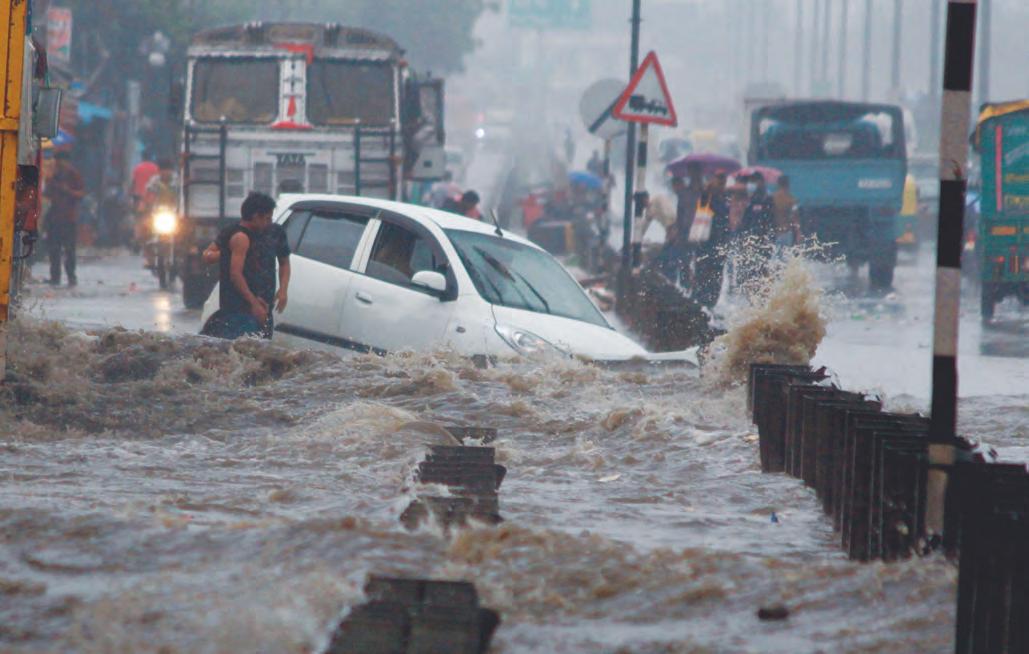
A range of future environments are scoped out in the seventh edition of Global Strategic Trends (IMAGE: MOD/ CROWN COPYRIGHT)
vulnerable coastal cities. In parallel, even the most optimistic projections see global average temperatures continuing to rise to 2040, accompanied by increasingly frequent extreme weather events.
Together, you could get the increased prospect of urban disaster relief involving very complex operations in very complex spaces, potentially in extreme climates, that exend both above and below ground and into the littoral, space and cyberspace. Add to this that these latter two elements are likely to see increasing weaponisation, in one form or another, and deterring potential adversaries will become both ever more important and more complicated.
Strategic resources
Simultaneously, as many economies worldwide transition their energy requirements, so the critical minerals needed to build renewable energy infrastruture will become increasingly strategic resources. There will be a continuing operational and reputational requirement to adopt such fuels for our own equipment, while the scarcity of such

resources can result in competition and (new areas of) con ict. Relatedly, and geo-strategically, nonstate actors will become increasingly prominent, resulting in new emerging dependencies. Rapid dual-use technological evolutions led by the private sector could lead to capabilities and e ects being developed and even used by non-state actors – no longer the sole preserve of states.
Balance of power in 2040
More generally, the prospect of a changing global balance of power is important – if it is hard in 2025 to pin down how things will look, it is even more di cult in 2040. Will China be at least an equal power to the US? How important will transnational and sub-national organisations be, whether companies, cities or even individuals? Arguably most importantly, how will they interact with each other: where will alignments fall, and how much will they trust or mistrust each other, co-operate or compete?
But from this uncertainty it is reasonable to conclude that multifaceted relationships will become more valuable and, necessarily, more exible. Operationally, this could mean working with a wide range of partners in rapid succession. This has consequences for planning and anticipating interoperability issues alongside partners – from technical to procedural to legal and ethical – for capabilities on a range from highto low-tech, and from automated to human.
So, yes, there are game-changing technologies on the way: autonomous systems, A(G)I, quantum computing, hypersonic weapons and much more. Moreover, it is important to prepare to both eld and counter all of these, as well as ensuring that organisations, systems and people have su cient resilience and redundancy to cope with increased strategic and operational complexity. However, we will also need to think about who else might use emerging technologies, how they might use them, and what other factors might a ect the future operating environments.
Preparing for the future
It is the collection of these factors and, perhaps most importantly, their interactions that will accelerate or stagnate their progress and, in turn, determine the impact on future air and space power. In Defence Futures we can’t tell you the precise answers to those questions, but we do explore the possibilities in advance, enabling decision-makers across Defence to prepare for any future. After all, in the words of the American visionary, Richard Buckminster Fuller: “We are called to be architects of the future, not its victims.”
Connected, adaptable and ready
As adversaries advance capability and capacity, air forces can keep pace by prioritising versatile systems and multi-domain integration

Bernd Peters Vice President, Business Development & Strategy, Boeing Defense, Space & Security
During last winter’s December holiday season, those of us in western time zones awoke to an alarming Boxing Day surprise: social media channels lit up with images, video and reports that the PLAAF (People’s Liberation Army Air Force) had revealed not one, but two never-before-seen next-generation combat aircraft. These revelations served as a stark but important reminder of the dramatic pace at which the threat environment is changing.
At Boeing, we come to work every day dedicated to helping our military customers meet this important moment. What can allied air forces do to gain and maintain an advantage against an adversary rapidly advancing in both capacity and capability? Where should scarce and valuable resources be prioritised by global air chiefs and their teams?
Our enduring drive to provide solutions to these challenging questions has resulted in an integrated family of best-in-class aircraft, spacecraft, satellites
and weapons systems that are connected across domains, easily adaptable and ready to win both the ght of tonight and the war of tomorrow. This integrated, holistic approach to our portfolio is best viewed through three mission areas necessary for our customers to achieve and maintain battlespace dominance: Global Control, Global Reach and Global Strike.
Open, integrated systems to control the multi-domain battle eld
Spanning the maritime, land, air and space domains, the Boeing Defense portfolio enables the war ghter to sense, network and dictate – thereby controlling the battlespace and providing a critical information advantage. With a focus on generating accurate and actionable data, facilitating rapid and secure communication between assets, and providing the tools and methods to turn data into action, our family of systems enables resilient, real-time situational awareness, streamlined coordination and precision decision-making. Through state-of-the-art surveillance and command and control systems like the E-7 or P-8, or advanced platforms like FOO Fighter from our Millenium Space Systems subsidiary, Boeing provides the necessary tools to achieve the information advantage critical to outpace the threat.
Solutions to deliver strategic and tactical mobility, while sustaining the ght
Boeing products are well suited to support the war ghter’s mission of Global Reach by o ering improved
connectivity, survivability and agility for strategic, operational and tactical support in high-threat areas. We can o er a wide range of tanking and transport aircraft solutions, like the KC-46 tanker or MQ-25 unmanned refueller, that are speci cally designed to sustain operations, ensure continuous functionality and meet the diverse needs of military forces worldwide. These advanced products o er the necessary range, exible payloads and unique capabilities required for e ective operations in challenging environments. We deliver reliable and adaptable solutions that enhance global mobility, ensuring military forces can project power, maintain operational readiness and overcome the tyranny of distance.
Win the mission of today and deter the ght of tomorrow
Boeing provides a wide range of advanced combat technologies through our manned and unmanned ghter aircraft that are crucial for achieving and sustaining global strike capabilities while deterring adversary action through kinetic overmatch.
Our F-15EX, F/A-18, EA-18G and MQ-28 collaborative combat aircraft all incorporate the latest networking capabilities to project combat power, enhance situational awareness and expedite responses to threats across multiple domains. Now, through the recently announced U.S. Air Force Next-Generation Air Dominance F-47 ghter, we look forward to establishing a new global standard for unparalleled combat aircraft capability.
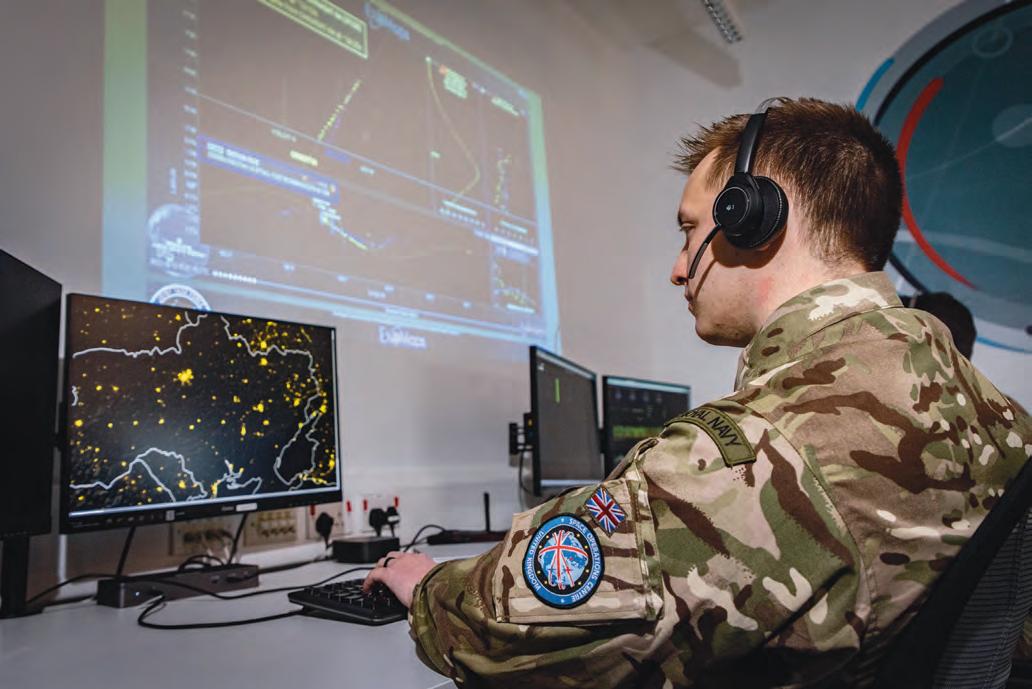
Creating the UK Defence space warfighter
PROTECTING BRITAIN’S INTERESTS IN THE FINAL FRONTIER
As the UK continues to grow its space capabilities, Air Commodore Jamie Thompson, Deputy Commander Space Command, highlights the qualities, aptitudes and expertise that the future space war ghter will need
The 21st century has brought a dramatic shift in the character of warfare. Land, sea, air and cyber have been joined by a new and critical frontier: space. Satellites are not just tools of scienti c exploration or commercial communication; they are essential components of national security, economic resilience and military capability. As threats in space become more complex, and hostile actors seek to exploit vulnerabilities in orbit, the UK has recognised the urgent need
to develop a cadre of space war ghters – military professionals trained, equipped and empowered to defend the UK’s interests in the space domain.
Why the UK needs space war ghters
Dependence on space-based infrastructure: Britain depends heavily on space. From GPS navigation, secure military communications and missile warning systems to weather forecasting, nancial transactions and air tra c control, space-based
infrastructure underpins virtually every aspect of life and defence. Every element of the Armed Forces relies on space-enabled systems for operational e ectiveness. If these systems were denied, degraded or destroyed, the impact on the UK’s military capabilities would be immediate and severe.
Emerging threats in orbit: the space domain is contested and congested. Adversaries such as Russia and China have demonstrated their intent and capability to interfere with space assets. These include cyber attacks on satellites, jamming or spoo ng satellite signals, and even direct-ascent anti-satellite (ASAT) missile tests. The threat is not hypothetical – it’s real and growing. In response, NATO has declared space an operational domain, and the UK, as a key NATO member, must be prepared to respond accordingly.
National sovereignty and strategic autonomy: the UK cannot a ord to be solely reliant on allied capabilities, especially as space becomes more central to defence planning. While cooperation with allies such as the United States will remain critical, Britain must be capable of independently protecting its own space assets and interests. Having a sovereign space capability enhances war ghting and strengthens the UK’s position as a leading spacefaring nation.
De ning the UK space war ghter
A ‘space war ghter’ is not simply an operator of space systems. These individuals are trained to think strategically and act decisively in the dynamic environment of space. They understand orbital mechanics, satellite operations, space situational awareness, electronic warfare and the legal and ethical frameworks governing space activities.
Space war ghters must also be able to coordinate with the other domains of air, land, maritime and cyber to provide integrated Defence solutions. They are the human element behind UK Space Command’s strategic vision, turning policy and technology into real-time actions to safeguard national interests.
The role of UK Space Command
Established in 2021, UK Space Command is the cornerstone of Britain’s Defence space strategy. It is a joint command of the UK’s Armed Forces and is responsible for delivering space operations, space workforce training and the development of space capabilities. Defence is building the institutional foundations necessary for space war ghting. These include:
The UK is investing in recruiting and training future space war ghters (PHOTO: MOD/ CROWN COPYRIGHT)
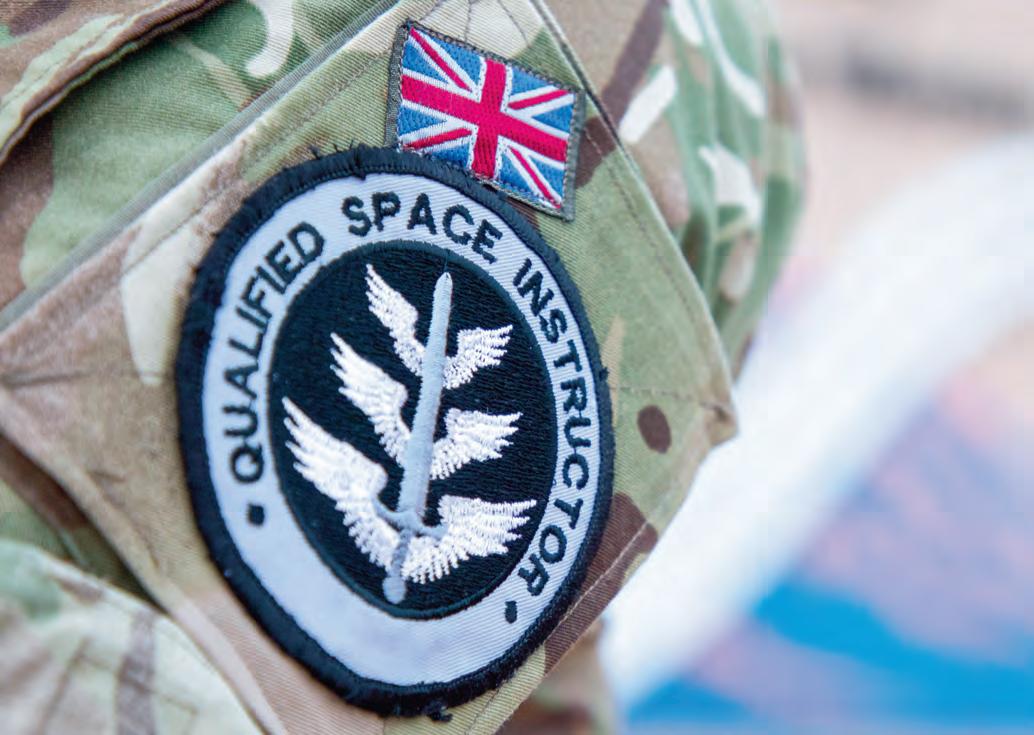
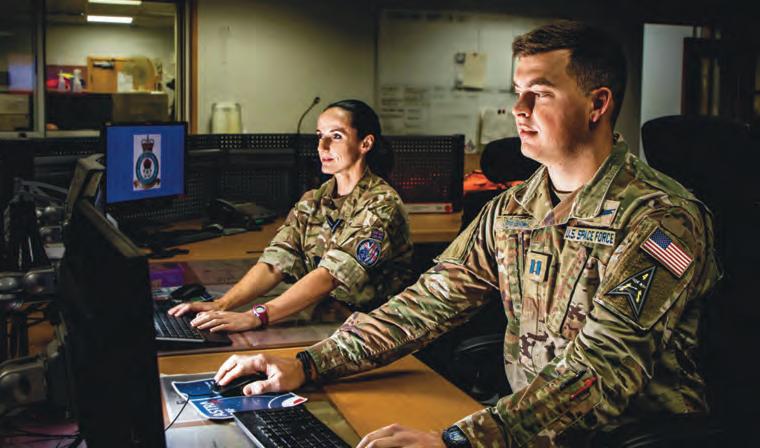
UK space war ghters work closely with allies and partners (PHOTO: MOD/CROWN COPYRIGHT)
Scheduled to launch in 2026, the Skynet 6A satellite will add another vital element to the UK’s space communications (IMAGE: AIRBUS)
Training and education: developing a professional military education track focused on space operations and warfare, with courses provided through institutions such as the Defence Academy and in collaboration with allies and partners.
Technology and capability development: procuring and elding resilient satellite constellations, ground systems and sensors. Programmes such as Skynet 6, for secure military communications, and Borealis, to enable space domain awareness data processing and command and control (C2) are vital steps.
Operational integration: embedding space experts in joint operational planning and ensuring that space considerations are integrated into all levels of defence activity.
Defending UK space interests
The UK’s approach to defending its space interests is multifaceted. Space war ghters play a pivotal role across several key mission areas: Space domain awareness (SDA): awareness is the foundation of defence. Space war ghters are trained to use radar, optical sensors and tracking systems to monitor objects in orbit, detect anomalies and track potential threats. Through the National Space Operations Centre (NSpOC), they work closely with allies and commercial partners to maintain a comprehensive and accurate picture of the space environment.
Resilience and redundancy: protection isn’t only about de ecting attacks – it also involves making UK systems harder to disrupt. This means building resilient satellite networks that can continue to function when degraded. Space war ghters help design and test such systems, ensuring redundancy, manoeuvrability and hardening against cyber threats.
Control of space: while the UK maintains a defensive posture, space war ghters must be prepared to deny adversaries the use of space in times of con ict. This could involve jamming hostile signals, conducting cyber operations or deploying

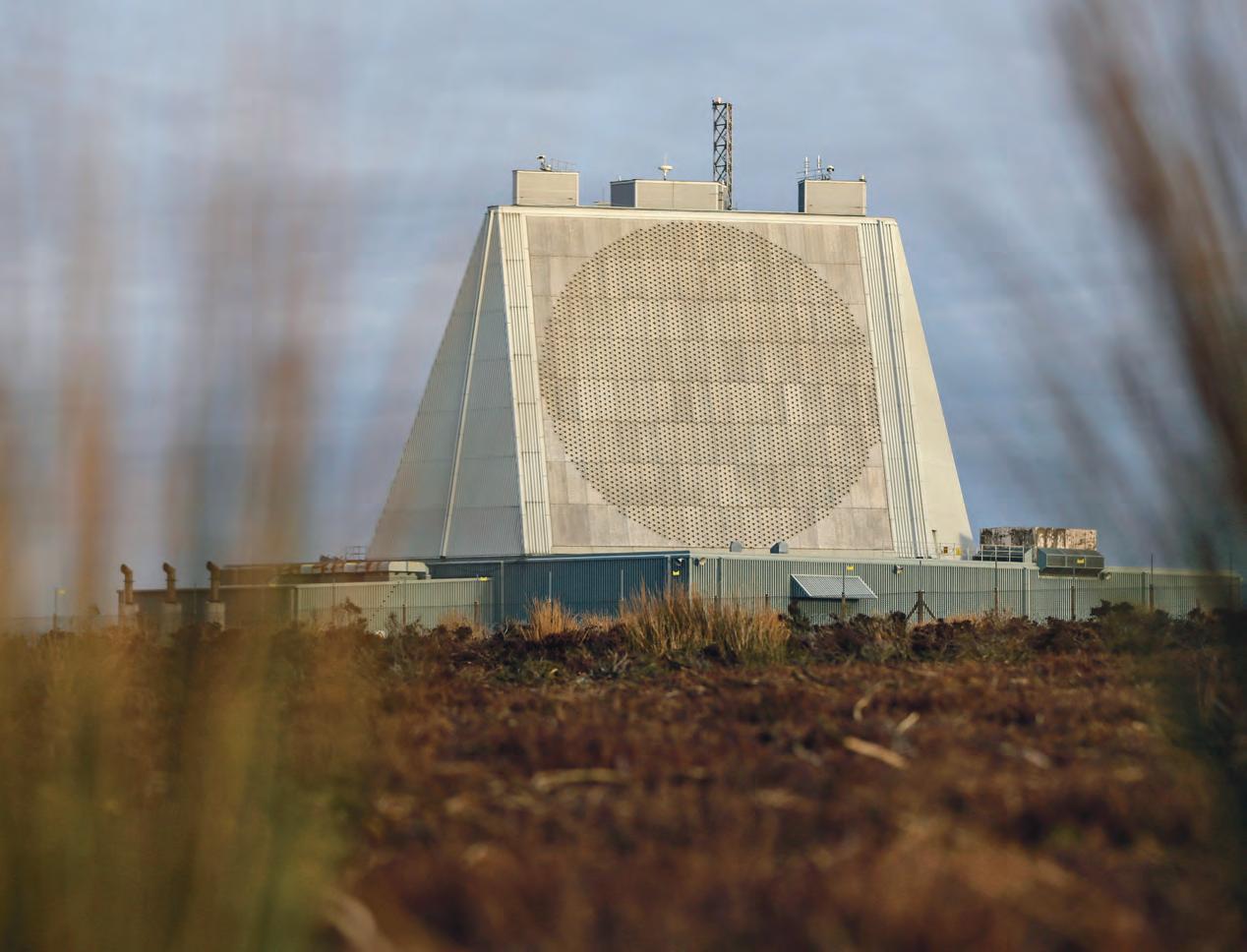
technologies that disable enemy satellites without causing debris. Such measures must comply with international law and be proportionate, but they are essential components of deterrence.
Interoperability with allies
Space war ghters must operate as part of broader alliances and partnerships. Interoperability ensures that UK forces can share data, operate common systems and contribute meaningfully to coalition space operations.
Training the next generation
Creating a space war ghting force isn’t just about technology; it’s about people. The UK is investing in recruiting, training and retaining highly skilled individuals who can operate in this complex
domain. Initiatives like the Space to Innovate Challenge and Space Academy aim to attract talent from across the population.
Britain’s strategic posture in space
Creating space war ghters is more than a military ambition – it is a strategic necessity. Space is a war ghting domain where power is projected and interests are contested. By training a new generation of space war ghters, the UK is taking a proactive stance in securing its national security, protecting vital infrastructure and maintaining its status as a credible military power on the global stage. In doing so, the UK ensures it is not only a participant in space, but a defender of peace, security and stability in the nal frontier.
and space surveillance capability (PHOTO: MOD/ CROWN COPYRIGHT)
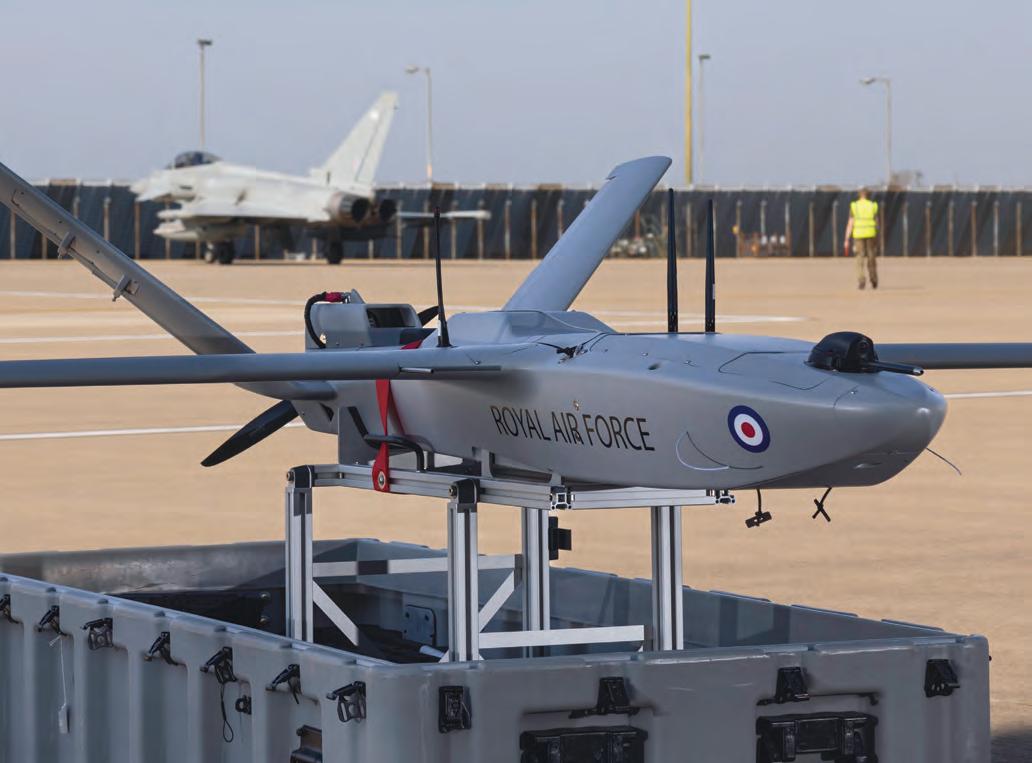
Future control of the air
Air Vice-Marshal Jim Beck , the RAF’s Director of Capability and Programmes, outlines the challenges that future war ghters will face in achieving control of the air and highlights the role that autonomous collaborative platforms and the NEXUS combat cloud might play
Drawing on lessons from the Russia-Ukraine War, achieving a level of control of the air must be considered as an essential precondition for success for all war ghting domains. Speci cally, control of the air underpins all air operations because it secures freedom of action, while limiting or denying its use by an adversary.
During operations that have been undertaken since the end of the Cold War, it has been delivered to a level where the opposing air force has been incapable of e ective interference (termed Air Supremacy) or, in the case of the early stages of Kosovo, to a level without prohibitive interference
by the opposing force (termed Air Superiority). As a consequence, the expectation of theatre-wide air superiority has become the norm; however, as Russia and Ukraine have learnt to their signi cant cost, this is, and always has been, an unrealistic assumption for peer-on-peer con ict. It is not hyperbole to suggest the future ght to gain control of the air will be extremely challenging and will be limited, in space and time, dependent on the phase of the con ict.
Such concepts are not new. The age of Air Power came to the fore during the Second World War, in which large packages of ghters and bombers would penetrate adversary airspace in large raids, aiming
to in ict maximum damage in a concentrated area. Air defences with radar detection, ghter aircraft and anti-aircraft guns were used to oppose such raids and, provided they were not destroyed or expended, would be the mechanism that prevented the opponent attaining long-term control of the air.
Increasing range
Contemporary air-defence systems are used in the same way, albeit, they are now better integrated, use a spectrum of Joint and multi-domain technologies not conceived in the 1940s, and, most signi cantly, impose themselves across ranges that can be measured in thousands of miles, if not intercontinentally. Looking to the future, each of these improvements is likely to develop at an accelerating pace, will likely proliferate across the globe, and will make attaining control of the air ever more complex.
The near-term challenge to achieving air superiority of any sort will be overcoming the increasing range of detection and engagement.
INTRODUCING STORMSHROUD
Welcoming the announcement of StormShroud, Air Chief Marshal Sir Richard Knighton, Chief of the Air Sta , said: “This is a seminal moment for the RAF to maintain our advantage in Air Combat and national security.
“The RAF is committed to exploring cutting-edge technologies that can
Concepts such as sensor fusion, which integrate di erent sensors across the full frequency spectrum, de ne much of what constitutes ‘ fth-generation’ and are making it harder for lower-generation systems to remain undetected before they arrive at the ght.
When coupled with the rapidly increasing range of e ectors, enablers such as air refuelling and Intelligence, Surveillance, and Reconnaissance (ISR) will be pushed further away, such that it will stress the range of datalinks and limit the time on task of combat aircraft. For this reason, the critical attributes for future combat air platforms will be stealth, a wide range of sensors, far greater range and the ability, including a human in/on the loop where needed, to ensure the kill chain can be completed e ectively.
Window of dominance
The e ort required to orchestrate e ective o ensive operations at scale will require broad multi-domain e ects and necessitate the need for deep weapon magazines. Therefore, cost and realism will drive even
enhance its lethality and survivability in a more contested and dangerous world.
“Autonomous Collaborative Platforms (ACPs) will revolutionise how we conduct a range of missions, from intelligence gathering to strike and logistical support. We are excited to be at the forefront of this
innovation and are working closely with industry partners to explore the possibilities.”
StormShroud will be operated by 216 Squadron, made up of Regular RAF, Royal Auxiliary Air Force and other UK Defence personnel. Squadron personnel will be trained to operate in small teams and in high-threat environments.
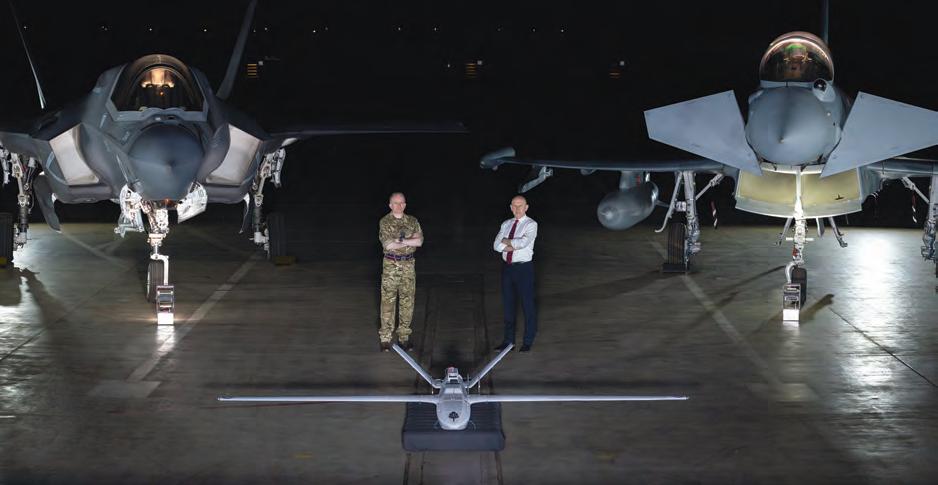
StormShroud will support RAF F-35B and Typhoon pilots by blinding enemy radars (PHOTO: MOD/ CROWN COPYRIGHT)
“Economic realities and obtainable technologies will continue the increase of Autonomous
Collaborative Platforms to generate the mass needed to attain control of the air”
the most well-resourced air force to shift towards achieving air superiority on a more focused basis.
The terms ‘pulsed operation’ or ‘window of dominance’ will likely become conventional parlance and will be very similar to the concepts of ‘raids’ during the Second World War. The sheer e ort to undertake a ‘pulse’ will drive a need to decisively shape the engagement space on each occasion, which in turn drives an enduring need for precision weapons to maximise Air’s contribution to the concept of degrading an adversary’s capability by ‘shooting the archer, not the arrow’. For this reason, it is necessary for next-generation platforms to be able to simultaneously undertake di erent disciplines as they transition through the layers of an integrated air and missile defence system.
Growing deployment
Economic realities and obtainable technologies will continue the increase of Autonomous Collaborative Platforms (ACPs) to generate the mass needed to attain control of the air. They will be employed in roles where the operational risk makes it undesirable to send a human. To access adversary airspace
with an appropriate level of survivability to be able prosecute the mission, higher-value ACPs will require similar attributes to that of crewed platforms. Lower-value ACPs are already proving their value at creating a scale that can saturate defensive systems, and have proven to be a force multiplier when employed alongside higher-value systems. For the future, it is likely that success in mastering the true value of low-cost ACPs will be about priming and then developing the Defence industrial base, so it can be rapidly scaled when called to do so.
Bringing elements together
The nal, and perhaps most important, element in control of the air is how individual elements are brought together to ‘Sense, Make Sense and Decide’; which are the fundamentals underpinning Command and Control. During the Second World War, it was Dowding’s system that gave us the winning advantage during the Battle of Britain, and there is a thread leading to systems such as NEXUS that will deliver air battle management to provide cloudbased interconnectivity between domains and the ability to fuse together unlimited amounts of data.
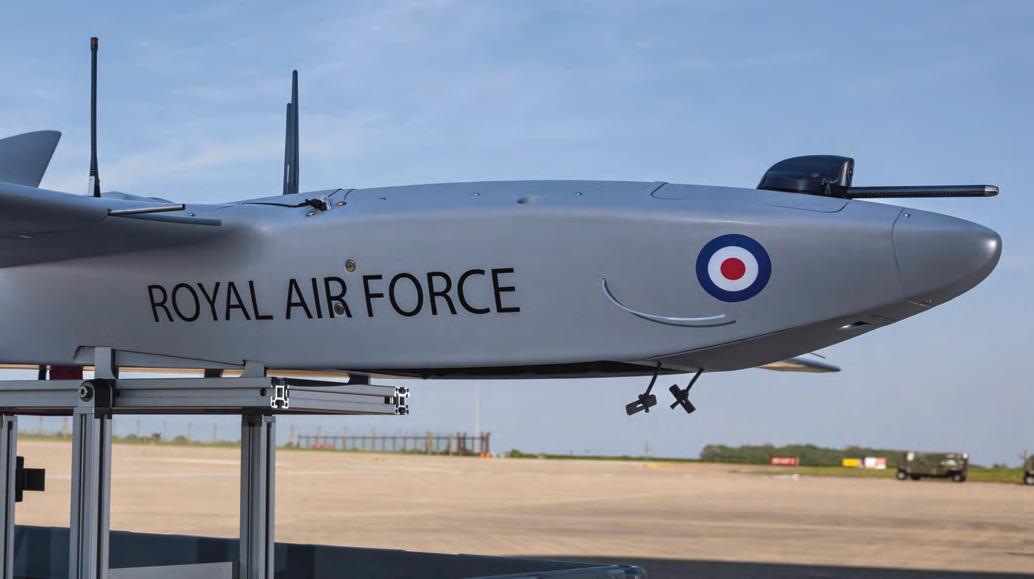
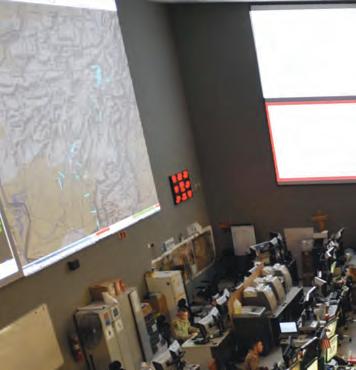
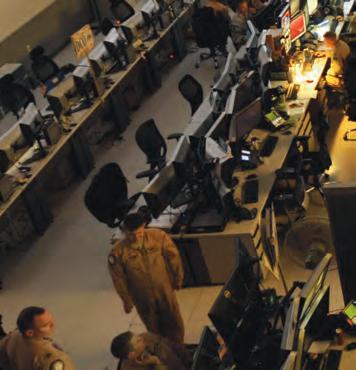
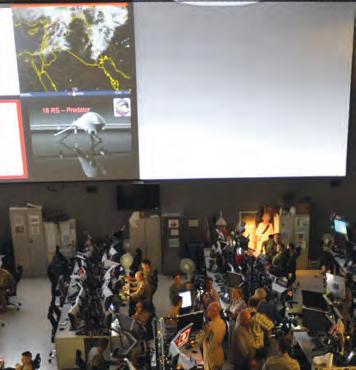
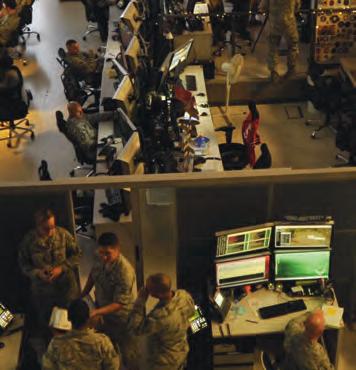
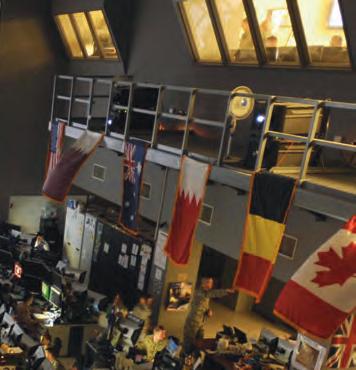
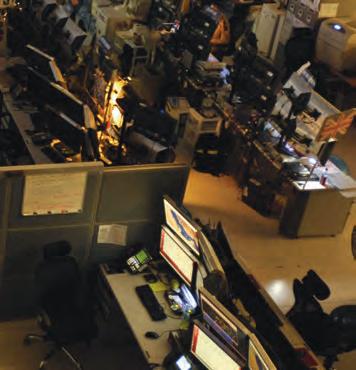
Ethics in global competition over military AI
Advances in arti cial intelligence (AI) and related technologies – such as autonomy, robotics, cloud, edge computing and novel sensors – hold the potential to revolutionise air power. They also introduce complex ethical debates. James Black from RAND explains
As outlined in the UK’s Defence AI Strategy, AI is no single technology, but rather a family of rapidly evolving general-purpose technologies focused on developing machines capable of performing tasks normally requiring biological intelligence, especially machines that learn from data. In this sense, AI can be understood as analogous to the combustion engine, semiconductor or internet before it – a highly-disruptive technology that will eventually touch on all areas of human activity, including warfare. This time, the revolution is a cognitive one, with the potential for improved speed and quality of decision-making, optimisation of
complex systems, and the automation of dull, dirty or dangerous tasks, including within the military.
But if AI is likely to become not just a growing factor, but an actor in war ghting, it is imperative we understand the ethical dilemmas this could pose for defence decision-makers.
The state-of-the-art in AI is advancing rapidly; air forces must not be left behind New technologies with military applications have long sparked debates over their ethical, legal and governance implications; observers have also often raised alarm around their impacts on strategic stability and the frequency or intensity of con ict.


Decision-makers will need to factor in the ethical use of AI in future operations (PHOTO: MOD/ CROWN COPYRIGHT)
In the air domain, the early 20th century saw erce debates about the ethics – and military utility – of the newly invented strategic bomber, catalysed famously by the destruction of Guernica. Today, competing nations are no longer simply weighing their relative military power in terms of numbers of tanks, ships or aircraft deployed; rather, they are seeking advantage both in and through AI.
Over the battle elds of Ukraine, AI tools are already helping to identify concealed targets, plan complex operations and execute precision strikes with uncrewed air systems, despite a highly contested physical and electromagnetic environment. With an eye to the future, militaries around the world are investing heavily in AI for a growing range of missions, seeking to achieve operational advantage through autonomy, automation and increased combat mass.
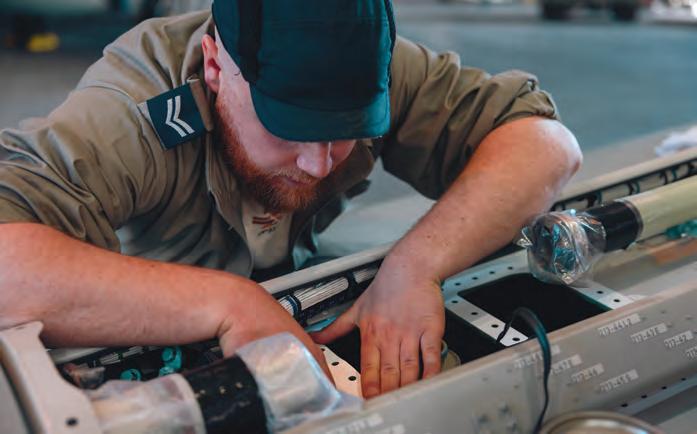
More e cient maintenance will be delivered through the use of AI tools (PHOTO: MOD/ CROWN COPYRIGHT)
For the RAF and Allied air forces, this means accelerating the adoption of AI both in front-line operations and in ‘back o ce’ functions. The potential bene ts are myriad: enhancing the productivity of the workforce through rollout of AI tools to support everything from improved battlespace management or operational planning through to more e cient logistics or aircraft maintenance; embedding human-machine teaming as a core tenet of the future force; and experimenting with novel ways of delivering air power through collaboration between crewed platforms and uncrewed systems of varying levels of sophistication, cost and autonomy.
Developing a responsible approach is not just ethical, but militarily expedient
In this competition for advantage, the RAF and air forces from like-minded nations have made clear the imperative to develop and deploy AI in a responsible
manner – not simply as a matter of ethics, but also one of military expediency. Applying AI across the full life cycle of force and capability development, or on live operations, requires that ethics, legality and safety be built into our approach from the outset. This is vital to building trust, ful lling our obligations under international law and maintaining support for investments in this disruptive new technology.
Emotive debates over Lethal Autonomous Weapons Systems (LAWS) – so-called ‘killer robots’ –consume much of the oxygen in discussions around the ethics of military AI. Certainly, there are important questions to be asked and answered around what constitutes meaningful human control over decisions involving the use of force. Equally, narrowly focused discussions over LAWS risk missing the whole picture, which is much richer and more complex.
Ethical principles can help air forces guide the responsible rollout of military AI
To capture this nuance, the UK Ministry of Defence has published a set of ethical principles for developing and deploying AI. The rst is human-centricity: the need to consider the bene ts and risks to humans across all stages of an AI system’s life cycle. This includes our own personnel, adversaries and civilians, as well as broader environmental impacts.
The second principle – responsibility – emphasises the need to understand how, to what extent and by whom human control is exercised on any AI-enabled system. Too often, this becomes reduced to simplistic debates over whether the human should be ‘in’, ‘on’ or ‘out of the loop’ for decision-making. The reality, as seen in Ukraine today, is that decisions are often made and enacted by complex, messy assemblages of multiple AI tools and humans involved at di erent stages of the Observe-Orient-Decide-Act (OODA) loop. There are also situations in which greater levels of autonomy appear a military necessity: for example, to deal with incoming threats at speeds that overwhelm the human mind, or because reach-back to higher echelons is not possible in a degraded electromagnetic environment or without compromising stealth.
As such, it is important to look beyond the immediate question of where the human sits in, on or o the loop on any given tactical decision at the edge. Instead, we must consider how humans have designed and assured the overall approach to decision-making, including any role therein for AI. Then, we can ask who bears ultimate responsibility for that system, including when things go wrong – even if they may not be pressing the proverbial trigger.
This provides the link to the third principle, namely understanding. This stresses the importance of the context for decisions or actions, and the characteristics of the military AI systems placed into
those operational settings. Here, the debate often shifts to the limitations of our ability to understand the ‘black box’ of algorithms and to calls for more ‘explainable AI’. While explainability is welcome, we must avoid holding out for perfection.
The reality is that the RAF and air forces around the world already assure the ethical preparedness of hundreds of thousands of autonomous decision agents every year – they are the minds of the pilots, air battle managers, engineers, maintainers and other personnel who go to war, each guided by training, doctrine and leadership, but still ultimately a ‘black box’ unto themselves. So, we must similarly seek a robust but proportionate approach to approvals for new AI-enabled systems, recognising that perfection will never be possible but that machines can also bring advantages over human counterparts, who su er from their own cognitive biases, emotions or fatigue.
This brings in the fourth principle: bias and harm mitigation. Just as we must assess how AI-enabled systems will likely perform on operations, even though we cannot account for all possible scenarios, so too must we seek to identify and mitigate potential unintended consequences from their use. This includes implementing mechanisms to Red Team the models and underlying datasets used to train AI systems; setting performance thresholds, safeguards and fallback modes; and considering what military harms could occur if an AI system were deployed in an unfamiliar context outside of its original programming.
This leads to the nal principle: reliability. This goes beyond designing and testing AI systems that act as expected, based on de ned performance parameters. It also means counteracting e orts by hostile actors to undermine our AI systems – for example, via cyber-attacks that seek to extract or sabotage model weights or poison data feeds.
Through addressing these interlinked AI safety and security concerns, air forces can develop and deploy AI systems that they can trust – imperative in a hostile threat environment. Only with trust can they exploit the full bene ts of AI across the military capability life cycle and the spectrum of air operations – from the front line to the factory.
Our ethical responsibilities extend to driving the global agenda around military AI
In an age of global competition, the RAF and Allied air forces have an obligation to ensure that emerging norms of responsible behaviour around military AI are shaped not by the conduct of reckless and authoritarian powers, such as Russia, China, Iran or North Korea. Rather, it is by demonstrating a
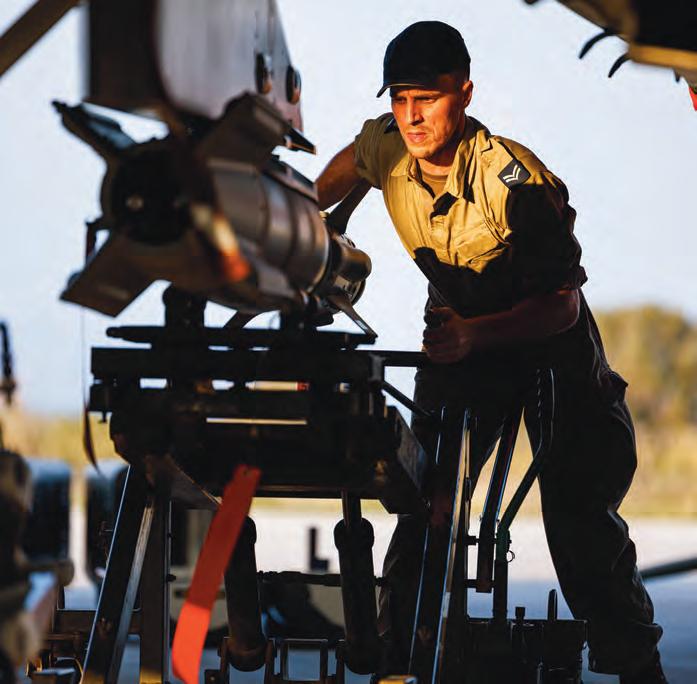
responsible approach to the rollout of military AI, including in the air domain, that democratic nations can shape future global governance of these new technologies in line with our shared values and commitments under International Humanitarian Law.
We must reject the supposed choice between ethics or advantage as a false dichotomy. A responsible approach to military AI in the air domain helps bolster trust, interoperability, safety and security. At the same time, an ethical approach also means recognising the responsibility to act swiftly and seize the full potential bene ts of AI technology. Doing so enhances our collective air power and, ultimately, our defence and deterrence. This contributes to a more secure, prosperous and free world.
Accelerating adoption of AI in defence, hand in hand with appropriate ethical guiderails, ensures that hostile actors cannot try to seize the advantage for themselves through unsafe and less ethically constrained approaches to their own military AI. Leading on AI innovation, in turn, reduces the risk of our being forced into a global ‘race to the bottom’ on standards of behaviour around military AI.
Such a race would not only risk harming military personnel, civilians and the wider society, but could also undermine strategic stability – increasing the risk of miscalculation by AI-enabled systems and unintended escalation during crises or times of war.
Exactly what constitutes meaningful human control over the use of force needs to be clari ed
(PHOTO: MOD/ CROWN COPYRIGHT)
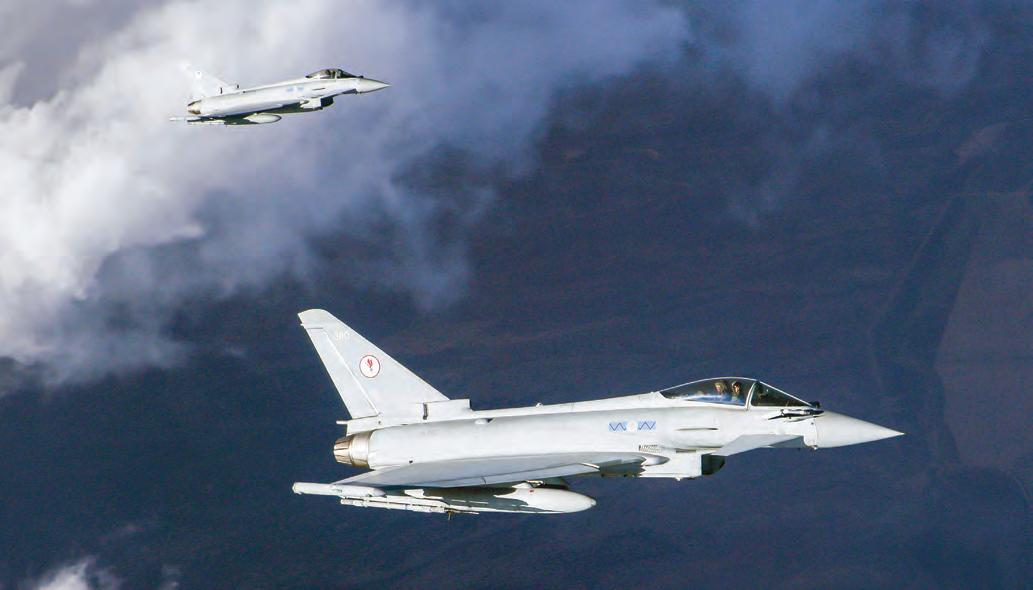
Exploiting data to achieve control of the air
The explosion in data acquisition and storage requires a step change in technological infrastructure and skill sets to ensure this huge resource can be used to gain operational and strategic advantage. The RAF’s Director Digital, Dr Arif Mustafa, explains
“Throughout my whole career, we have largely enjoyed air supremacy, never mind air superiority, at least above about 10,000 feet. That is not going to be the case in the future. It seems clear to me that we are going to need to ght for control of the air.”
Air Chief Marshal Sir Richard Knighton KCB ADC FREng, Chief of the Air Sta , speaking at the Royal United Services Institute’s annual Lord Trenchard Memorial Lecture 2024
In future peer-onpeer con icts, the RAF will have to ght for control of the air (PHOTO: MOD/ CROWN COPYRIGHT)
The way we think about Control of the Air (CotA) is changing. Instead of pervasive dominance, future CotA may be eeting, requiring us to generate windows of opportunity within which pan-domain e ects can be created. Our military capabilities will be just as
important as they ever were, but there is also a new fundamental ingredient for us to be able to take advantage of operational opportunities – data.
Why is data so important?
This paints a future where CotA is no longer a given but a hard-won, temporary advantage. To identify, seize advantage and deliver operational e ect in these eeting windows of opportunity cannot solely rely on having the right aircraft, weapons and sta ; it also requires a new level of interconnectivity, data exploitation and interpretation using arti cial intelligence (AI). Firstly, achieving conditions of opportunity hinges on nding them through real-time data awareness. This requires a seamless, interconnected sensor network, leveraging traditional capabilities
as well as persistent Intelligence, Surveillance and Reconnaissance (ISR), with space-based assets playing a crucial role. Then, machine-speed Processing, Exploitation, and Dissemination (PED) is essential to rapidly transform raw sensor data into actionable intelligence, enabling decision-makers to cue force elements before the window closes.
“In essence, data is the foundation upon which control of the air is built”
The next stage requires rapid mission planning based on precise, up-to-the-minute data. This includes everything from terrain mapping and weather forecasts to enemy disposition and electronic warfare environments. Ultimately, the goal is to get aircraft into the sky, with the correct e ectors and directed to the correct locations, before adversaries can react. The ability to rapidly re-plan, reroute or even abort a mission based on incoming data is also critical for survival and success.
Airborne monitoring and sensing then provide continuous situational awareness, enabling commanders to adapt to rapidly changing circumstances. This requires robust communications and data pipelines that can deliver real-time updates and analysis to pilots and command centres. These will need to be protected by cryptography in a quantum era and enabled by data-centric security across classi cations, partners and systems. Continuing to control emissions will require novel approaches to communication and consideration for operating on- and o -grid.
Finally, a ‘plug-and-play’ ecosystem is essential, allowing for the rapid integration of new sensors, weapons and platforms. This requires standardised data formats and open architectures, ensuring seamless interoperability across all domains, allowing up-to-date and e ective systems to be used in the most e cient manner.
In essence, data is the foundation upon which control of the air is built.
Pulling it all together
To achieve all of this requires innovation on several levels. Operational networks and communications need to maximise data sharing without compromising on mission resilience, survivability or observability. Computers, on-board and o -board, need to be able to share workloads and optimise
where tasks are done, striking the balance between sharing large volumes of data over bandwidthconstrained channels and doing more processing on-board our capabilities or at the edge.
Finally, we must leverage the power of data through human-machine teams and tools which rapidly speed up decision and planning cycles. Operational users need to become increasingly con dent and adept at working with data on an unprecedented scale and embrace a cultural shift towards information-age solutions across the battlespace.
What are we doing?
The RAF is already making progress on this journey, with several capabilities in operational use. Our NEXUS programme is providing the core upon which data is transferred around the battlespace; RAVEN is providing dynamic operational networking; APPIVATE is delivering software and data tools into the hands of users through upskilling; our Cyberspace profession is continually growing and is at the forefront of delivering digital and technological change; we are continuously engaging and supporting with international partners through training, joint endeavours and collaborative design.
We are also embarking upon a major modernisation of our underlying digital capabilities, holistically delivering the networks, computers and data capabilities that underpin our operational success. Our use of data in modern warfare is not optional, and the RAF stands at the forefront this change.
In December 2024, a U.S. Air Force F-35 ying over Texas successfully shared classi ed data via satellite with the RAF Nexus system in Farnborough (PHOTO: USAF)
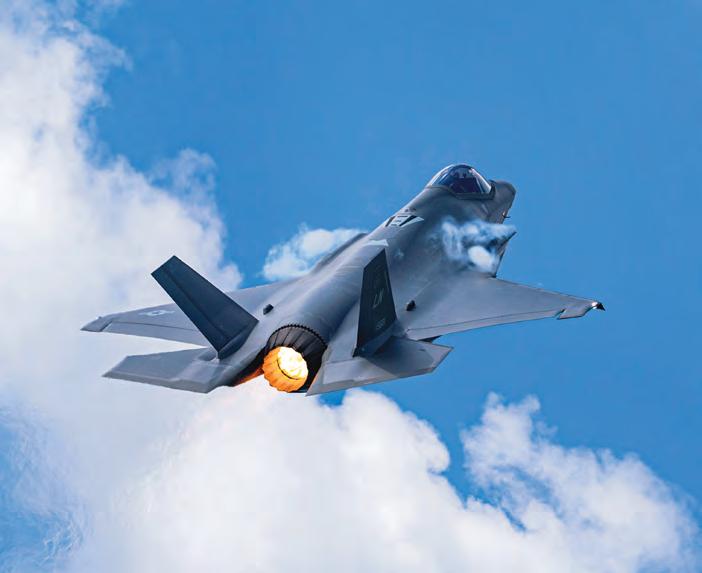
The Strategic Defence Review –recognising industry’s key role
Kevin Craven, Chief Executive O cer of ADS, welcomes the Strategic Defence Review and reveals how industry helped in its formulation and will go on to support its implementation

After what has felt like a very long wait for clarity, the publication of the Strategic Defence Review (SDR) on 2 June 2025 represents a much-needed vote of con dence for our sectors. For the 180,000+ people working across our defence industry, it signals something vital:
a plan with intent, dedication and, importantly, one that recognises the role that industry must play in delivering our national security –today, tomorrow and for the future.
The overarching success within the Review is the role that the sector has played throughout this whole endeavour – from the workshops, roundtables, committee hearings, panels, parliamentary drop-ins and all the engagements in-between, we nally have a strategy that puts the concerns and interests of our sector at the centre of decisions.
Fundamentally, the SDR, for once, touches on the entire culture in defence. Its emphasis on rede ning the current industrial partnership –one that brings the armed forces into closer collaboration with both the civil sector and businesses of all sizes – is certainly long overdue.
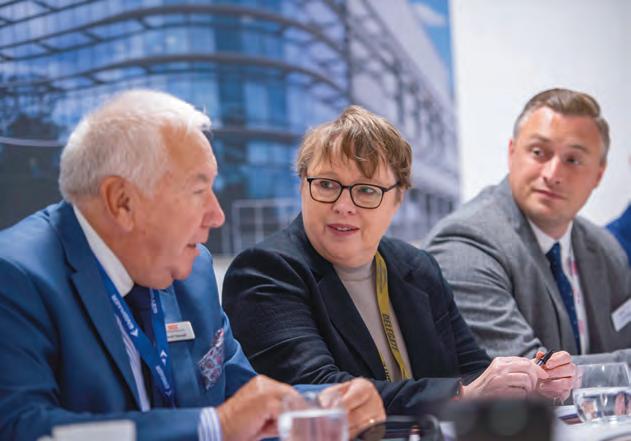
Clearly, as with all of these things, execution of the plan is what really counts, but the important thing is that the Ministry of Defence has acknowledged the need to transform both its procurement and relationship with industry – music to the ears of many, I’m sure.
Bear in mind that this is a sector that already supports 181,500 high-skilled, high-productivity jobs across the UK, generating £36bn in turnover in 2024, and delivering nearly £14bn in exports. Under this new plan, industry has the potential to deliver even more to both the UK economy and our society.
What does the SDR deliver for our aerospace and space sectors?
For those of us operating in the air and space domains, the SDR delivers several encouraging signals. Notably, the elevation of space as a priority portfolio under the National Armaments Director (NAD) is a signi cant development – it demonstrates the growing recognition from government that space is a critical operational domain for our national security. Alongside this, the commitment to deepening NATOled industrial cooperation and the formation of a Defence Exports O ce signals a promising picture of a more coordinated, industry-led approach.
On the aerospace front, the Review makes a welcome assessment of growing the strategic importance of air power. The government’s pledges to acquire additional F-35s, enhance Typhoon capabilities,

Last year’s Farnborough International Air Show provided an early opportunity for members of the defence industry to meet the Secretary of State for Defence, the Rt Hon John Healey MP (right), as he took up his
progress the Global Combat Air Programme (GCAP) and invest in autonomous systems represents a bold vision for a “next-generation Royal Air Force” – something we at ADS have continued to call for.
But these ambitions cannot remain aspirational. Government must ensure that industry plays an integral, immediate role in shaping and delivering national capabilities. In today’s volatile security environment, time is a luxury we do not have. Delivering these programmes successfully will require continuous, open collaboration between government and industry, underpinned by sustained and consistent investment.
“Government must ensure that industry plays an integral, immediate role in shaping and delivering national capabilities”
What’s next for industry?
We now look ahead to the upcoming Defence Industrial Strategy and the National Security Strategy, where we hope clarity over funding this potentially transformative SDR is made clear. I was encouraged by the Prime Ministers words: “If the goal is to deter con ict, then the best way to do that is to prepare for it.” That preparation must begin now. Not later. To ensure
a safer tomorrow, we must deal with the scal challenges of today.
There’s no doubt that the SDR presents a compelling vision of the future of our national security. But if it is to serve as a credible deterrent in an increasingly fragile world, it must be matched by timely delivery, clear investment and genuine partnership with the industrial base that underpins our nation’s defence.

Typhoon –


defending the UK for this generation and the next.







Sharpening the UK’s Combat Air edge.


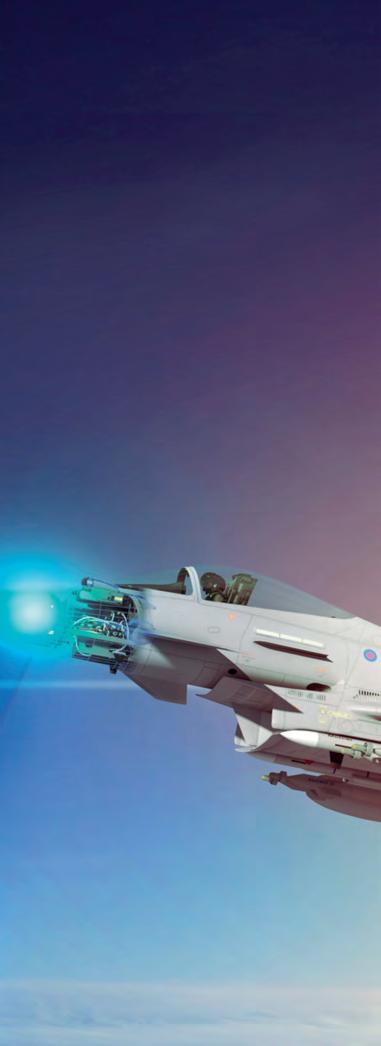
The RAF Typhoon’s new ECRS Mk2 radar will deliver a step change in capability when it comes into service later this decade. Side-by-side with the UK’s world-first BriteCloud expendable active decoy, Typhoon will be protected from the most advanced radar-guided threats.
As well as boosting UK capabilities now, investment in Typhoon is supporting the development of future technology through Leonardo UK’s role in Team Tempest. As part of the Global Combat Air Programme, the next generation of British scientists and engineers will maintain the nation’s combat edge for decades to come.









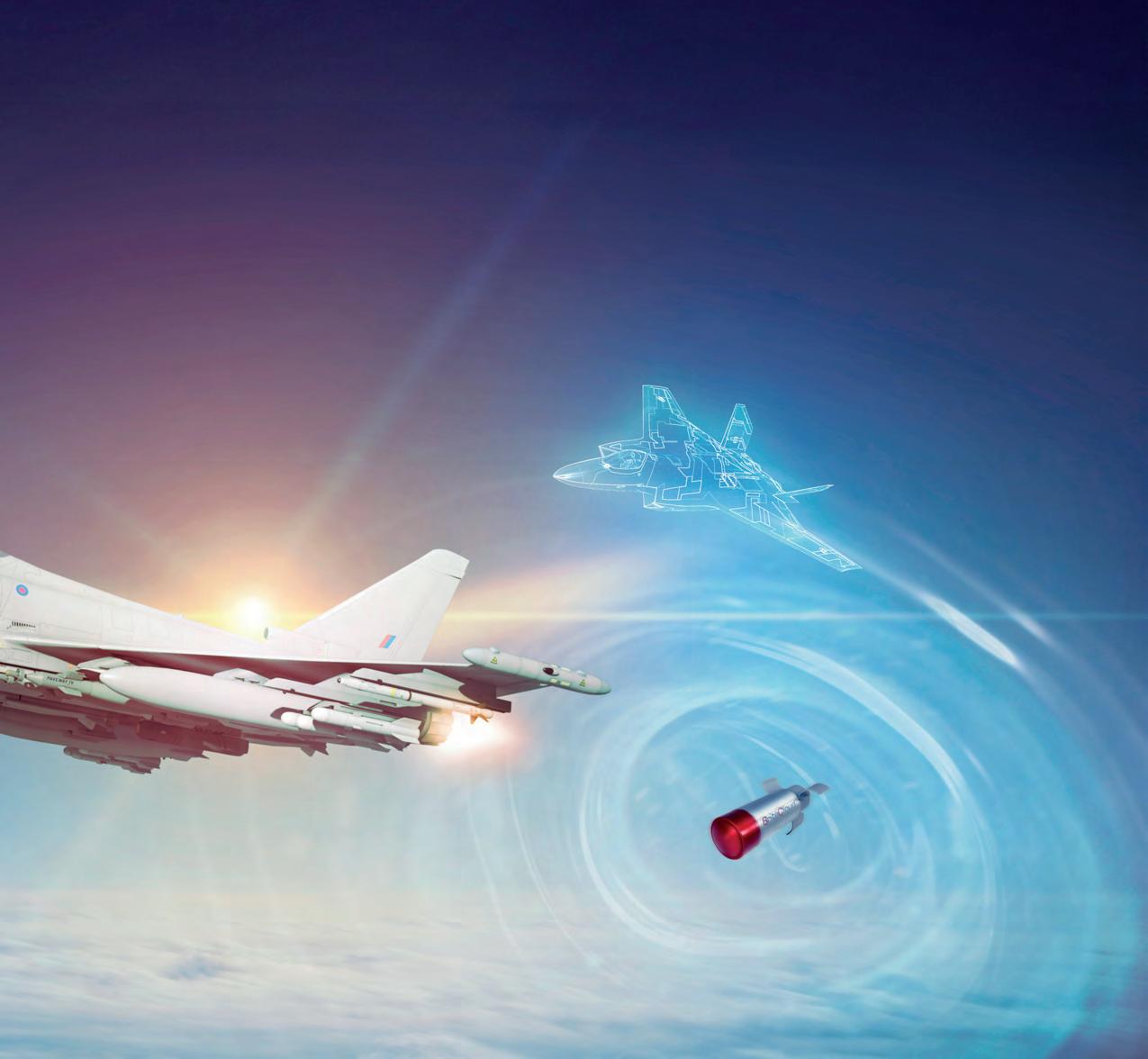



















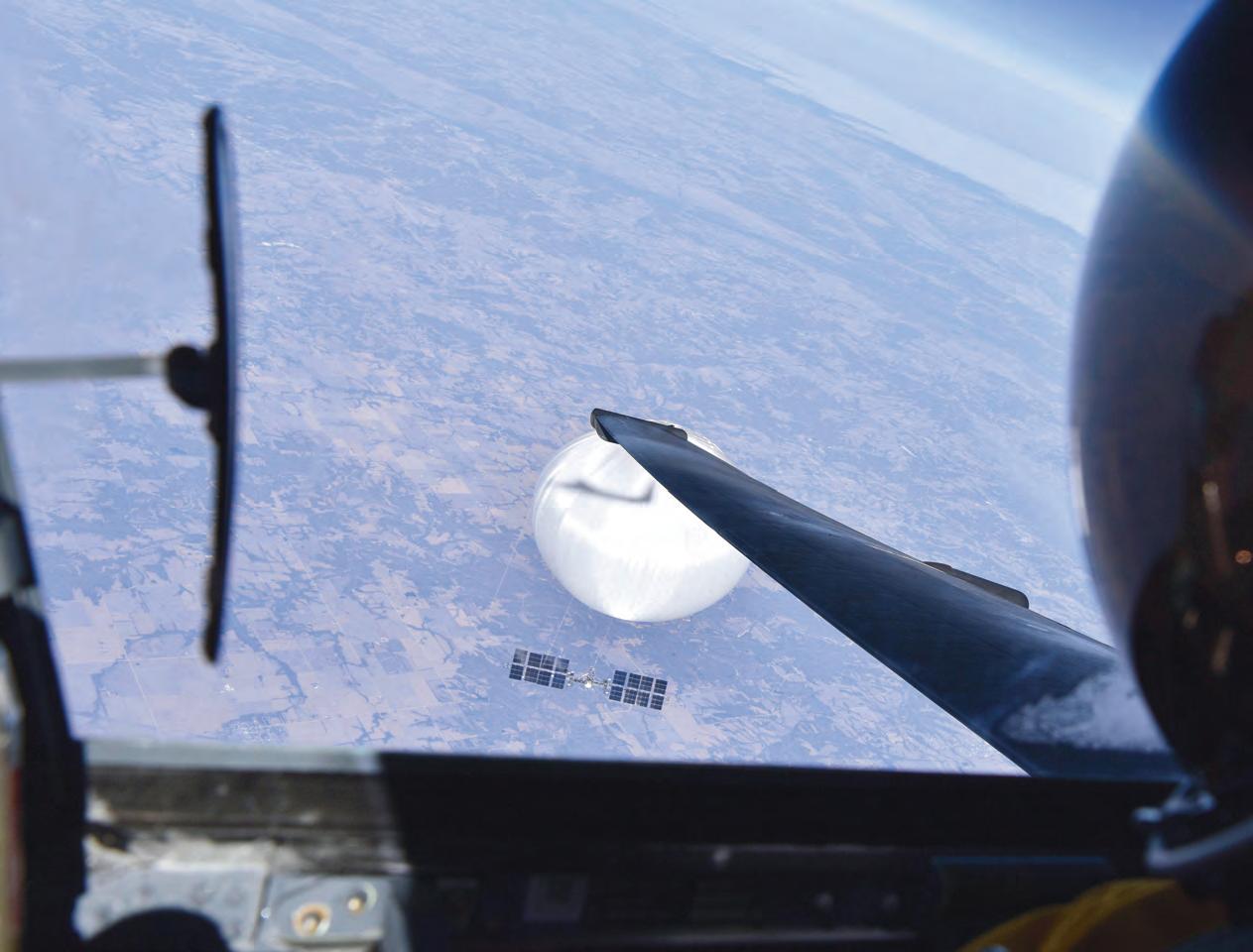
Higher airspace operations
Brigadier General Alexis Rougier, general o cer in charge of very high altitude at the French Air and Space Force headquarters, considers a new strategic challenge for Defence –aerial vehicles that are capable of operating in the upper reaches of the atmosphere
Today, most aircraft mainly operate between ground level and around 20km of altitude. Commercial airliners, for example, typically cruise between 10km and 12km at subsonic speeds. Yet technological progress is now paving the way for aerial vehicles capable of ying much higher, in layers of the atmosphere that remain largely unexplored: the realm of Higher Airspace Operations (HAO), spanning approximately from 20 to 100 km.
In this zone, two major categories of novel vectors are emerging. On one side are HAPS (High Altitude Platform Systems), which include stratospheric balloons and ultra-light solarpowered aircraft. These platforms, capable of ying continuously for several months, are particularly suited for observation, intelligence or communication missions. The 2023 incident involving ‘Chinese balloons’, one of which was shot down by an F-22
o the US coast, demonstrated their strategic potential. On the other side are so-called hypersonic vectors, which are able to y at extreme speeds through the upper atmosphere. These weapons – notably developed by Russia, the United States, and China – present unprecedented challenges for traditional defence systems.
From a military standpoint, HAO o ers multiple advantages:
– Extended range: HAPS can cover the globe, while hypersonic weapons can strike longrange targets within thousands of kilometres;
– Exceptional persistence: some HAPS are designed to remain airborne for up to a year – far beyond the endurance of traditional drones or aircraft;
– Improved survivability: aerial vehicles operating in HAO are largely immune to ground-based threats, either by ying above the fray or relying on their speed and manoeuvrability to evade even the most advanced air-defence systems.
Three recent events have accelerated global awareness of HAO-related stakes. Since 2022, Russia has deployed hypersonic weapons in the Ukrainian con ict (Kinzhal and Zircon missiles, for example). In 2023, the Chinese balloon incident highlighted the strategic utility of stratospheric platforms.
Finally, in 2024, Israeli strikes on Iranian infrastructure con rmed that military powers are actively investing in this emerging domain of confrontation. HAO is thus becoming a new extension of the ‘Air battle eld’ up to outer space, a dimension where unprecedented power dynamics are taking shape.
The issue of sovereignty
HAO also raises a fundamental issue of sovereignty. Under current international law, there is no clearly de ned boundary between sovereign airspace and outer space, which is free to access. The 1944 Chicago Convention a rms that each state is sovereign above
Although not speci cally litigated in the Chicago Convention, the Karman line generally separates airspace and outer space
The Prismatic Ltd Phasa-35® HAPS has achieved altitudes of 66,000 feet (IMAGE: BAE SYSTEMS)
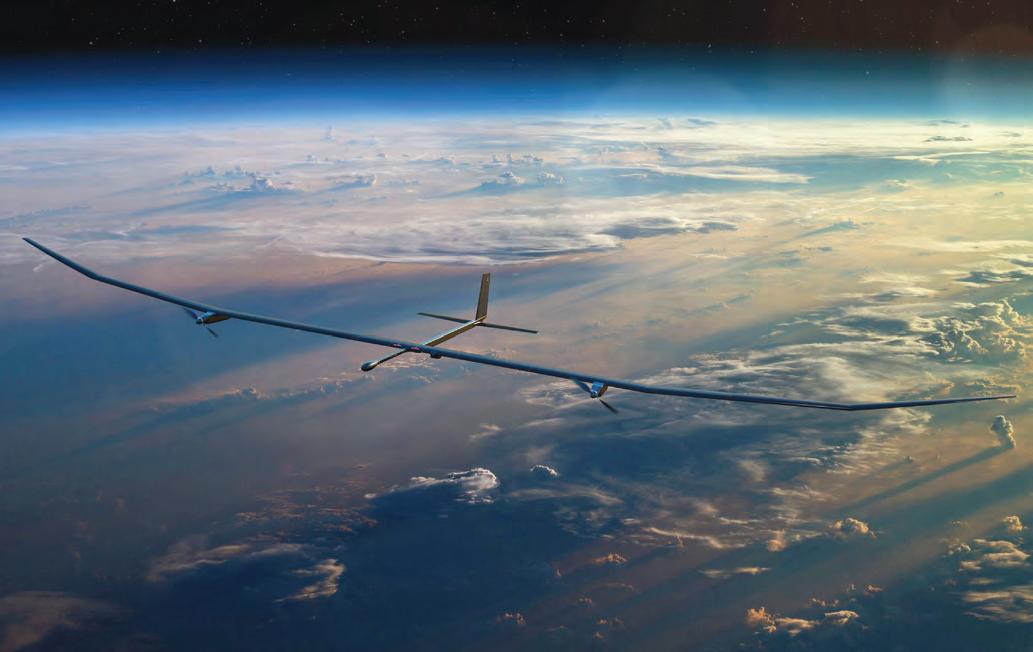
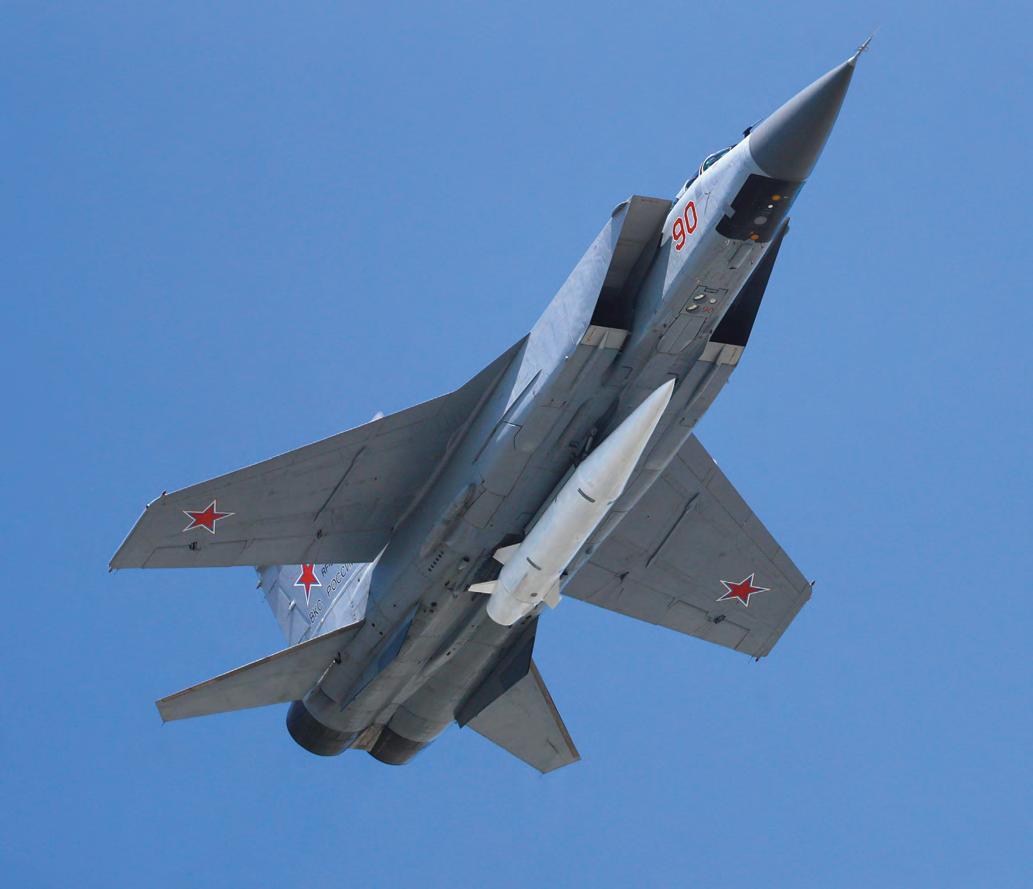
its territory, but does not specify to what altitude this sovereignty extends. Conversely, the 1967 Outer Space Treaty states that space is freely available for peaceful use, yet does not de ne where space begins. This legal uncertainty arises from the fact that the atmosphere gradually thins with altitude, making it di cult to draw a clear line between ‘air’ and ‘space’.
In practice, the distinction is based on the nature of the objects. An aircraft ies using aerodynamic lift (Newton’s laws), while a satellite remains in orbit governed by gravitational forces (Kepler’s laws). HAO lies between these two physical regimes, becoming a true legal grey zone. States see their sovereignty challenged not only by legal ambiguities, but also by the technical di culty of asserting control over these upper layers of the atmosphere, which remain hard to access.
Aware of these emerging challenges, French military o cials have launched a strategic review focused on HAO. In 2025, the Ministry of the
Armed Forces is developing a dedicated strategy, embedded within its long-term capability planning. This strategy is built on three pillars:
– the ability to detect objects operating in HAO; – the capacity to intercept them, if needed; and, nally,
– the ambition to develop new vectors that can harness the operational advantages of HAO – whether for surveillance, communication, or combat.
HAO, therefore, represents a new strategic challenge, with a wide range of stakes: technological, operational, legal and geopolitical. Like space, cyberspace and the seabed before it, this hybrid zone forces us to rethink our approaches to defence, sovereignty and security. It is now imperative to invest in this eld – not only to avoid being overtaken by the ambitions of rival powers, but also to safeguard France’s freedom of action in the decades to come.
Working in partnership with SMEs to explore sustainable aviation

Chloe Barker Managing Director UK Aviation, Babcock International Group
How did you support the RAF to explore sustainable aviation?
We worked with the Rapid Capability O ce (RCO) on Project Monet, a research and development opportunity to explore how new and innovative technologies could support the RAF’s ambition to increase its sustainability.
The project focused on youth aviation and the challenge was to build a prototype aircraft that would not only improve the student ying experience, but also drive performance enhancement and create e ciencies through integrated modi cations, testing of powertrains and enhanced avionics – all with the goal of reducing carbon emissions.
Alongside this, we were tasked to conduct an end-to-end life cycle assessment of our eet currently used for the delivery of University Air Squadron and Air Cadet ying. This involved assessing the material used both in a plane’s production and maintenance and to look at the best way to retire a plane at the end of its life.
To deliver the project in the timeframe, we needed to work in partnership with SMEs to ensure sustainable technologies could be tested and integrated e ciently to deliver a practical and implementable solution. This also created an opportunity to support SME entry into the defence market by working strategically with a Tier 1 defence company to create clearer pathways and open up new opportunities for collaboration.
Alongside the RCO, we partnered with four specialist SMEs, each bringing a unique expertise that was critical to the delivery of the project. This laid the foundation for a scalable, certi able upgrade that could be integrated across a broader eet.
How did you work with SMEs?
We led the programme, acting as the main link to the RAF. Our SME partners handled the hands-on technical delivery, working within our framework, but still with the freedom to innovate. Key to our success was involving SMEs as strategic partners from day one. This approach allowed for early input during programme development, being transparent about requirements, and open two-way communication throughout the delivery phase.
We aligned expectations on quality, security and timelines, and adopted exible contracting and delivery models so that SMEs could scale their involvement. We also ensured structured onboarding and access to tools, processes and personnel –making it easier for SMEs to integrate into the larger delivery framework.
Cultural alignment was another important factor. We selected partners whose values and goals matched our own. For example, a shared focus on reducing environmental impact contributed to stronger, more e ective partnerships. This model helped us respond quickly to evolving needs and demonstrated how SMEs can play a key role in complex defence programmes.
How did SMEs bene t from partnering with Babcock?
Our SMEs gained more than just contracts through Project Monet. It gave them the opportunity to grow their businesses, demonstrate capabilities and work with the UK Ministry of Defence (MOD) – all while being supported by a defence prime.
We paid mobilisation costs up front and o ered early payments for early delivery. This approach gave SMEs the nancial exibility, combined with our trust in their capabilities, to focus on what they do best – delivering results. According to Jamie Meighan, COO and co-founder of UPLIFT360, “Being invited to join Monet was exciting. Babcock’s commitment to tackling challenges di erently stood out. We felt truly heard and integrated, and the collaborative innovation delivered remarkable results in a short time.”
The ingenuity and pace that SMEs brought to this complex programme were remarkable. When supported by a defence prime, SMEs can thrive –and, together, we can build a resilient, high-performing supply chain that delivers lasting value for the UK MOD and the wider defence industry.
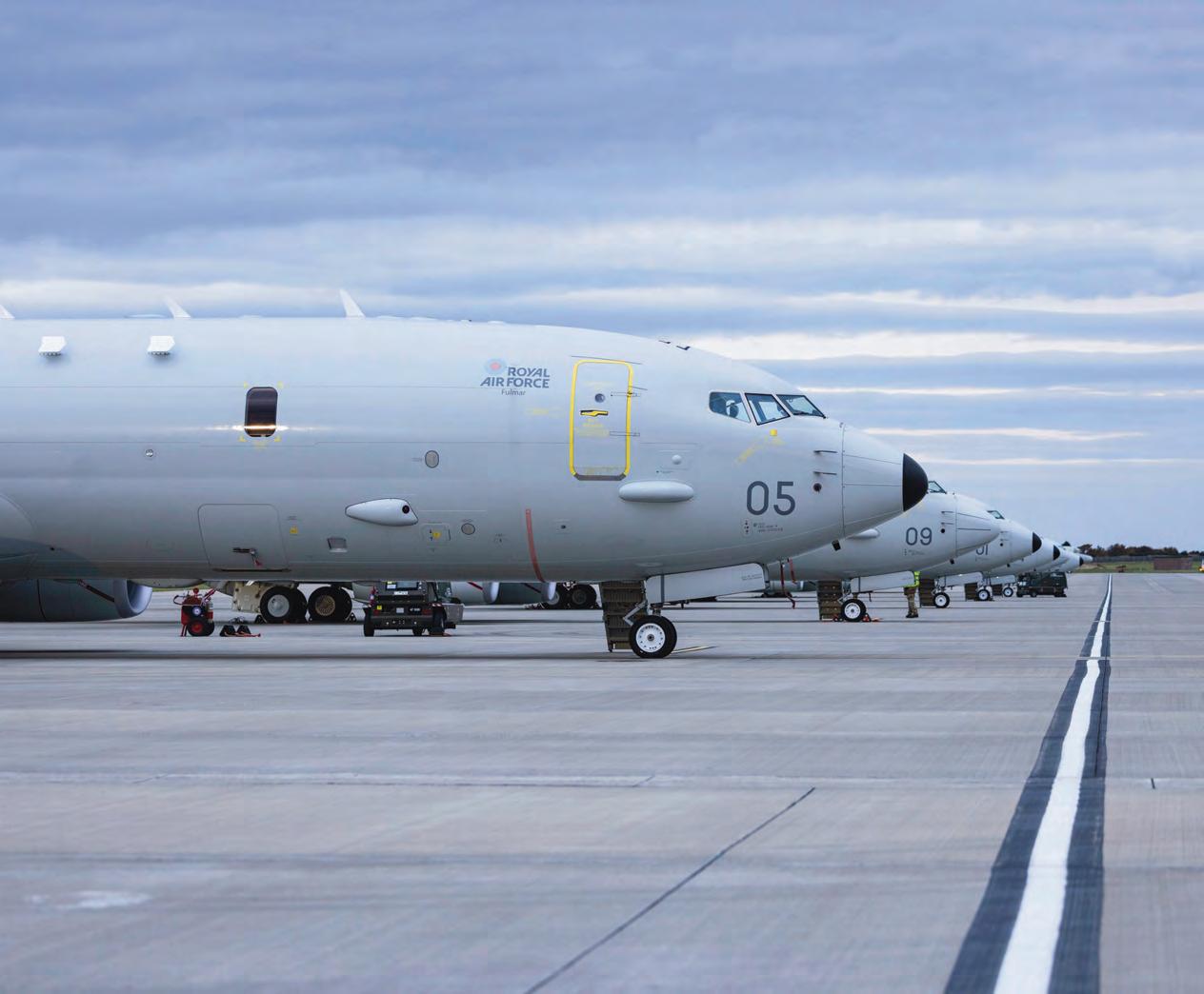
Future infrastructure
Air Commodore Will Dole OBE, Head of RAF Infrastructure, explains the need for understanding, embracing and preparing for the changing character of war, so the RAF’s infrastructure can adapt in time
FRAF must adapt to ghting, and not merely deploying, from its airbases
(PHOTO: MOD/ CROWN COPYRIGHT)
ollowing many years of consolidation and rationalisation, the RAF now operates from 29 locations in the UK, across 400,000 acres. Balancing operational attritional resilience with site optimisation and e ciency (disposals) has been challenging and has, arguably, resulted in too many mission-critical operational eggs in too few infrastructure baskets, many of which host other Top Level Budget (TLB) critical assets.
The Air estate is at the heart of everything the RAF does and is where its people live, work, train, and from where it deploys to ‘ y and ght’ and deliver combat e ect. We must be increasingly prepared to ght from our airbases, given the contemporary threat, and not just deploy from them. The RAF’s infrastructure is a critical enabler to enhancing the delivery of capability, operational e ect and operational resilience. It is essential to readying
capability, strengthening homeland security and making the UK a more prepared NATO partner. Furthermore, it is paramount in supporting our People capability through investment in the whole Force’s quality of life and lived experience. It is a catalyst for recruitment and enhanced output levels and is key to making our workforce want to remain in the RAF, so retaining and maximising the talent that exists within our Service.
Infrastructure challenges
The RAF’s infrastructure needs to be resilient to Global Strategic Trends (GSTs) and provide the operationally resilient air eld operational prep, launch, sustain and recovery for our Future Operating Environment (FOE). This means addressing a number of threats, including potential attacks by adversaries and hostile actors, and the impacts of climate change and the transition from fossil fuels.
More than half of the RAF’s infrastructure is over 50 years old. As a consequence, much of it is fragile and not t for purpose. This is both a threat and an opportunity as we evolve our airbases to become climate, energy, water and resource operationally resilient.
Learning from the Balkans, Syria, Ukraine, Gaza and other con ict areas, and being self-aware of our own operational tactics, we must assume an adversary will soft-cyber and hard-kinetic attack our energy, transport and communications infrastructures. Likewise, an adversary will target our key command, control, communications, computers, intelligence, surveillance, target acquisition and reconnaissance (C4ISTAR) sites and capabilities
to attrit our operational brain, eyes and ears, and combat-e ect delivery sites to disable us.
The UK Ministry of Defence’s Global Strategic Trends: Out to 2055 highlights four global trend risk areas that are related to our infrastructure and will adversely impact on our FOE and ability to continue to ‘ y and ght’ to deliver decisive operations if not mitigated and adapted to: climate change will cause more extreme weather events and rising sea levels globally; the pollution and degradation of the environment will increase; food and water insecurity will become increasingly prevalent; and climate change and technological advances will open up access to new regions, domains and resources.
There is an urgent need to evolve our airbases to become climate-impact resilient. We must harness the technologies being developed to mitigate climate change in order to increase our e ectiveness in terms of operational resilience and energy security advantage. We must also provide energy, water and resource mission-critical and self-su cient infrastructure to support o -grid operations and dispersed operations for Transition-to-Con ict advantage.
Investment choices
The Chief of the Air Sta ’s (CAS’s) three highest infrastructure priorities are to provide a safe and legally compliant estate, Air eld Operating Surfaces (AOS), and Single Living Accommodation (SLA). Our AOS, and mission-critical support services and buildings are crucial for us to be able to ‘ y and ght.’ Our accommodation must meet the needs of today and, in a changing climate in decades to come, is
Future adversaries are likely to prosecute cybersecurity and kinetic attacks on the UK’s critical national infrastructure, such as power stations (PHOTO: SN THOMAS PHOTOGRAPHY/ SHUTTERSTOCK)
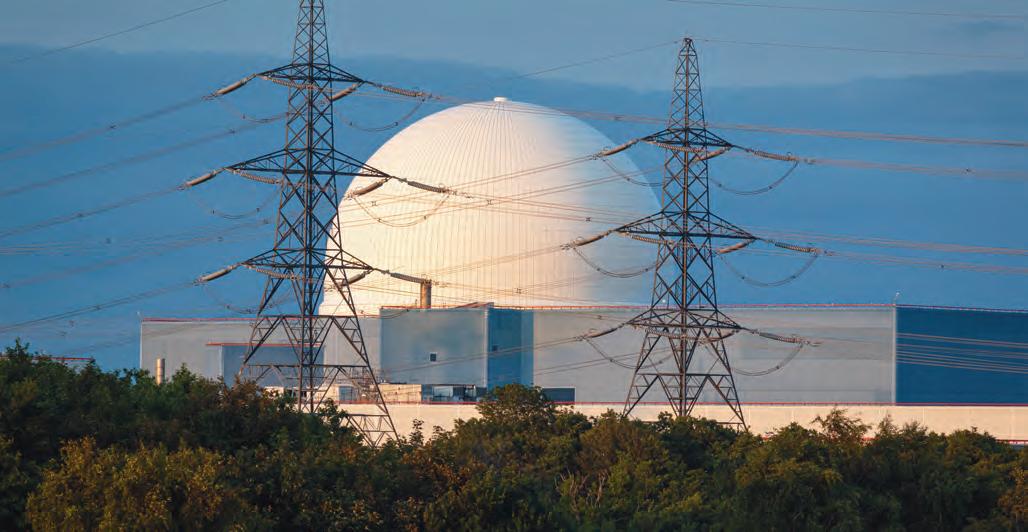
Secretary of State for Defence
the Rt Hon John Healey MP visited RAF Northolt’s Service Family Accommodation (SFA) in December 2024 to highlight the current issues surrounding service housing
(PHOTO: MOD/ CROWN COPYRIGHT)
a signi cant factor in the quality of life for military personnel. We must assume our main bases and their critical assets are on an adversary’s target list. Therefore, we need to be resilient to infrastructure attrition.
Infrastructure investment choices in support of Transition to Con ict need to be considered that will drive the RAF’s readiness to be globally deployed and ready to ‘ y and ght’, and also in support of estate resilience. This is in order to ameliorate the immediate strategic-level risks or vulnerabilities across the RAF estate, such as mission-critical accommodation, AOS, technical accommodation, fuels infrastructure and power provision/resilience.
This work includes developing choices to provide a resilient, a ordable and sustainable estate through modernising, upgrading and climate-adapting our xed estate (decarbonising heating and hot water, sustainable power generation, building fabric updates to improve the e cacy of sustainable heating solutions), and delivering operationally resilient and energy self-su cient sites and capabilities.
Undertaking this work increases our resilience to attack and provides operational advantage. This could mean moving away from the traditional ‘build and operate’, in a permanent building, to an ‘operate
and deploy’ and ‘Capability in a Box’ concept, where mission-critical functions operate in peace and con ict from modular, scalable energy-e cient buildings/ISO containers. In con ict, or in any air eld denial scenarios, we need the ability to deploy to both well-found and austere ‘pop-up airbases’ with transportable mission-critical accommodation.
Modernising support
Other potential investment choices centre around accelerating the improved condition of SLA across the Air estate; future estate rationalisation opportunities; and exploiting sites previously designated for disposal for operational resilience advantage. We will have choices to improve and modernise support to our future airbases, including being clear on what infrastructure assets we can declare to NATO.
Dealing with GST and FOE challenges and risks provides opportunities to make our airbases truly operationally resilient and provide the qualityof-life accommodation required of a modern air force and its workforce. However, we have to plan, design and deliver in a quite di erent way through an FOE and Transition-to-Con ict lens, enabling a ‘ y and ght’ operational mindset and climateand energy-resilient Infra delivery model.

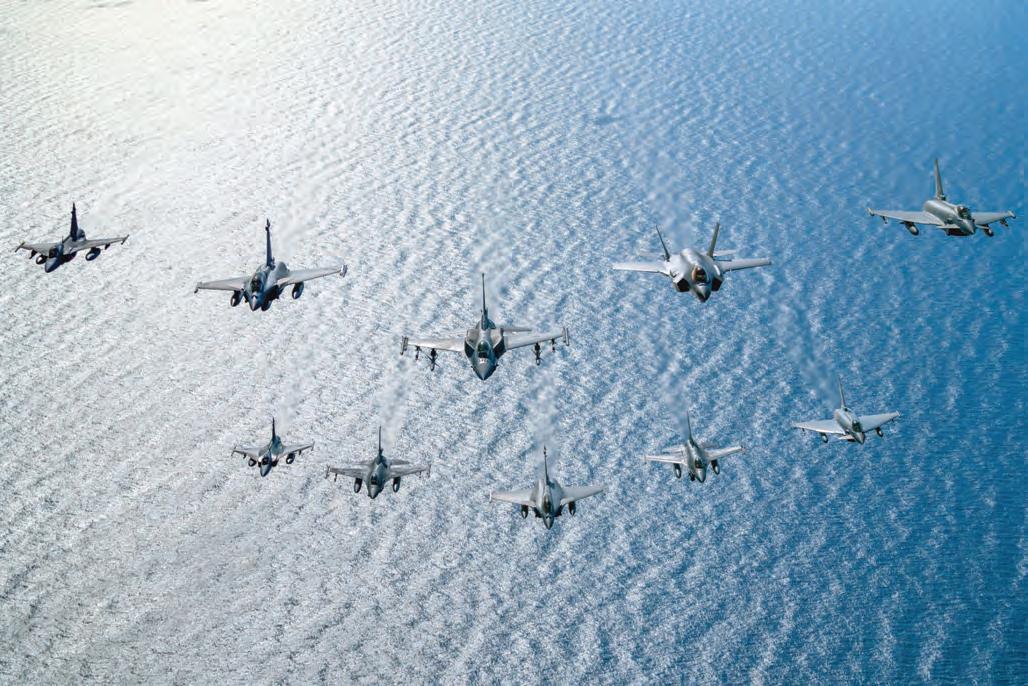
Ramstein Flag
In October 2024, RAF Rivet Joint ISR aircraft and associated personnel gathered in Greece to take part in a rst-of-its-kind exercise called Ramstein Flag. Deputy Commander NATO Allied Air Command, Air Marshal Sir John Stringer, describes the purpose, ambitions and outcomes of this new series
The Vietnam War was a searing experience for the United States and for US Airpower. It was the catalyst for Top Gun for the US Navy; for the United States Air Force, one of the most important consequences for tactical and operational capability was the creation of the Red Flag exercise programme. This year marks the 50th anniversary of the rst exercise at Nellis Air Force Base, Nevada, in late 1975. It is without doubt the most famous and challenging training available anywhere. Fast forward almost 50 years. Russia’s illegal invasion of Ukraine con rmed the 30 years of relative peace in continental Europe was at an end, and that NATO’s nations and militaries would need to rapidly re-adjust to great power competition after two decades of demanding, but narrowly focused,
counter-insurgency operations. For NATO Allied Air Command (AIRCOM), this meant a fundamental review of our contribution and responsibilities for conceptual and tactical development of NATO air power. No small task, but an essential one. Framing our detailed analysis was the early identi cation of ve priority areas: the ability to counter enemy anti-access and area denial systems to ensure all domains had freedom of manoeuvre; integrated air and missile defence to match a rapidly evolving set of threats; resilience, redundancy and capacity in our Air Command and Control (C2) networks; improved information sharing; and enhanced survivability for people and equipment through Agile Combat Employment (ACE). Easy to write and produce in Powerpoint... a little more
Allied ghter jets y in formation during the rst Ramstein Flag exercise in 2024, which was hosted by the Hellenic Air Force (PHOTO: NATO)
“Ramstein Flag has already established itself as providing exceptionally valuable training, including elements of Agile Combat Employment, such as aircraft cross-servicing”
involved in practice. We also recognised that a number of events and activities would need to be established and then executed as a continued cycle: analysis – concept development – experimentation and exercising – validation and implementation.
Weapons and Tactics conference
Alongside the creation of ve lines of e ort within an overall campaign plan, AIRCOM also held its rst ever Weapons and Tactics conference (WEPTAC) in June 2023. WEPTACs are an established and vital element of a number of air forces’ tactical development, following the example of the United States Air Force, but this was ground-breaking in many ways for both AIRCOM and NATO. Key deductions from the two-week event are already being progressed and implemented, and the second WEPTAC – programmed to dovetail with similar national events – will be held in summer 2025, with a particular focus on Air-Land integration and operations.
In parallel, a reinvigorated ‘lessons learnt’ process is ensuring we can assess, discuss and then address technological and operational themes. And to ensure we maximise the human capital to tackle this very broad capability and conceptual portfolio, AIRCOM has created a dedicated Weapons and
Tactics ‘shop’ that is integrated with an Air Warfare Development Team that draws on the capacity and expertise across nations’ air forces. But at some point, you have to test what you think you’ve deduced and prepare your people, hence the opening paragraph’s history lesson. In October 2024 and April 2025, AIRCOM held the rst two high-end NATO air exercises in decades – Ramstein Flag 24 and 25.
Ramstein Flag 24 and 25
The Ramstein Flag (RAFL) exercises shamelessly draw on both Red Flag and non-US exercises and experience over many years. The Hellenic Air Force hosted the inaugural RAFL24, largely from mainland Greece. It was an excellent runout for NATO and nations, with valuable lessons learnt in planning, execution, debrie ng, logistics and connectivity. We were then able to apply these to RAFL25, hosted through the Royal Netherlands Air and Space Force with a central exercise hub at Leeuwarden air base, but with 15 nations operating from a total of 12 bases around central and northwestern Europe, including RAF Typhoons from Lossiemouth and Voyagers from Brize Norton.
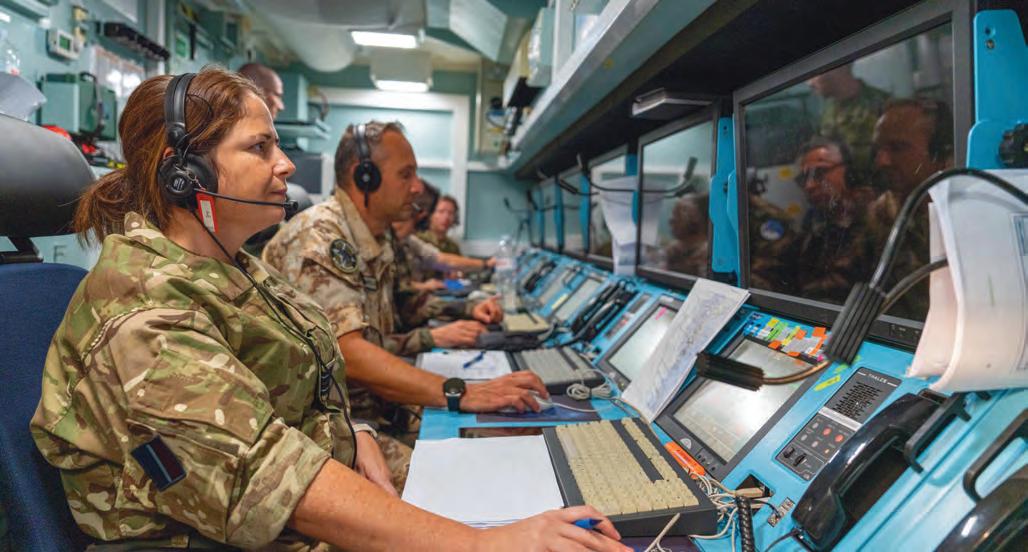
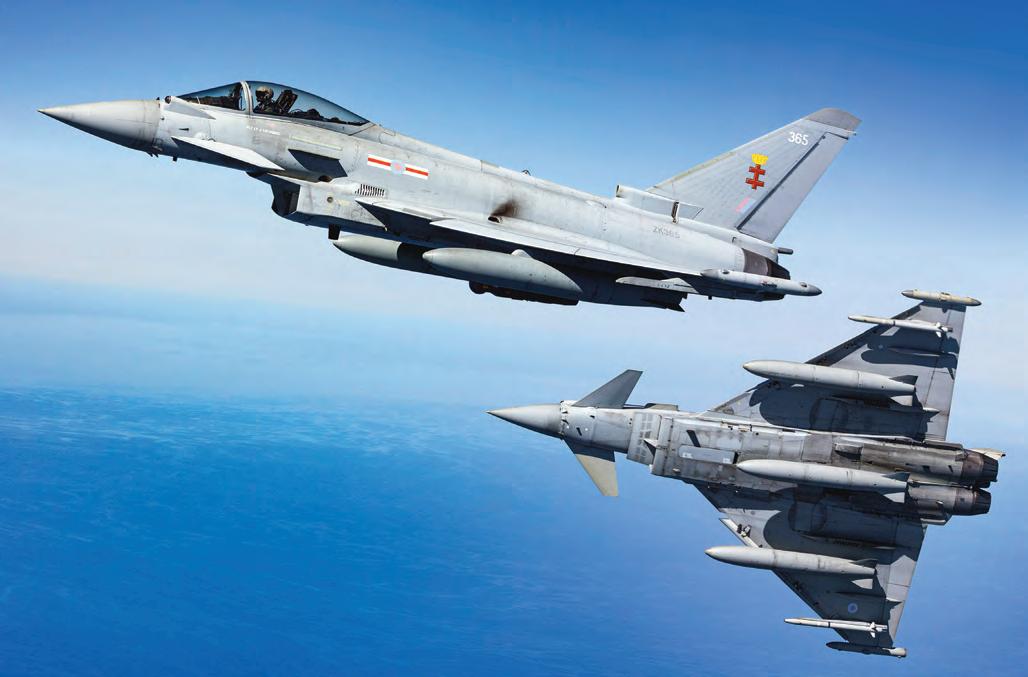
Modern air weapons and their tactical employment need large volumes of (ideally, supersonic) airspace, so this is a prerequisite for live exercises. For RAFL24 this was over the Mediterranean, and RAFL25 used the southern end of the North Sea and the northern Netherlands. We brought together as many enemy weapons systems and emulators as we could, and our sister maritime and land forces were also participating. Red Air is vital too, so nations have contributed fourth- and fth-generation aircraft to provide the necessary threat replication. All of this is largely for naught if you can’t unpack planning and execution, so we have also invested in high-quality ‘White Force’ support to ensure we get every last drop out of the 100+ aircraft participating across daily day and night missions (two a day over a two-week period). We have learnt numerous tactical and operating lessons from both RAFL exercises to date, and these are being folded back into the overall cycle mentioned earlier. What does the future hold? One thing we are unable to replicate (yet) in Europe is the dedicated organisation that runs Red Flag – the 414th Combat Training Squadron at Nellis. However, there is plenty of expertise across nations that will continue to be exploited, and RAFL has already established itself as providing exceptionally valuable training,
including elements of ACE, such as aircraft crossservicing (eg one nation refuelling another nation’s jets at alternative operating bases).
Ramstein Flag 26
For 2026, our ambition is to broaden the exercise across mainland Europe (both real and through simulation), including using synthetics within a Live, Virtual and Constructive model. We will deepen involvement across all domains too – much of modern air power planning and employment is integrated with land, maritime, space and cyber to ensure that the contribution and e ectiveness of all is maximised.
We will also seek to bring in increasing numbers of uncrewed systems where appropriate (which is easier in the virtual world, especially when seeking to replicate scale) and exploit opportunities for both ACE and Air C2 development. Both of these last two priority areas have developed signi cantly over the last few years, and we expect in 2026 to employ what will be the newly established third NATO Combined Air Operations Centre (CAOC) in Norway. In June this year, we used Exercise Ramstein Ambition to accelerate the development of all of our CAOCs – this is another area where experimentation through exercising is now our default setting. Much done, plenty left to do... but no doubts about the urgency and importance.
RAF Typhoon multi-role ghter fast jets participated in Ramstein Flag 25 (PHOTO: MOD/ CROWN COPYRIGHT)
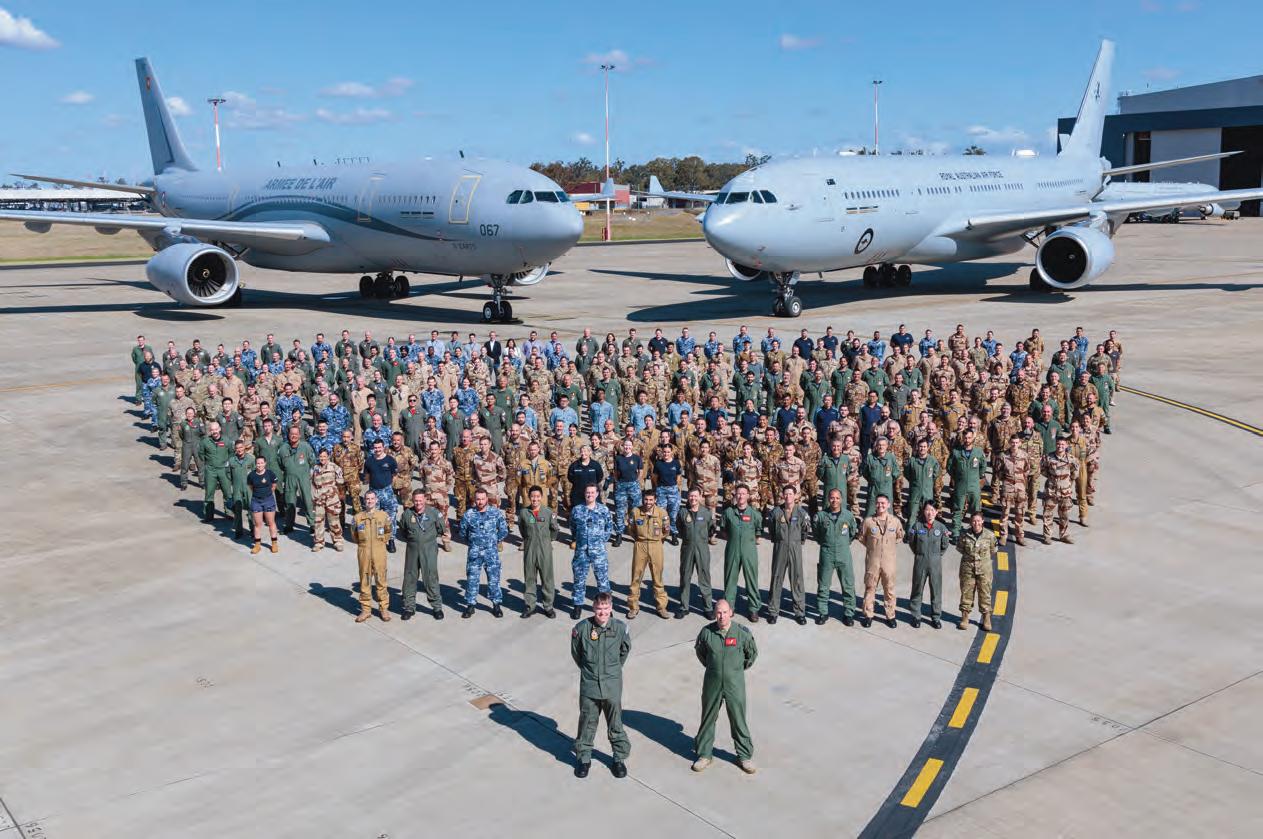
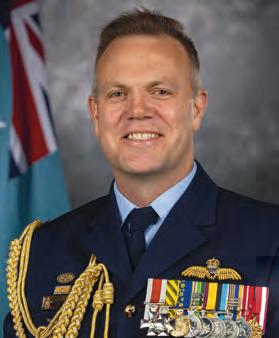
Together –Pitch Black
Exercise Pitch Black is the Royal Australian Air Force’s (RAAF’s) most signi cant ying activity for enhancing its ability to work with overseas partners. The Chief of the RAAF, Air Marshal Stephen Chappell, highlights how the exercise builds strong relationships between aviators and personnel from across the Indo-Paci c region and Europe
Today, we face the most challenging strategic circumstances since the Second World War. We are in a period of strategic autumn. In this context, the threat of entering a strategic winter – a period of great power con ict – exists. However, con ict is not inevitable.
Last year, saw the Government release Australia’s inaugural National Defence Strategy (NDS), and our adoption of a Strategy of Denial. This aims to deter con ict, prevent potential adversaries from succeeding in coercion, support
regional security and prosperity, and uphold a favourable regional strategic balance. Above all else, the strategy is about deterrence.
With deterrence the cornerstone of the NDS, it is important we have a clear idea of what deterrence looks like and where and how it is achieved. The battle for deterrence occurs in the minds of actors who have the power to achieve their goals through force.
We deter by raising doubt – by presenting multiple dilemmas across all aspects of national power as an orchestrated e ect – to make Australia
and our national interests an increasingly costly proposition to attack. Deterrence is multi-dimensional, we must apply the four Cs of deterrence: capability, credibility, communication and comprehension. No singular layer is deterrence in itself.
The Australian Defence Force (ADF) is strengthening our deterrence in numerous ways. We are making unprecedented investments in capability to increase the range and lethality of our ADF. We are also sharpening our force posture, strengthening Australia’s national resilience and focusing our international engagement on enhancing interoperability and collective deterrence.
Through the Strategy of Denial, the RAAF must deliver highly e ective air power as part of an integrated and focused force. It requires deliberate integration and coordination across government, our industry partners and internationally with our allies and partners. This is similar to other international air forces. Speaking last year, of deterrence and the RAF, Air Chief Marshall Sir Rich Knighton said, “This is a team game... We need to build an air force that can y, ght and win today, tomorrow and together.”
Importance of international exercises
While exercises with international partners have always been important, today they are especially so. Exercises are critical to successful force generation, interoperability and demonstrating the e ects of combined air power. Force generation is how our Air Force prepares its people, organisations and
capabilities to make sure we are ready to generate, deliver and sustain highly e ective air power when and where it is required. It is how we prepare for deteriorating trends in the strategic environment, and, in turn, it contributes to deterrence.
Deliver, degrade, disrupt, destroy and defeat
To ght a deterrence mission requires us to posture and train the way we would ght today and iteratively develop how we think we would ght tomorrow. This allows us to demonstrate what we are capable of delivering during crisis and con ict – showing how we can deliver, degrade, disrupt, destroy and defeat.
As the Chief of the RAAF, last year I had the honour of hosting our biggest Exercise Pitch Black to date, with 20 nations bringing 140 aircraft and 4,500 personnel together. Participating countries included France, Germany, India, Indonesia, Japan, Singapore, South Korea, the United Kingdom, the United States and others. We also welcomed, for the rst time, Brunei, Fiji, Italy, Papua New Guinea, the Philippines and Spain. And, an aircraft carrier took part for the rst time, the Italian Navy’s Cavour Held every two years, Pitch Black is the RAAF’s most signi cant international engagement activity. In its 43rd year, the exercise witnessed one of the largest involvements of fourth- and fth-generation aircraft and was also the most diverse for combat aircraft, with 13 di erent fourthand fth-generation platforms taking part.
The Republic of Singapore Air Force brought over its airborne early-warning aircraft based on a Gulfstream G550 (PHOTO: RAAF)
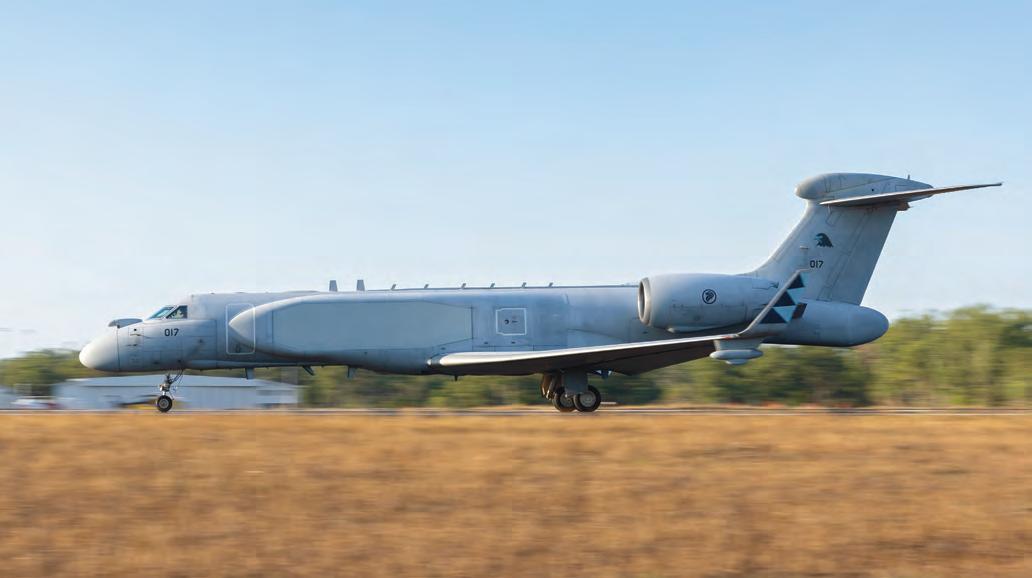
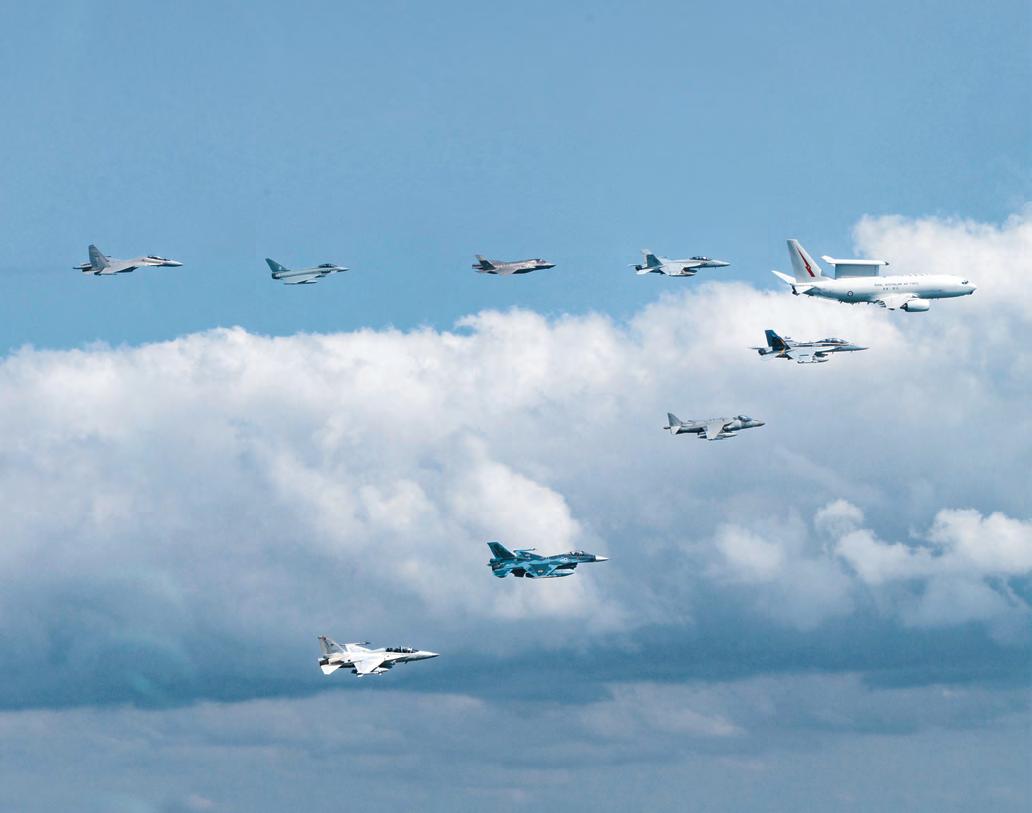
The skies of northern Australia are some of the largest and most unrestricted military training airspace in the world, providing a unique and challenging training environment. With some of the world’s most advanced air combat capabilities taking part, Exercise Pitch Black 24 allowed air forces to practice and rehearse basic ghter manoeuvres through to high-end war ghting, while working side-by-side with partner nations.
The aircraft included the Dassault Rafale, Euro ghter Typhoon, KAI FA-50PH, Mitsubishi F-2, SAAB Gripen and Sukhoi Flanker, as well as the AV-8B Harrier, EA-18G Growler, F-15 Eagle, F-16 Fighting Falcon, F/A-18D Hornet, F/A-18F Super Hornet, F-22A Raptor and F-35A and B Lightning II.
An international commitment
The involvement of so many countries, from our neighbours through to partners on the other side of the world, demonstrates our valued friendships and our shared commitment to global security and regional stability. It was also an opportunity to enhance preparedness and demonstrate collective deterrence.
The exercise allowed nations to validate tactics, integrate systems and ne-tune logistics across distance and disruption. It also allowed commanders to test assumptions, and junior leaders to make realtime decisions in a multinational context. The entire three weeks, and beyond, was an incredible show of how such a diverse array of international partners and platforms can integrate to deliver combined air power.
Exercise Pitch Black 24 also provided a unique opportunity to develop and deepen international friendships. For the rst time in the exercise’s history, the majority of Darwin-based Pitch Black participants were housed in a single location – more than 4,000 Australian and international personnel stayed at the Defence Accommodation Precinct, just outside of Darwin. Australian and international participants ate at the mess together, played sporting games and socialised. Planning is under way for Exercise Pitch Black 2026. We look forward to welcoming back our international friends and partners to once again enhance preparedness, interoperability and demonstrate what we are capable of when working together.
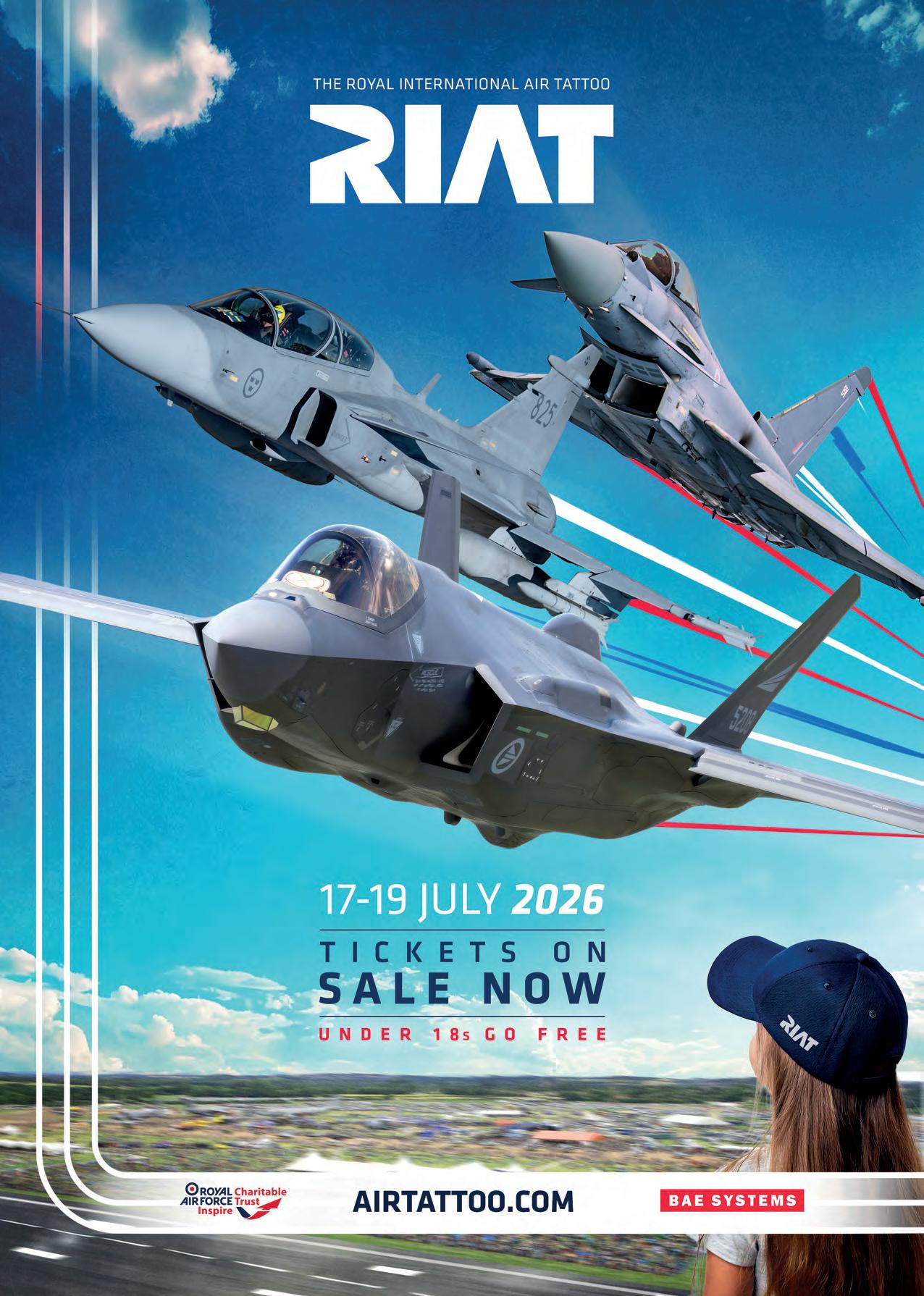
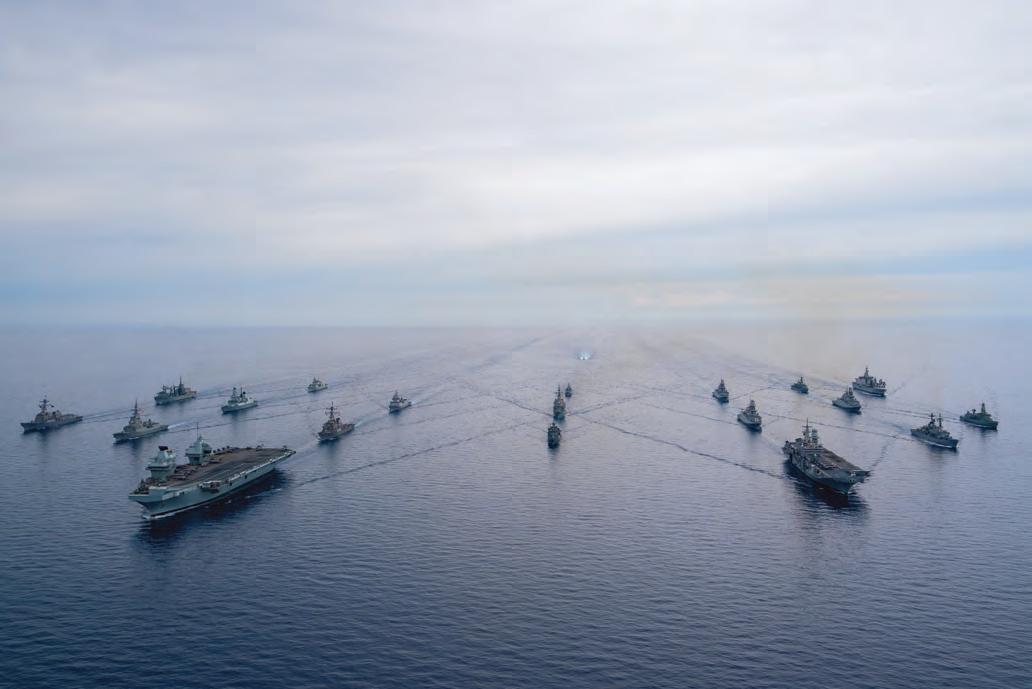
Operation Highmast
INDO-PACIFIC CARRIER STRIKE GROUP DEPLOYMENT
This year, the UK’s Carrier Strike Group 2025 (CSG25), centred on the aircraft carrier HMS Prince of Wales, is deployed as an international force to the Indo-Paci c. Rear Admiral Anthony Rimington explains what the UK and its international partners are achieving with such an ambitious deployment
TOperation Highmast (CSG25) embodies multinational and multi-domain operations
(PHOTO: MOD/ CROWN COPYRIGHT)
he CSG25 deployment, known as Operation Highmast, is the most signi cant planned activity for the Ministry of Defence in 2025. International by design, the deployment brings together UK sovereign capabilities, led by the 1* Sta of the Commander UK CSG, embarked in HMS Prince of Wales, and includes the carrier’s Air Wing and supporting ships and submarines from the UK and international partners, such as Norway, Canada and Spain.
Having set sail in April, the deployment will last for over seven months, ranging from our home waters to focused periods in the NATO region and
stretching to the far reaches of the Paci c Ocean, working with like-minded allies and partners to enhance our capability, and provide security and prosperity bene ts on the global stage.
Operation Highmast will validate Carrier Strike Full Operating Capability (FOC), with two Joint Royal Navy/RAF squadrons of UK F-35B Lightning embarked in the aircraft carrier, operating alongside Merlin and Wildcat helicopters and drones as part of the largest sovereign Air Wing the UK has generated since the 1982 Falklands War. The worldwide deployability and interoperability of F-35 has no equal, and the deployment has already seen the
embarkation of Italian jets on board HMS Prince of Wales, with American jets expected in the coming months. When one considers the thousands of hours of e ort by thousands of people – military or civilian, national or international, front-line or with industry – that have worked together to reach this point, it is both humbling and exciting. It is truly a joint and combined endeavour, bringing people together across the spectrum of Defence activity.
Exploiting exibility at sea
Carrier Strike is at the heart of the nation’s conventional deterrence. The Queen Elizabeth -class aircraft carriers have been designed from the keel up for F-35, and 2025 will be the opportunity to validate this capability at FOC scale. Conceived by the then Labour Government’s 1998 Strategic Defence Review in response to concerns over Access, Basing and Over ight restrictions in the Middle East, Carrier Strike o ers the exibility to exploit the freedom of the seas to act at a time and place of the Government’s choosing.
The deployment plan, developed over the past few years, is based on exercising and operating with several partners, including intensively with NATO allies in the Mediterranean, but also nations in the Middle East, across the Indian Ocean and into the Far East. Participating in the high-level Talisman Sabre exercise in the Paci c, Strike Group operations with Australian and American partners will deliver fthgeneration air power at and from the sea, before then moving to exercise with Japan and Five Power Defence Arrangements nations, among others.
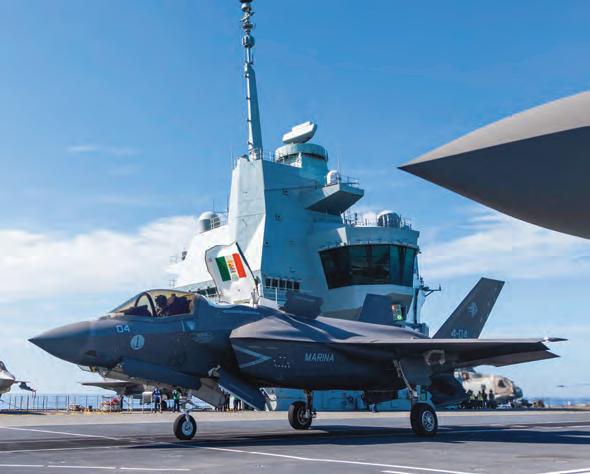
Operation Highmast concurrently promotes multinational Defence partnerships, such as the AUKUS initiative, and supports the Global Combat Air Programme with Italy and Japan.
Yet the core strength of the UK’s Carrier Strike Group rests not in planned deployments, but in its readiness to react in a crisis or war, whether close to home in the North Atlantic or farther a eld. In an increasingly turbulent and troubled world, such a exible and integrated capability, able to move up to 500 nautical miles a day, with all its logistics support and necessary sustainment – and commence multidomain operations on arrival – is vital for Defence.
HMS Prince of Wales will host RAF, RN, Italian (pictured) and US F-35B lightning jets during CSG25 (PHOTO: MOD/ CROWN COPYRIGHT)
The Italian aircraft carrier ITS Cavour (foreground) with HMS Prince of Wales (PHOTO: MOD/ CROWN COPYRIGHT)
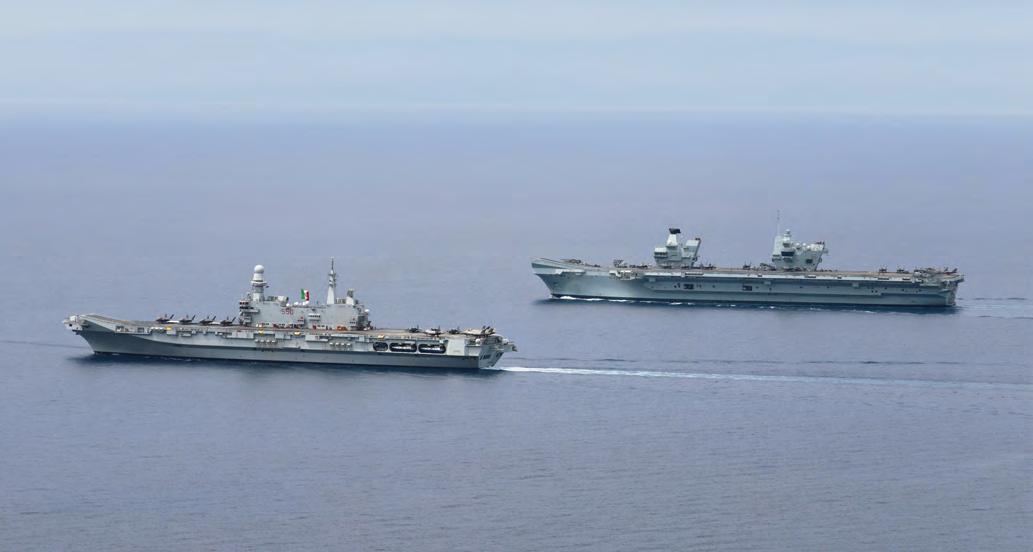
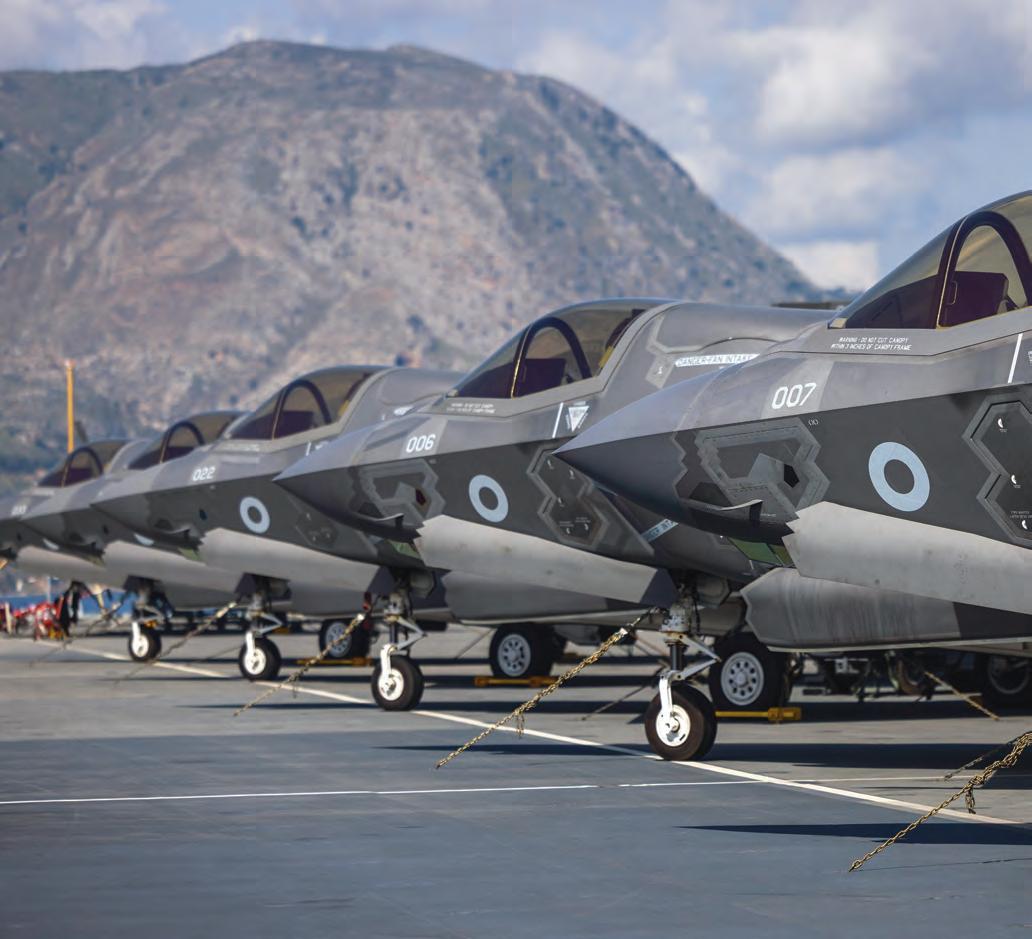
F-35B jets line up on the ight deck of HMS Prince of Wales as the ship arrives in Souda Bay, on the Greek island of Crete, for its rst logistics stop during Operation Highmast (PHOTO: MOD/CROWN COPYRIGHT)
The ability to interoperate with other sovereign or coalition elements is a great strength, integrating across all ve domains. The international nature of this year’s task group showcases this approach. With strained geostrategic situations around the world, the need for such a exible capability has never been more pressing. While much has been said in the run up to CSG25 about the options it provides at reach from the UK, what has perhaps been less well considered is the Carrier Strike Group’s utility closer to home. Historically, in times of increasing multi-domain threat, aircraft carriers have been able to exploit their mobility, and the inherent survivability that brings, to operate across all the roles of air power. In the Euro Atlantic and Arctic they can simultaneously strike and defend, contributing to sea control to protect the vital Atlantic sea lines of communications, being at
the leading edge of Integrated Air and Missile Defence of the homeland, and simultaneously retaining the ability to threaten out anking strike warfare in support of activity ashore.
The embodiment of Agile Combat Employment
The Queen Elizabeth -class aircraft carriers, able to operate cutting-edge fth-generation F-35s with all the specialised support they need – from secure brie ng facilities to weapons magazines, embarked spares to engineering workshops, intelligence facilities to communications systems – are perhaps the apotheosis of Agile Combat Employment. Never in the same place twice, they are also unburdened by the logistics and enablement complications of austere shore bases. As a capability that sits astride the traditional environmental seams of land, air and maritime, the
“The integration of the UK’s Carrier Strike Group into NATO’s developing Regional Plans provides an opportunity to think beyond traditional boundaries”
integration of the UK’s Carrier Strike Group into NATO’s developing Regional Plans provides an opportunity to think beyond traditional boundaries and to ensure that its contribution to air and space power is not seen in isolation, but across all ve domains. This must be a truly multinational e ort, so it is through frameworks such as the UK-US Statement of Intent on Enhanced Carrier Cooperation or the European Carrier Group Interoperability Initiative that we must strive to increase our collective understanding and lethality.
Continuing to evolve
All this shows that, while we should be rightfully proud of Operation Highmast, there will remain much to be done in the years ahead. The threat evolves, and Carrier Strike must evolve too, as
it has done over the past century of providing air power at and from the sea. Developments in Hybrid Carrier Air Wings will see a much more uid integration of crewed and uncrewed aircraft operating at and from the sea, increasing the lethality of F-35 and our helicopters with a range of one-way e ectors and networked sensors.
We must also continue development of lines of e ort across the physical, moral and conceptual elements of Carrier Strike’s ghting power to understand its roles, with whom, where, why and how. By exploiting the access, persistence and poise of maritime forces, linked to the height, speed and reach of air and space power, Carrier Strike can be far more than the sum of its parts, whether now on CSG25, in the coming years or beyond, out to the 2070s.
Both the RAF’s 617 Squadron ‘Dambusters’ and the Royal Navy’s 809 Squadron ‘Immortals’ participated in CSG25 (PHOTO: MOD/ CROWN COPYRIGHT)
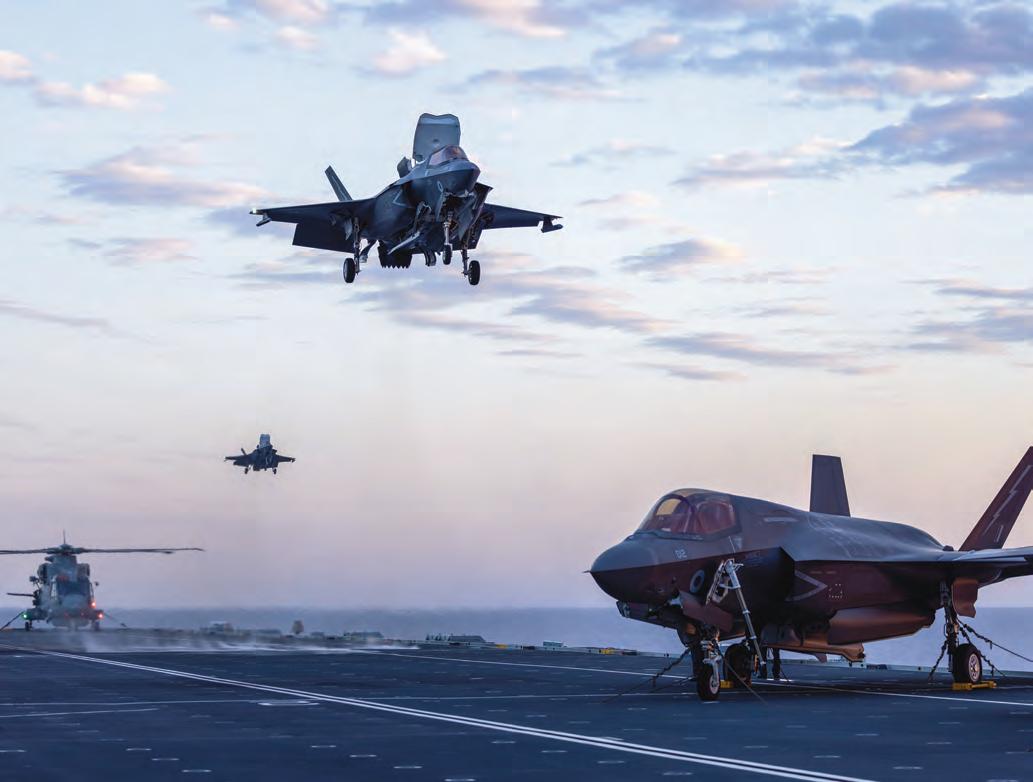
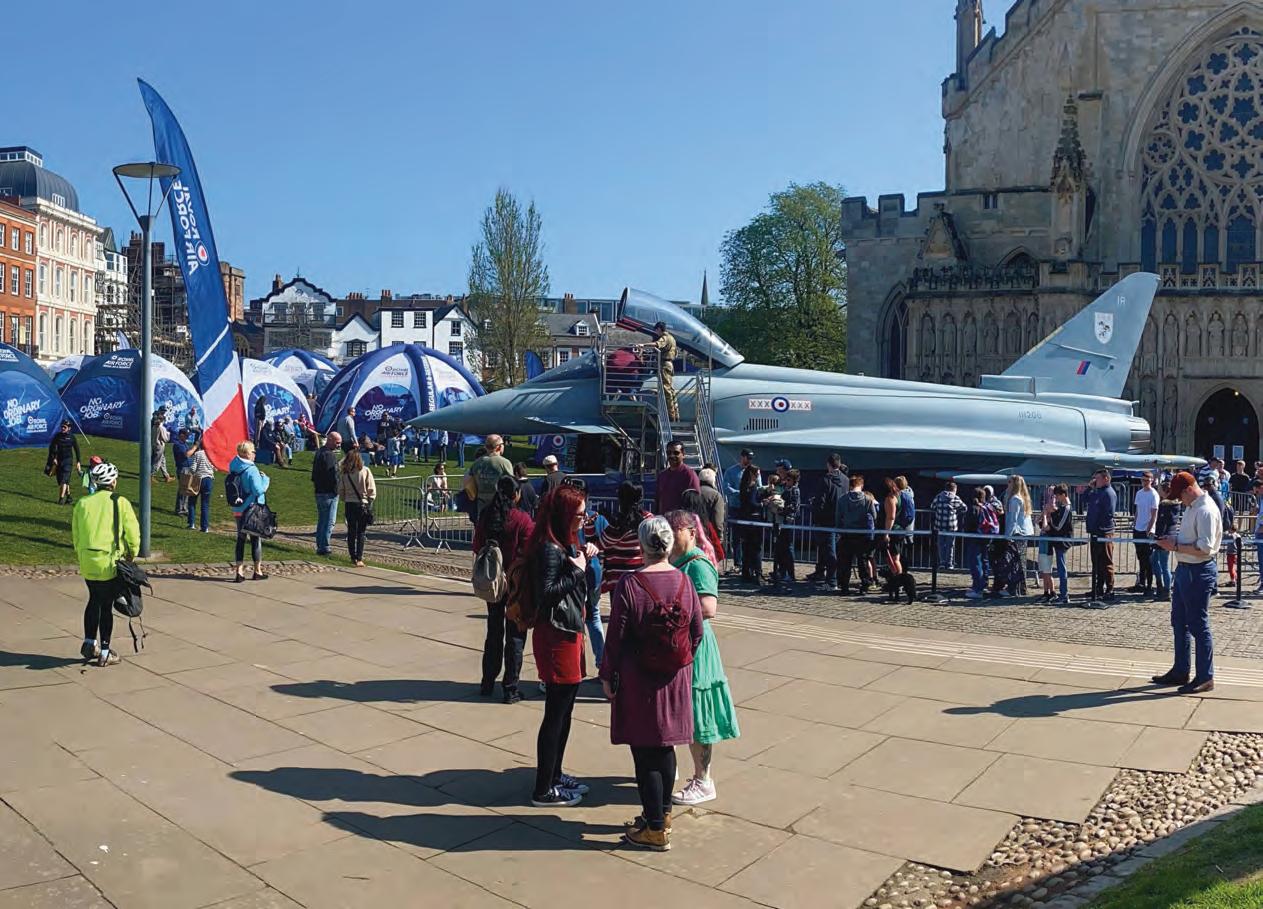
Recruitment and Retention: where next?
The RAF’s Director People and Air Secretary, Air Vice-Marshal Simon Edwards, outlines the impact of changes the RAF has made to Recruitment and Retention processes, and what will matter most going forward
WRAF Engagement
‘Cloudburst’ in Exeter – one of many such events across the UK this year (PHOTO: MOD/ CROWN COPYRIGHT)
hen I wrote for last year’s Air and Space Power publication, I started by saying that our people are our greatest asset. That hasn’t changed. It never will. I went on to say that our numbers were in decline, with not enough people choosing to join us, and too many people choosing to leave. Thankfully, that is changing for the better.
We have been addressing the workforce challenge as we said we would – holistically –and accounting for the entirety of people’s
experiences. Everything from how we Engage to Attract, then Optimise our In ow, and then (and to me most importantly) Value Our People, has been overhauled and brought together, underpinned by better data and insights and better communications; our people function is being transformed.
All of this is moving us in the right direction much more quickly than we thought it would. Expressions of interest to join us have almost doubled. The same goes for the numbers of those people who then become active applicants.
“Our online Recruitment portal has also been overhauled, with entry policies updated to give as many people as possible the chance to join, when hitherto they would have been barred”
This has been made possible through initiatives such as Cloudburst, where we get out among the public in areas where we have been absent, in a coordinated campaign over several days.
Our media e orts are working too. The second series of our Channel 4 documentary, Top Guns: Inside the RAF, has kept interest high at times when it traditionally falls away. It has also done much to bolster pride in those who already serve.
Rercruitment overhaul
Our online Recruitment portal has also been overhauled, with entry policies updated to give as many people as possible the chance to join, when hitherto they would have been barred. Now, for example, you don’t need a driving licence – we can teach you to drive. Likewise, you don’t need to be able to swim – we can teach you that too. Not everybody can a ord those types of things, and so expecting them from all our recruits can exclude
some people at a time when we need to be ever more inclusive. Our focus is on social mobility and o ering opportunity to those with talent and aptitude. That has always been the RAF way.
Increasing number of trainees
We have not treated this solely as a recruitment challenge. There is no point bringing people to our gates if we cannot then let them in and train them, and so Recruit Training has been given the resources it needs. At our initial basic training station, RAF Halton, the courses now typically have 120 trainees, whereas a year ago they had little more than half that number. There are plans in place to deal with this welcome increase in relation to subsequent specialist training and beyond. After all, it is increasing our trained strength that really counts.
This is not, and will not, be easy, but we are on track. As I write, over the past two consecutive months the RAF has been getting slightly larger.
A passing-out parade at RAF Halton. Course attendance for new recruits has almost doubled over the past year (PHOTO: MOD/ CROWN COPYRIGHT)
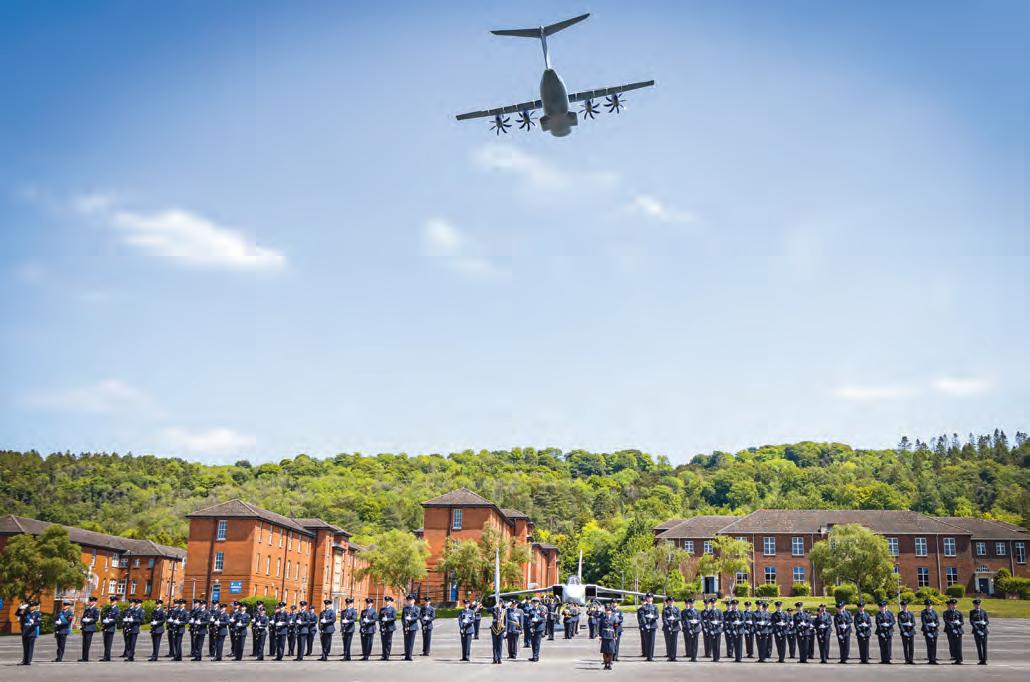
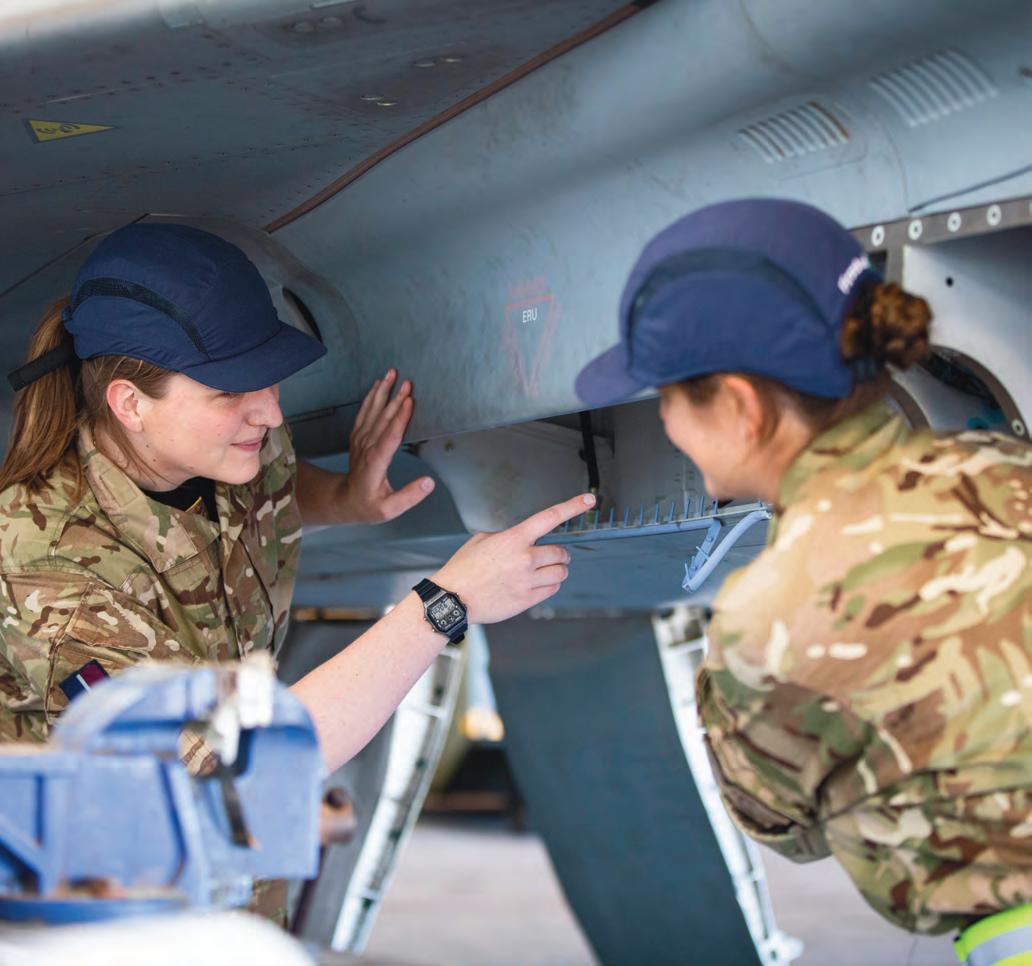
We have not experienced such a continuous rise for many years. We will see dips again, but we have pulled out of the dive we have been in for some years. We now need to climb, and raise our game even further to be back where we need to be. Credit goes to everyone who has played their part – not least those who nd themselves in instructional roles; right now, there is no more an important task. Our e orts to truly value our people matter more than ever. Thankfully, our out ow (the number of people choosing to leave early) has returned to historic norms, confounding independent forecasts. We know that enticements – such as pay awards and restructures; nancial retention incentives; better allowances; childcare, more of a say in future postings; and countless other initiatives – have played a part, but we also
know this area needs constant vigilance and e ort. Our people deserve no less, and we know our ability to retain people is not as strong as we would like. Things like nancial retention incentives are not the sole answer, but they buy us time, and we need to use that time wisely to make our retention more resilient.
Speeding up the recruitment journey
So, what next? We must continue to increase our in ow, o ering more opportunity to more people, and attacking the things that slow down the recruitment journey. We must always treat in ow as a continuum through to the front line, and not chase targets that might overwhelm us. We must do all we can to make our people’s lived experience better and listen to the reasons why
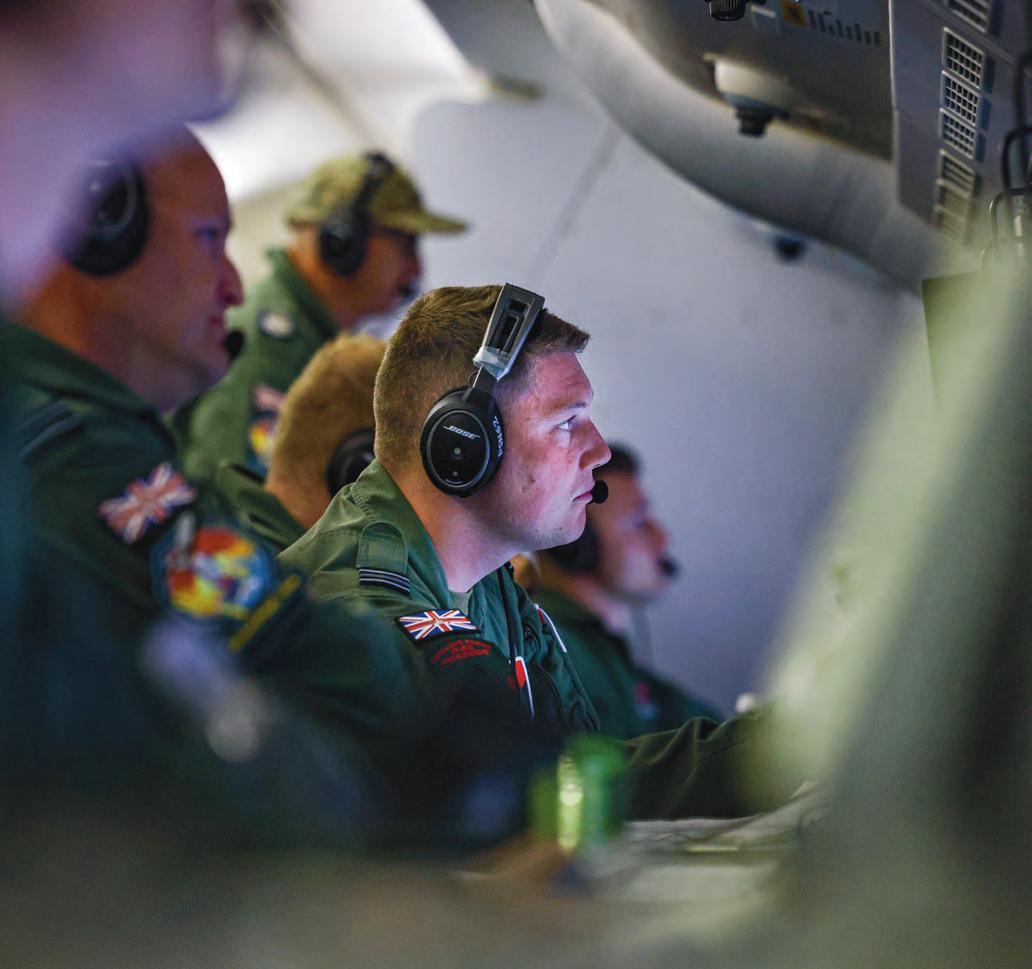
people leave. In my opinion, as we look further ahead there are a few things that will really count.
We must truly embrace the opportunities that our recent move to managing our workforce by Professions brings. Getting this right is fundamental to our people gaining more opportunity to reach their full potential by extending existing skills and experience, and picking up new skills and experiences along the way. Heads of Profession have an evergreater say in what matters to their cohort, what makes them tick and what needs to be done to keep the numbers in their Profession healthy.
Recognising the value of skills
We must value people for their skills. After all, our strength is our people, but their strength is not only their character, dedication and
professionalism; it is their skills that they bring to bear. We need a full picture of where we have skills gaps and how we will ll them. We have come a long way in identifying and capturing where our people skills are, but we need to continue that journey towards being a skillsbased organisation. This a ects everything –from where we focus our engagement and marketing, how we upskill and retrain, and how we structure our pay, to how we look to Reserves and rejoiners, as well as those who follow lateral entry and zig-zag careers.
And when it comes to Reserves, we need to continually challenge ourselves about what it means to serve as a Reserve, and o er more opportunities to do so, in more ways. That is a whole article in itself.
To increase in ow and retention, the RAF needs to o er more opportunity to more people
(PHOTO: MOD/CROWN COPYRIGHT)
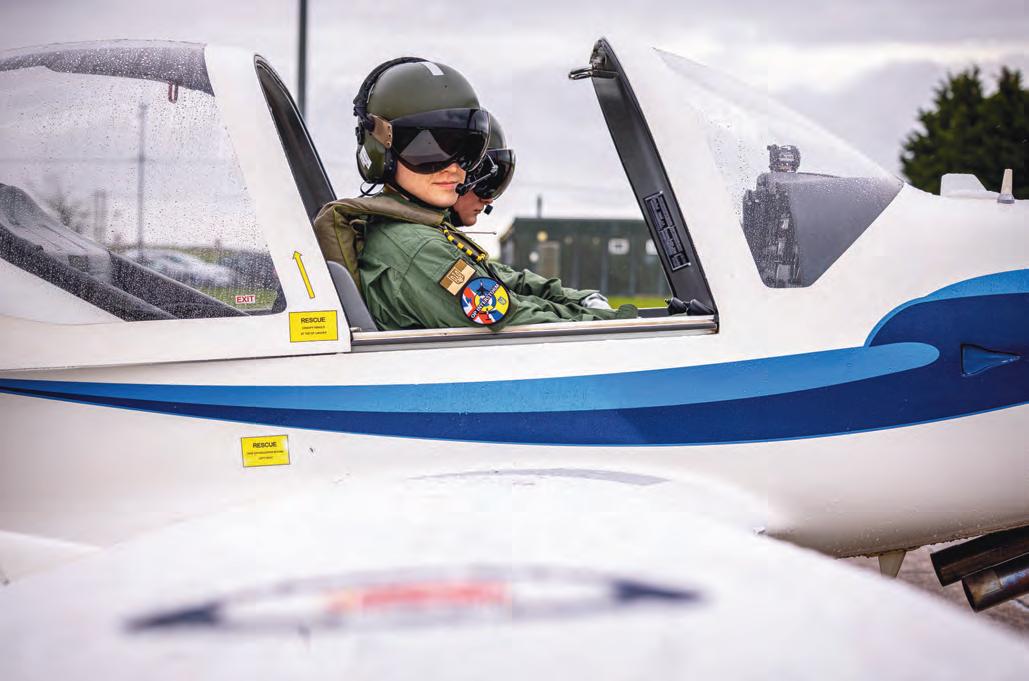
Ukrainian flying training
In March 2024, the rst 10 trainee Ukrainian pilots completed Elementary Flying Training under the supervision of the RAF’s 22 Group. Air Vice-Marshal Ian ‘Cab’ Townsend, the Air O cer Commanding 22 Group describes the training that these pilots undertook and explains the signi cance of the RAF’s continuing support to the Ukrainian Air Force as it seeks to gain control of the air of Ukraine
Since Russia’s illegal invasion in February 2022, the UK has been resolute in its commitment to support Ukraine. The 2023 NATO Vilnius Summit agreed to develop the extant assistance package into a multi-year programme to help rebuild the Ukrainian security and defence sector and transition towards interoperability with NATO.
Part of this was the delivery of a coalition ab-initio ying training pipeline, the rst stage of which was to be delivered in the UK. Under the banner of Operation Interstorm, Number 6 Flying Training School (6 FTS) was tasked to provide a Fast Jet Lead-in course on the Grob Tutor trainer aircraft to rapidly advance and prepare Ukrainian pilots to y the F-16 fast jet multi-role ghter.
The requirement to start Ukrainian training immediately meant there was no time to seek or generate additional resource. This was consequently absorbed by existing capacity within the wider UK military air sector, especially 6 FTS, International Defence Training and the Defence School of Aeronautical Engineering. With considerable experience in the eld of ying training, 6 FTS had the capacity to ful l the task. Importantly, using 6 FTS would not impact the RAF’s Military Flying Training System output.
A course was rapidly developed, which comprised English language training delivered by the Defence School of Aeronautical Engineering, followed by ground-school and ying training,
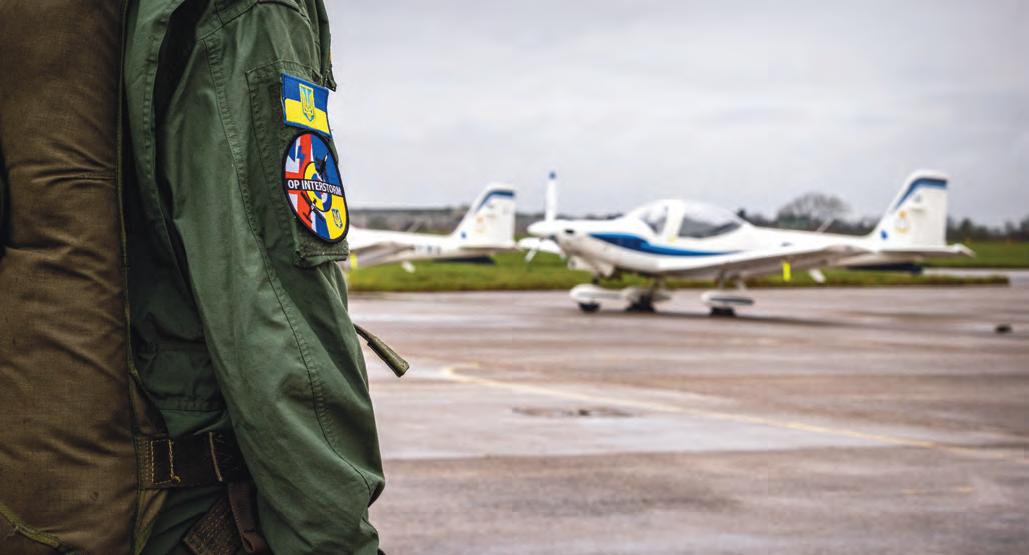
delivered by RAF Quali ed Flying Instructors. For the ying aspects, the excellent relationship with, and enabling support contract from, Babcock International Group was invaluable to achieving success. From the very start, it was obvious that the rapid pace of this project required a exible, Whole Force approach to successfully establish a pathway for the rst course of 10 Ukrainian students arriving in August 2023.
Evolving a bespoke syllabus
Flying training commenced in October 2023 with a syllabus developed from the well-established Tutor Elementary Flying Training and Fast-Jet Leadin syllabi. A bespoke syllabus has since evolved, based on observations from the early courses and feedback from follow-on training partners. The students are taught advanced general handling, instrument ying and navigation, as well as basic and tactical formation, with a particular emphasis on NATO standards to support the strategic aim of future NATO membership – and therefore interoperability – from the earliest possible stage.
The rst pilots graduated in March 2024 and more than 30 have now completed the course in the UK, amassing over 1,500 hours in the air. Close international liaison and collaboration has been key to the programme’s success. Regular synchronisation meetings, led by the US and attended by all Partner Nations, ensures the training pipeline remains coordinated. The multinational F-16 capability coalition safeguards the content, quality and timing of courses, and delivers pilots in the shortest timeframe to meet the required NATO standard.
On completion of their fast-jet lead-in course in the UK, advanced ying training is provided by the French Air Force ying the Alphajet. Multiple bilateral meetings between the French Air Force and the RAF took place to agree input standards, training objectives and an end-of-course standard. These are continually reviewed and re ned to ensure that the output remains relevant to their next phase. In 2025, students will transition to advanced ying training on the L-39 in Canada.
“Close international liaison and collaboration
has been key to the programme’s success”
The rst RAF-trained Ukrainian students completed their Alphajet phase in October 2024 and have completed their F-16 course. Their return to Ukraine will see them make a signi cant contribution to the ‘Control of the Air’ and ‘Integrated Air and Missile Defence’ e orts that are critical to avoiding a prolonged attritional ground con ict. Pass rates have been high, and this success rate is testament to the quality of ying training and the collaborative approach at every stage.
NATO unity remains a key theme for our approach to Operation Interstorm and is demonstrated from the strategic to the tactical level. Common standards across Member Countries have
Training with the RAF took place using the versatile and advanced Grob Tutor aircraft (PHOTO: MOD/ CROWN COPYRIGHT)
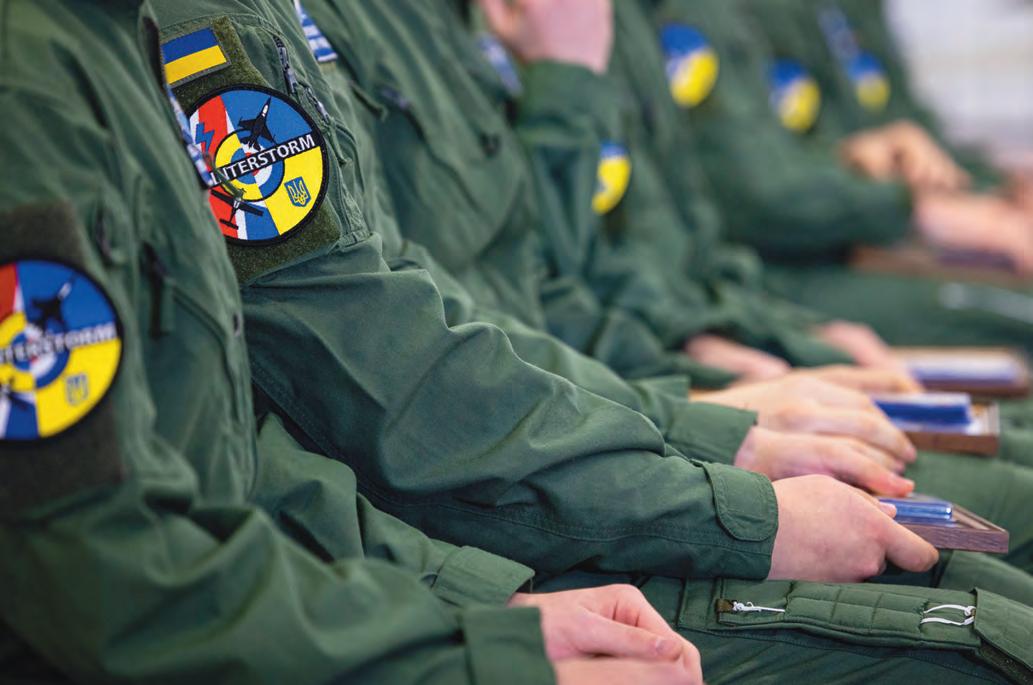
enabled the exibility to rapidly change provision of training and support services to nations with the capacity to deliver it. For example, using the NATO Standardisation Agreement process, another NATO nation was able to provide initial aircrew medical examinations for the training pipeline. Similarly, the UK has delivered English language training to pilots and ground crew before they moved to other NATO nations for their next phase.
Although the focus of Operation Interstorm has been delivering ying training, there has been signi cant additional activity provided by the UK to support capacity growth. Well over 200 pilots, ground crew and mission support personnel have received language training before moving on to other Partner Nations for specialist training. With the task now developed further to include more trainees across a broader spectrum of activity, having su cient personnel to deliver the activity remains the biggest risk.
Language training
In addition, the biggest lesson identi ed thus far is that English language capability is a major factor in students’ progression and success on ying courses. Often arriving in the UK with limited knowledge of English, students have around two months of language training to meet the required standard;
this has proven a huge challenge that requires further teaching for some. The more complex sorties require students to listen, rapidly assimilate information and speak in English. The one failure to date on the Alphajet course attributed language ability as a major factor; consequently, language training is continually adjusted to ensure success.
Ukraine-NATO interoperability
In line with NATO’s objective to transition Ukraine towards full interoperability, and ensuring it will have a central role in shaping its own future, the RAF’s Central Flying School has been closely involved with its Ukrainian counterparts to support the development of a similar training system. Starting with the pilot selection processes, the RAF has gifted Ukraine a computer-based aptitude testing system, and the most recent initiative is investigating options for training Ukrainian ying instructors.
We are constantly striving to improve delivery with the wider capability coalition and to hone the students’ skills to ensure this bespoke ying training pipeline remains an outright success. Through Operation Interstorm, the RAF is continuing the UK’s intent to step up further in its support for Ukraine, to work together to bolster NATO and to secure peace through strength.
Delivering ying training for the UK and NATO

Tim James Managing Director, Ascent Flight Training
What are Ascent’s priorities for Fast Jet training systems and aircraft?
The current UK Military Flying Training System (UKMFTS) Fast Jet solution is somewhat unusual for Ascent. Elsewhere in the system, Ascent, as UKMFTS prime contractor and Training Service Partner, sets the requirements and leads the acquisition of the aircraft, which results in our eet of H135, H145, Texan, Prefect, Avenger and Phenom aircraft. The Hawk T2 was provided to Ascent as Government Furnished Equipment and, unfortunately, has delivered limitations, which impact our ability to generate our full Fast Jet training capacity of 43 students per year.
As other international partners have assessed their future Fast Jet training options, so too has Ascent. Optimising ghter pilot training is a priority, and we have provided the UK’s Ministry of Defence (MOD) with an outline proposal on how
we can modernise the UKMFTS Fast Jet pipeline, creating the onshore sovereign capacity and capability we need to grow and sustain the UK’s frontline Typhoon and F-35 Forces, with potential growth to serve initiatives including NATO Flying Training Europe (NFTE) and Global Combat Air Programme (GCAP).
How can technology assist Ascent with its Fast Jet Transformation programme?
Great question – technology is at the heart of our current transformation programme, which leverages commercial o -theshelf (COTS) technologies to expand and enhance our Fast Jet training service.
“We are open for NFTE business and welcome international partners to our training sites and programmes”
We are implementing enhancements across our suite of Hawk and Texan synthetic devices – working with RAF and Lockheed Martin teams under an Agile project management model. This empowers RAF instructors and technology SMEs to co-develop capability on site and move seamlessly into delivery. It has proved incredibly popular with all involved and we are elding
new capability quicker and cheaper than our traditional waterfall programmes. While Agile might not be appropriate on all our UKMFTS programmes, it’s been invaluable in transformation. We aim to repeat the programme across our other UKMFTS services in the future.
How will Ascent’s NFTEaccredited sites enhance manned and unmanned pilot training across the continent?
Huge thanks to the NFTE team, who have accredited our training programmes across rotary- and xed-wing elements. This means we are open for NFTE business and welcome international partners to our training sites and programmes. We are huge advocates of the NFTE initiative, as NATO partners will jointly bene t through greater collaboration and sharing of scarce training capabilities. With the involvement of industry, it opens the possibility of rapid private-sector investment in additional capacity and capability to serve NATO demand, leveraging both the military and industry in a joint programme.
Can you describe how these innovations will increase the RAF’s ability to interoperate with its allies and partners?
Through the constant investment and transformation of UKMFTS, the UK remains a key strategic partner and leader in NATO ying training, capable of generating fth-generation xed-wing, rotary-wing and mission aircrews, while o ering direct support to partners via initiatives such as NFTE. Ascent is proud to be the UK MOD’s partner in UKMFTS and wider in NFTE.
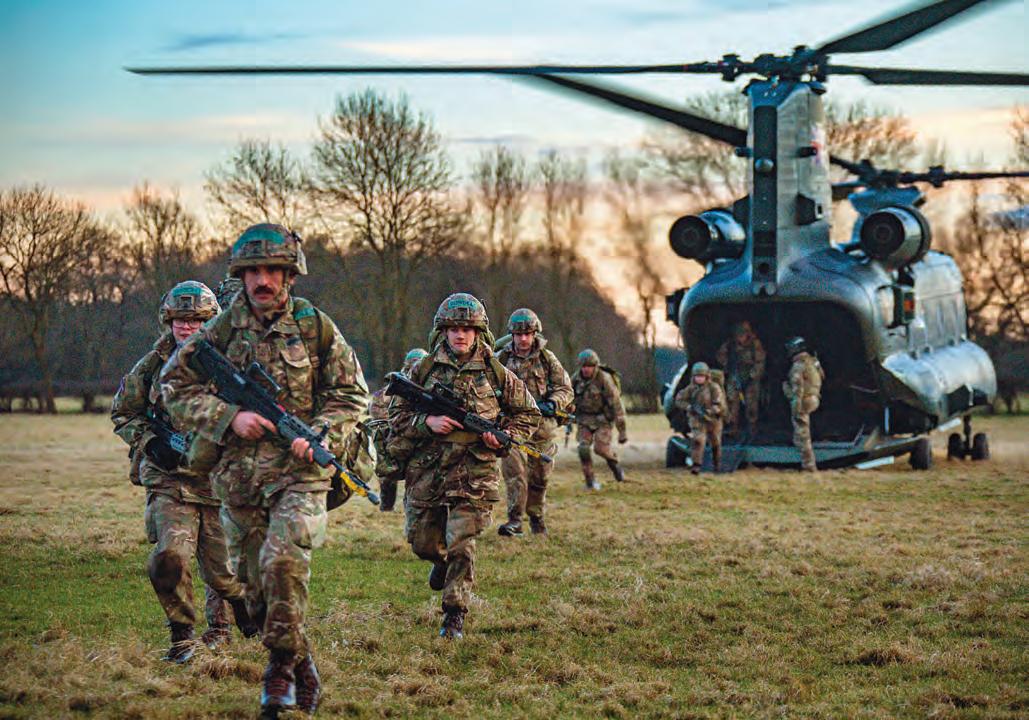
RAF RESERVES AT THE HEART OF THE WHOLE FORCE
A resilient edge
The RAF’s Whole Force Concept sets out a journey to create a seamlessly integrated air and space organisation that comprises regular and reserve aviators alongside a civilian cadre and industry personnel. The steps required to achieve this vision are laid out by Air Vice-Marshal Ranald Munro, Commandant General of the Royal Auxiliary Air Force
TThe RAF Reserves now occupy a central place in the RAF’s Whole Force structure
(PHOTO: MOD/ CROWN COPYRIGHT)
he RAF has always relied on both Regular and Reserve personnel, a Whole Force approach that combines the best of both. In today’s complex global context, this blend of capabilities is more critical than ever. Rapid geopolitical shifts, technological leaps and intensifying security threats require a transformed reserve component that can reinforce the RAF at scale, bring unique specialist skills and add resilience at short notice. Leveraging Active and
Strategic reserves within the Whole Force ensures that the RAF remains credible, agile and ready to ght and win, deterring any potential adversary. These imperatives highlight a strategic demand for greater reserve capacity. Reserves now occupy a central place in RAF planning and delivery, merging seamlessly with their regular counterparts. Drawn from diverse civilian backgrounds, reserves support and enhance the regular force across the full range of Defence
outputs, both routine and contingent, as individual augmentees and formed units. The recent integration of RAF Reserves into the rapid delivery of the Autonomous Collaborative Platforms strategy highlights the e ectiveness of a Whole Force approach to emerging capability development and the nesting of sunrise capabilities within the Reserves.
The reserve opportunity
Harnessing the potential of reserves can enhance air and space power capabilities for the RAF.
Bene ts include:
– Resilience and strength in depth: reserves bring mass as well as specialist skills. A trained workforce pool that can respond to emerging threats;
– Scalability: a framework to increase and augment the war ghting capability of the RAF;
– Flexibility and value for money: reserves can be used how and when required, without being a xed cost;
– Skills: harness and share scarce, in-demand skills from the civilian sector that are often not organically grown within the military.;
– Connection with the nation: the regional, visible face of the RAF across the UK, able to broaden participation in Defence and increase diversity.
The RAF Reserves will grow to the strength directed by UK Ministry of Defence plans and will form a larger part of an integrated workforce, with reservists embedded across RAF units and sta structures. Whether enhancing security forces, intelligence cells or o ering surge support to civil agencies, reserves enable the RAF’s front line to remain robust, versatile and resilient.
Realising this potential requires two essential steps. First, purposeful thinking among senior commanders, professions and workforce planners on how best to use reserve talent for real impact. Second, an explicit operational demand signal specifying the capabilities that the Force expects from its reserves, in what volume and at what readiness. Once these are in place, reserves can be truly integrated into force design.
Leadership and structural enablers
E ective Whole Force integration hinges on frameworks that catalyse change. The Air Reserves Optimisation programme, led by the Reserves Directorate, is building on recent successes such as Reserve Support Wings (RSW), digital and space reserve capabilities and evolving reserve squadron structures to provide a single strategic vision that weaves the reserve’s output into the fabric of the RAF. Working collaboratively with the front-line groups and their own reserve structures, change is gathering pace.
Reserves can o er specialist skills acquired in their civilian careers, tting service around their personal and professional lives (PHOTO: MOD/ CROWN COPYRIGHT)
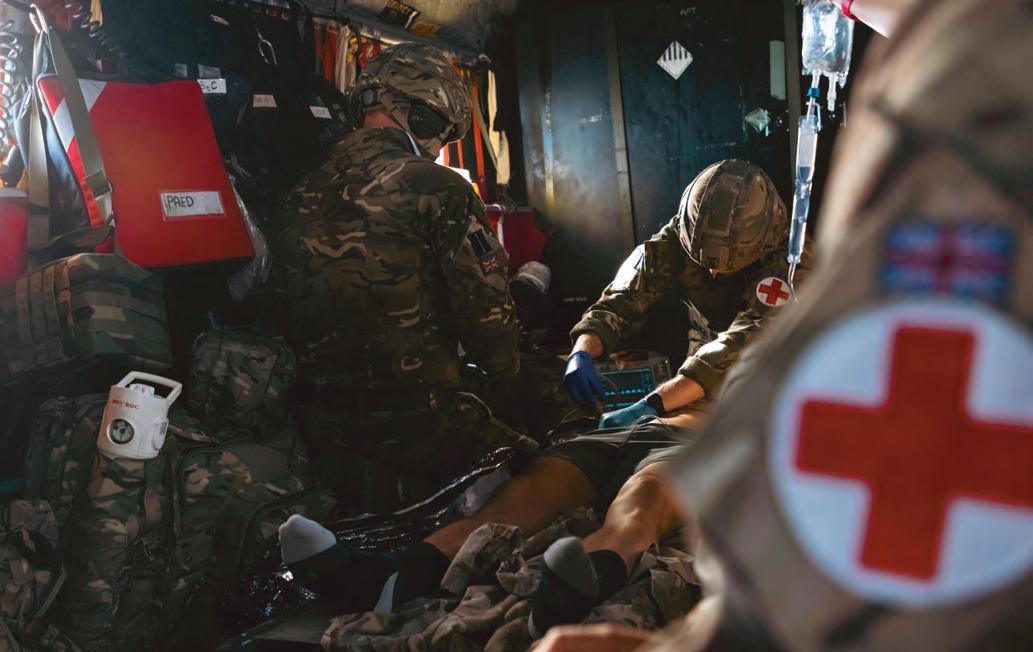
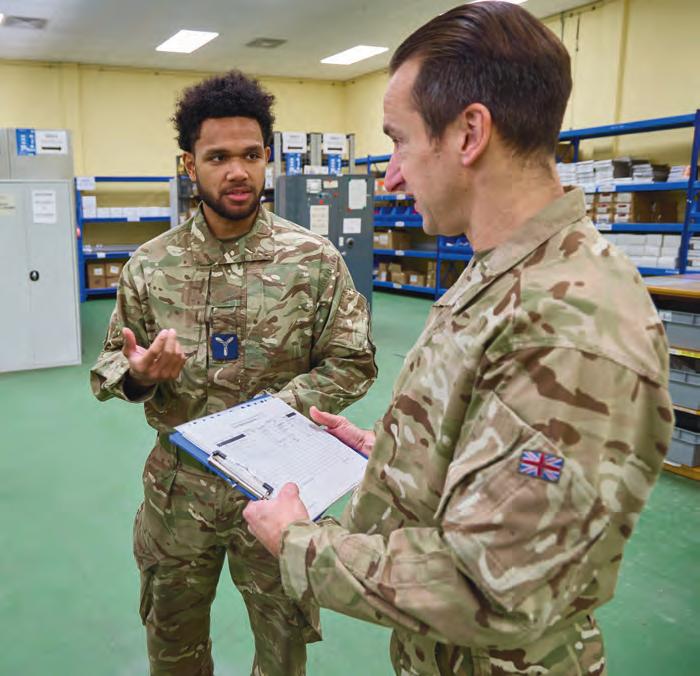
Reservists play a crucial role in supporting the day-to-day operations of the RAF (PHOTO: MOD/ CROWN COPYRIGHT)
Ongoing initiatives show how individuals can be drawn from regular, reserve and civilian components into roles on a short-term or bespoke basis. Whether experts in data analytics or engineering, these specialists can o er targeted, high-value input that complements full-time military capabilities. This underscores the potential of a more uid ‘zigzag’ model of service, where people enter, leave and rejoin as their personal and professional lives evolve – a new concept of a ‘career for life’.
Making policies t for purpose
Good ideas alone do not yield results if procedures, policies and regulations are not equally agile.
A holistic review – encompassing recruitment, medical standards, aptitude tests and terms and conditions of service – must challenge policies that do not deliver on strategic intent or that unnecessarily bar talented people from o ering their service.
Overly rigid or conservative interpretations of policy can sti e initiative. By recalibrating our approach, we empower commanders to accept proportionate risk that aligns with operational realities – command- versus sta -led decisionmaking. This means the right people making the right decisions at the right level. Failing to do so transfers greater risk to the front line.
Transformation through four themes
To drive transformation, the Minister for Veterans and People is focusing on four themes:
– Simplify: streamline processes and structures to make it easier for reservists to apply, train, integrate and contribute e ectively;
– Amplify: enhance visibility and recognition of the vital roles that reserves play within our Armed Forces;
– Scale: expand the capabilities and reach of our Reserve Forces to meet evolving operational demands;
– Mobilise: ensure swift and e ective mobilisation of reserves.
The reserves organisation needs to re-ignite its operational mindset and warrior ethos with a culture that re-invigorates service before self. This must be the measure of e ectiveness.
Engaging employers and society
Success depends on the support of employers and civil society. The key is a value proposition that highlights how reserve service bene ts Defence and enhances employees’ leadership, technical and collaboration skills. Partnerships with industry and academia are central, widening the talent pool from which the RAF can draw. Increased use of Strategic Reserves will place additional burden on employers, and we need to support them to release their people if and when needed.
Engaging the whole of society is essential –a total force mindset where the nation’s defence and security is seen as everybody’s business, not just subcontracted to the Armed Forces.
A sustained campaign footing
To cement these reforms, the RAF must treat reserve modernisation as a sustained campaign with a unifying thread rather than sporadic initiatives. This means secure funding lines, a standing governance mechanism and clear accountability for outcomes. True transformation takes time, but with consistent leadership focus, the reserves can evolve as a relevant, capable and usable component – a force multiplier.
Meeting the challenges of rising strategic competition and rapid technological change calls for fully integrated, agile and valued reserves. By simplifying pathways, amplifying their role, scaling workforce and resources and ensuring swift mobilisation, the RAF can deliver on its promise of a genuinely Whole Force. If harnessed correctly, today’s reserves will be tomorrow’s game-changers, enhancing deterrence, sustaining resilience and guaranteeing the RAF’s edge in an unpredictable world.


